| ☐ | Preliminary Proxy Statement | ||||||||
| ☐ | Confidential, | ||||||||
| ☑ | Definitive Proxy Statement | ||||||||
| ☐ | Definitive Additional Materials | ||||||||
| ☐ | Soliciting Material | ||||||||

| ☐ | Preliminary Proxy Statement | ||||||||
| ☐ | Confidential, | ||||||||
| ☑ | Definitive Proxy Statement | ||||||||
| ☐ | Definitive Additional Materials | ||||||||
| ☐ | Soliciting Material | ||||||||

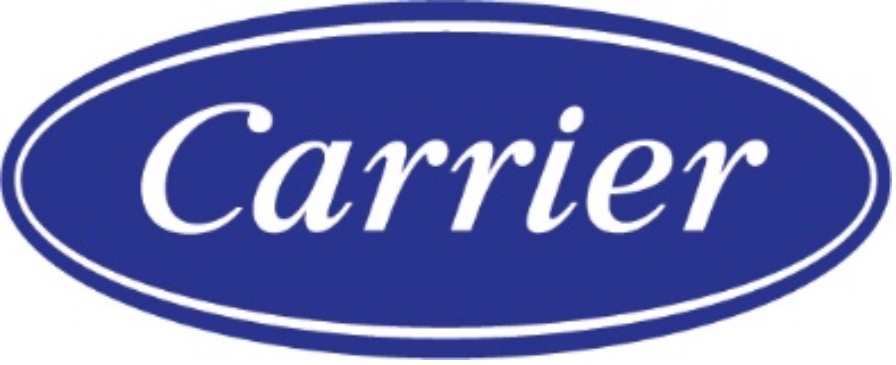
Corporation
| ☑ | No fee | |||||||||
| ☐ | Fee paid previously with preliminary materials | |||||||||
| ☐ | Fee computed on table | |||||||||
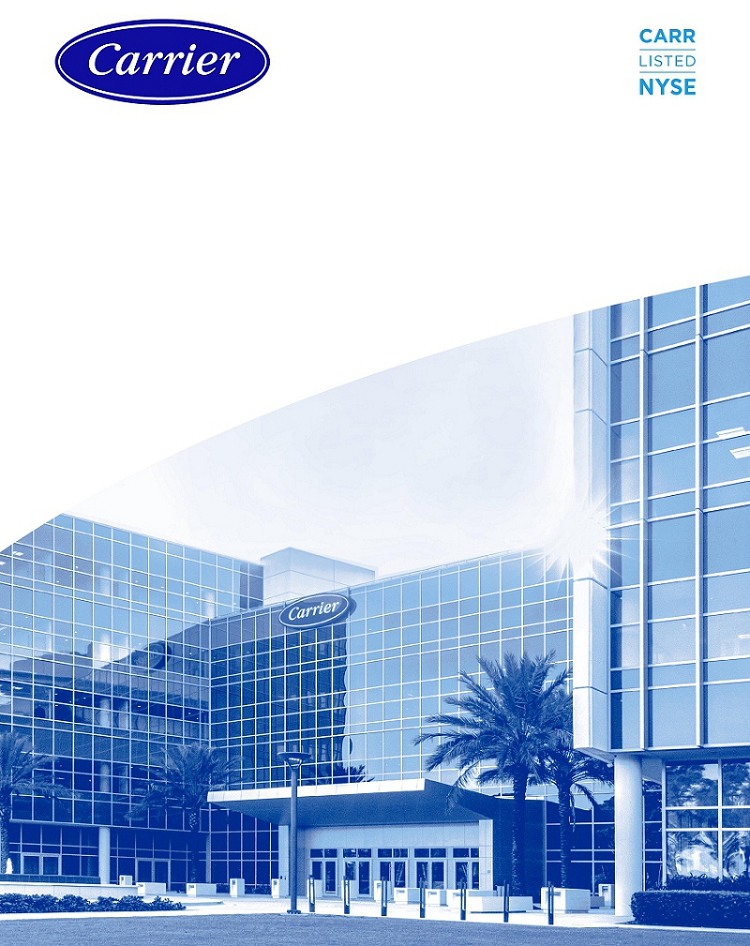
NOTICE OF 2021
ANNUAL MEETING OF SHAREOWNERS
AND PROXY STATEMENT

 |
| Global Leader in Intelligent Climate and Energy Solutions | |||||||||||||
Transformation begins with belief. That innovation can make an impact. That taking care of people means taking care of the planet. That our solutions have the power to improve life today and tomorrow. It is why Carrier | We are Carrier. A global leader in intelligent climate and energy solutions. For people, | ||||||||||||||
In 2020, we launched

VISION Our aspiration; why we come to work every day. Creating solutions that matter for people and our planet. | ||||||||||||||
VALUES | ||||||||||||||
Our absolutes; always do the right thing. Respect Integrity Inclusion Innovation Excellence | ||||||||||||||
CULTURE | ||||||||||||||
Our behaviors; how we work and win together, while never compromising our values. | ||||||||||||||
Passion for Customers | ||||||||||||||
We win when our customers win. | Achieve Results We perform, with integrity. | |||||||||||||
Play to Win | ||||||||||||||
We strive to be #1 in everything we do. | Dare to Disrupt We innovate and pursue sustainable solutions. | |||||||||||||
Choose Speed | ||||||||||||||
We focus and move with a bias for action. | Build Best Teams We develop diverse teams, and empower to move faster. | |||||||||||||
 | Dear Fellow Shareowners, In 2023, Carrier took bold action to simplify its portfolio and accelerate its journey to becoming a pure-play global leader in intelligent climate and energy solutions. With the acquisition of Viessmann Climate Solutions and the planned exit of Carrier’s Fire & Security segment and commercial refrigeration business, Carrier is becoming a more focused company, well-positioned to deliver higher growth and superior value to its shareowners. The Carrier Board shares the management team’s vision of “performing while transforming” and is pleased to welcome Maximilian (Max) Viessmann as our newest director following the successful acquisition of Viessmann Climate Solutions. Max’s groundbreaking vision in digital transformation and deep knowledge of the climate and energy industries will be invaluable as Carrier continues to propel its growth strategy. 2023 was also a transition year for our Board. I began my tenure as Lead Independent Director, succeeding Dr. J.P. Garnier who, fortunately, has agreed to extend his service on the Board until 2025. His extensive global experience and deep understanding of our industry has been and will continue to be invaluable to us during this transformative period. Michael Todman and Virginia Wilson also ably stepped into new roles in 2023 as chairs of our Compensation and Governance committees. I am proud to serve on a board that is so well-positioned to guide Carrier’s management team in its mission to deliver outsized and sustainable value to shareowners. Our Board remains committed to maintaining robust oversight, especially on important governance issues. During the year, responsibility for Carrier's Environment, Social and Governance programs, goals and objectives was elevated to the full Board. This included expanding our disclosures, one of which was our submission to the Carbon Disclosure Project. Additionally, we oversaw the strengthening of Carrier's cybersecurity programs through enhanced public disclosures, external maturity assessments and a formalized governance structure to escalate critical cybersecurity risks and incidents to the Board. To further align the interests of Carrier management with those of its shareowners, we expanded Carrier’s share ownership requirements in 2023 to apply to all members of Carrier’s Executive Leadership Team. Carrier’s transformation is not just about adapting to change; it’s about embracing it. The Carrier Board will continue to help guide Carrier to sustainable, long-term value creation and engage with you, our shareowners, along the way. As shareowners, your trust and support have been instrumental in Carrier’s journey thus far, and we are committed to delivering long-term, sustainable value to you. Sincerely,  John J. Greisch Lead Independent Director | |||||||
"Carrier’s transformation is not just about adapting to change; it’s about embracing it. The Carrier Board will continue to help guide Carrier to sustainable, long-term value creation and engage with you, our shareowners, along the way." | ||||||||
| 2024 Proxy Statement | i | ||||
|
| |||||||||
|
| |||||||||
|
| |||||||||
|
| |||||||||
|
| |||||||||
|
| |||||||||
| Compensation Discussion and Analysis | |||||
| ii | Carrier Global Corporation | ||||
 | March 5, 2024 | ||||
Meeting Information |  | DATE AND TIME April 18, 2024 8:30 a.m. Eastern time |  | LOCATION Virtual Meeting www.virtualshareholdermeeting.com/CARR2024 | ||||||||||
| Agenda | BOARD RECOMMENDATION | READ MORE | |||||||||||||||
| 1 | Election of the Ten Director Nominees Named in the Proxy Statement |  | |||||||||||||||
FOReach Director Nominee | ► Page 11 | ||||||||||||||||
| 2 | Advisory Vote to Approve Named Executive Officer Compensation |  | FOR | ► Page 32 | |||||||||||||
| 3 | Ratify Appointment of PricewaterhouseCoopers LLP to Serve as Independent Auditor for 2024 |  | |||||||||||||||
| FOR | ► Page 63 | ||||||||||||||||
| 4 | Vote on the Shareowner Proposal set forth in the Proxy Statement, if properly presented | 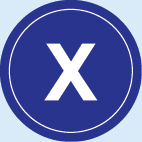 | |||||||||||||||
| AGAINST | ► Page 65 | ||||||||||||||||
| Four voting methods are available to you. |  | BY THE INTERNET Visit the website on your proxy card. |  | BY MAIL Sign, date and return your proxy card in the enclosed envelope. | ||||||||||
| Please review your Proxy Statement and vote in one of the ways described here. |  | BY TELEPHONE Call the telephone number on your proxy card. |  | ONLINE DURING THE MEETING Vote online during the meeting by going to: www.virtualshareholdermeeting.com/CARR2024. | ||||||||||
Your vote is important. Please submit your proxy or voting instructions as soon as possible. | WHO MAY VOTE You are entitled to receive this Notice and to vote at the Annual Meeting if you owned shares of Carrier common stock at the close of business on February 27, 2024 (the record date for this Annual Meeting). VIRTUAL MEETING FORMAT The 2024 Annual Meeting of Shareowners will be conducted in a virtual format to facilitate attendance and to provide a consistent experience to all shareowners, regardless of location. The format is designed to ensure a level of participation commensurate with an in-person meeting and allows shareowners to: ▪vote and submit questions in advance of the Annual Meeting; and ▪access a live webcast, vote and submit questions during the Annual Meeting on April 18, 2024. Please see "Frequently Asked Questions About the Annual Meeting" on page 68 for more information about participating in the virtual meeting. By Order of the Board of Directors. Francesca Campbell Vice President, Corporate Secretary | ||||
| 2024 Proxy Statement | 1 | ||||
| Proposal | Board Recommendation | Page | ||||||||||||
| Proposal 1 | Election of the 10 Director Nominees Named in the Proxy Statement | VoteFOR each director nominee | ||||||||||||
| Proposal 2 | Advisory Vote to Approve Named Executive Officer Compensation | VoteFOR | ||||||||||||
| Proposal 3 | Ratify Appointment of PricewaterhouseCoopers LLP to Serve as Independent Auditor for 2024 | VoteFOR | ||||||||||||
| Proposal 4 | Shareowner Proposal – Transparency in Lobbying | VoteAGAINST | ||||||||||||
| Election of Directors | |||||||||||
What are you voting on? At the 2024 Annual Meeting,10 director nominees are to be elected to hold office until the 2025 Annual Meeting and until their successors have been elected and qualified. | All nominees are current directors of Carrier and were elected by shareowners at the 2023 Annual Meeting, except for Max Viessmann who joined the Board in January 2024. | ||||||||||
 | Our Board recommends a voteFOR each nominee | ||||||||||
 | Jean-Pierre Garnier, 76 Former Chief Executive Officer, GlaxoSmithKline plc Director Since: 2020 Other Current Directorships: Cellectis S.A. |  | Susan N. Story, 64 Former President & Chief Executive Officer, American Water Works Company, Inc. Director Since: 2023 Other Current Directorships: Dominion Energy, Inc., Newmont Corporation | |||||||||||
 | David L. Gitlin, 54 Chairman & Chief Executive Officer, Carrier Global Corporation Director Since: 2020 Other Current Directorships: The Boeing Company |  | Michael A. Todman, 66 Former Vice Chairman, Whirlpool Corporation Director Since: 2020 Other Current Directorships: Brown-Forman Corporation, Prudential Financial, Inc., Mondelez International, Inc. | |||||||||||
 | John J. Greisch, 68 Former President & Chief Executive Officer, Hill-Rom Holdings, Inc. Director Since: 2020 Other Current Directorships: Catalent Inc., Viant Medical |  | Max Viessmann, 35 Chief Executive Officer & Member of the Executive Board, Viessmann Group GmbH & Co. KG Director Since: 2024 Other Current Directorships: Viessmann Group GmbH & Co. KG | |||||||||||
 | Charles M. Holley, Jr., 67 Former Executive Vice President & Chief Financial Officer, Wal-Mart Stores, Inc. Director Since: 2020 Other Current Directorships: Amgen, Inc., Phillips 66, Sunrise Group Holdings, LLC |  | Virginia M. Wilson, 69Former Senior Executive Vice President & Chief Financial Officer, Teachers Insurance and Annuity Association of America Director Since: 2020 Other Current Directorships: Charles River Laboratories International, Inc. | |||||||||||
 | Michael M. McNamara, 67 Co-Founder & Chief Executive Officer, Samara; Former Chief Executive Officer, Flex Ltd. Director Since: 2020 Other Current Directorships: Workday, Inc. |  | Beth A. Wozniak, 59 Chief Executive Officer, nVent Electric plc Director Since: 2021 Other Current Directorships: nVent Electric plc | |||||||||||
| 2 | Carrier Global Corporation | ||||
| Board Nominees | Sound Corporate Governance ▪Regular reviews of strategic direction and priorities ▪Regular reviews of significant risks; active oversight of Enterprise Risk Management ("ERM") program ▪Annual review of Board policies, governance practices and committee charters ▪Annual Board, committee and director evaluations; regular refreshment actions ▪80% of director nominees are independent ▪Robust Lead Independent Director with explicit responsibilities ▪Regular meetings of independent directors led by Lead Independent Director ▪Annual election of all directors ▪Majority voting for directors in uncontested elections ▪Rigorous share ownership requirements for directors and senior management ▪Directors required to hold company-granted equity until retirement ▪Hedging, short sales and pledging of Carrier securities prohibited ▪Eligible shareowners can make proposals and nominate directors through proxy access ▪Shareowners may act by written consent ▪15% of shareowners may call special meetings ▪No supermajority shareowner voting requirements ▪98% attendance at Board meetings in 2023 ▪96% attendance at committee meetings in 2023 | ||||||||||||||||||||||||||||||||||||||||||||||||||||||||||||||||||||||||||||
TENURE 3.3 years average tenure | AGE 63 average age | ||||||||||||||||||||||||||||||||||||||||||||||||||||||||||||||||||||||||||||
7 members on Board since separation from UTC | 3 new Board members in last 3 years | 3 < 60 years | 1 60-65 years | 6 > 65 years | |||||||||||||||||||||||||||||||||||||||||||||||||||||||||||||||||||||||||
DIVERSITY 4 of 10 (40%) Board nominees are diverse 2 of 5(40%) Board leadership positions are held by diverse members Our policy is to build a board representing a broad range of personal characteristics and diversity of perspectives | INDEPENDENCE Our 10-member Board of Directors includes our Chairman & Chief Executive Officer, one additional non-independent director and eight independent directors All independent directors meet the heightened independence standards for our Audit Committee and Compensation Committee | ||||||||||||||||||||||||||||||||||||||||||||||||||||||||||||||||||||||||||||
3 Female (30%) | 1 Racially Diverse (10%) | 8 Independent (80%) | 2 Not Independent (20%) | ||||||||||||||||||||||||||||||||||||||||||||||||||||||||||||||||||||||||||
Susan N. Story Virginia M. Wilson Beth A. Wozniak | Michael A. Todman | ||||||||||||||||||||||||||||||||||||||||||||||||||||||||||||||||||||||||||||
Skills, Experience and Diversity Our director nominees' most significant skills, experience and attributes are highlighted in the following matrix. The matrix is intended as a high-level summary and not an exhaustive list of each director's skills or contributions to the Board. Board committees reflect committee memberships as of the date of this Proxy Statement. | |||||||||||||||||||||||||||||||||||||||||||||||||||||||||||||||||||||||||||||
| KEY SKILLS, EXPERIENCES AND ATTRIBUTES | |||||||||||||||||||||||||||||||||||||||||||||||||||||||||||||||||||||||||||||
 |  |  |  |  |  |  |  |  | BOARD COMMITTEES | ||||||||||||||||||||||||||||||||||||||||||||||||||||||||||||||||||||
| NAME | A | C | G | T | |||||||||||||||||||||||||||||||||||||||||||||||||||||||||||||||||||||||||
| Jean-Pierre Garnier |  |  |  |  |  |  |  |  |  |  | |||||||||||||||||||||||||||||||||||||||||||||||||||||||||||||||||||
| David L. Gitlin |  |  |  |  |  |  |  |  | |||||||||||||||||||||||||||||||||||||||||||||||||||||||||||||||||||||
| John J. Greisch |  |  |  |  |  |  |  |  |  | ||||||||||||||||||||||||||||||||||||||||||||||||||||||||||||||||||||
| Charles M. Holley, Jr. |  |  |  |  |  |  |  |  | |||||||||||||||||||||||||||||||||||||||||||||||||||||||||||||||||||||
| Michael M. McNamara |  |  |  |  |  |  |  |  |  | ||||||||||||||||||||||||||||||||||||||||||||||||||||||||||||||||||||
| Susan N. Story |  |  |  |  |  |  |  |  |  |  | |||||||||||||||||||||||||||||||||||||||||||||||||||||||||||||||||||
| Michael A. Todman |  |  |  |  |  |  |  |  |  |  |  | ||||||||||||||||||||||||||||||||||||||||||||||||||||||||||||||||||
| Max Viessmann |  |  |  |  |  |  |  |  | |||||||||||||||||||||||||||||||||||||||||||||||||||||||||||||||||||||
| Virginia M. Wilson |  |  |  |  |  |  |  |  | |||||||||||||||||||||||||||||||||||||||||||||||||||||||||||||||||||||
| Beth A. Wozniak |  |  |  |  |  |  |  |  |  |  |  | ||||||||||||||||||||||||||||||||||||||||||||||||||||||||||||||||||
| ATTENDANCE | QUALIFICATIONS AND ATTRIBUTES | COMMITTEES | |||||||||||||||||||||||||||||||||||||||||||||||||||||||||||||||||||||||||||
| Directors attended 98% of the meetings of the Board and 96% of the meetings of the committees on which they served in 2023. |  | Financial |  | Knowledge of Company/Industry | A Audit Committee C Compensation Committee G Governance Committee T Technology & Innovation Committee |  | Member | ||||||||||||||||||||||||||||||||||||||||||||||||||||||||||||||||||||||
 | Human Capital Management |  | Marketing/Sales |  | Chair | ||||||||||||||||||||||||||||||||||||||||||||||||||||||||||||||||||||||||
 | Innovation, Digital Technology and Cybersecurity |  | Risk Management/Oversight | ||||||||||||||||||||||||||||||||||||||||||||||||||||||||||||||||||||||||||
 | International Business Operations |  | Senior Leadership | ||||||||||||||||||||||||||||||||||||||||||||||||||||||||||||||||||||||||||
 | Diversity | ||||||||||||||||||||||||||||||||||||||||||||||||||||||||||||||||||||||||||||
| 2024 Proxy Statement | 3 | ||||
the compensation program is to encourage and reward the creation of sustainable, long-term shareowner value. The current elements of the executive compensation program directly align the interests of the executives and shareowners, are competitive, motivate achievement of short- and long-term financial goals and strategic objectives, and align realized pay with performance. Co. KG (“Viessmann Group”). The addition positions Carrier as a digitally enabled, end-to-end sustainable climate and energy solutions provider that addresses all heating, cooling, renewables, solar photovoltaic technology, battery storage and energy management needs for the home and office. In 2023, for the ninth year in a row, we released more than 100 new products. We also have more than 14,000 active patents and pending patent applications worldwide combined. Key Skills and Experience nominated him for election at the 2024 Annual Meeting due to his deep and unique understanding of Carrier's business, industry and growth strategy gained during his tenure as a director of United Technologies Corporation ("UTC"), renamed Raytheon Technologies Corporation ("Raytheon" or "RTX"), and his extensive experience leading and overseeing European businesses. The Board believes that Mr. Garnier's unique perspectives, experience and leadership will be critical as Carrier integrates the VCS Business and completes our announced portfolio transformation. acquisition of the VCS Business. (audit; public policy; sustainability) (people and compensation, chair; governance) (audit, chair Roles website (see page 10). The Board met seven times 2023. 2023. decision-making. Meetings Committee meetings are generally held in conjunction with stated Board meetings, and additional meetings of the Audit Committee rules of the NYSE. pandemics). year. Each committee has primary risk oversight responsibility in the areas that align with its The Board’s Role in Risk Management company’s website. chair of the newly created Technology & Innovation Committee in 2022). 2023. of grant, but settlement does not occur until after a non-employee director leaves the Board. At that time, DSUs are converted into shares of Carrier common stock, distributed either in a lump sum or in 10- or 15-year installments in accordance with the non-employee director’s prior elections. stock ownership requirements discussed under "Share Ownership Requirements" which begins on page 30. NEO Share Ownership Requirements Principal Shareowners We currently hold annual say-on-pay votes, and the next say-on-pay vote will occur at the 2025 Annual Meeting of Shareowners. Executive Compensation Governance Practices The Committee has reviewed Pearl Meyer’s qualifications, independence and any potential conflicts of interest. Pearl Meyer to $1.4 million based on individual performance, market analysis of similar positions within our Compensation Peer Group and input from its independent compensation consultant to ensure appropriate external alignment. Plan. The Committee believes its methodology for determining annual bonus awards accomplishes the following objectives: financial metrics. Payout Calculation the free cash flow target, with overall performance against corporate financial targets resulting in a 143.0% Company Performance Factor. establish rigorous performance metrics that are consistent with the company's long-term strategic objectives communicated to investors, and sets a three-year growth rate target that will challenge our executives to drive results that generate shareowner returns. At the end of the three-year performance period, our NEOs' earned awards are determined based on the level of achievement against this target. was a UTC grandfathered benefit. Change-in-Control Agreements Supplemental Equity Awards. In addition to these clawback provisions, beginning with LTI awards granted in 2022, as a condition to award acceptance (and regardless of whether the award recipient receives any benefits in connection with the award), the Committee requires all LTI award recipients to agree to the following post-employment covenants for the protection of the company: (i) confidentiality; (ii) non-competition; (iii) employee and customer non-solicitation; and (iv) non-disparagement. . These benefits include: share ownership requirements for the CEO, NEOs and non-employee directors. five-year period. The review included compensation strategy Plan-Based Awards Table Outstanding Equity Awards at Fiscal Year-End Table This table reflects awards that relate to Carrier shares. Upon the Separation that occurred on April 3, 2020, vested UTC SARs were 2025 and the number of shares shown assumes maximum-level performance. The three-year performance period for awards granted on February 2, 2022, scheduled to vest on February 2, 2025, is January 1, 2022, through December 31, 2024 and the number of shares shown assumes target-level performance. The three-year performance period for awards granted on February 4, 2021 was January 1, 2021, through December 31, 2023. The number of shares shown reflects vesting at 185.5% based on actual performance at the end of the performance period. The service condition for this award was satisfied on February 4, 2024. Carrier SARs, or vesting of Carrier PSUs or RSUs, during fiscal year 2023. ("PPP") Nelson are the only NEOs eligible for this legacy plan. Mr. Gitlin's benefit under the PPP is composed of both FAE and cash balance benefits, and Mr. Nelson's are determined using the cash balance formula. the accumulated pension benefit: (i) the NEOs are assumed to retire at age 62 for the final average earnings benefit and age 65 for the cash balance benefit, which are the earliest dates at which the NEOs can retire without a reduction of benefits due to age; (ii) projected lump-sum payments under the PPP final average earnings benefit are calculated using 1.962% for 2023 retirements and grading up to an ultimate long- Table Table The equity amounts reflect the applicable unvested portion that would become vested as a result of the identified termination event. a termination due to death, the LTI Plan provides for the accelerated vesting of all outstanding equity awards as of the date of death (including awards outstanding for less than one-year, special out-of-cycle, enhanced annual awards and one-time RSU awards). Equity awards are valued based on the closing price of Carrier common stock on the NYSE on the last trading day of 2023 ($57.45). For SARs that value is based on the difference between the closing price and the exercise price (as long as that value is positive) multiplied by the number of SARs. For the PSU portion of awards, values shown reflect target performance as of December 31, 2023. and Excluded applicable measurement dates to determine the median employee and the associated total annual compensation. and on the effectiveness of the company's internal control over financial reporting. 2024. 2024 several candidates. 2023 and 2022? $7.3 million in 2023 and $6.2 million in 2022. Tax Fees. In Of the $9.8 million, approximately $6.0 million represent non-recurring fees related to work performed to support Carrier's announced portfolio transformation, including legal entity separation activity. In 2022, tax fees included approximately $600,000 for U.S. and non-U.S. tax compliance, related planning and assistance with tax refund claims and expatriate tax services, and approximately $2.2 million for tax consulting and advisory services. Carrier and our shareowners. virtual-only format. 18, 2024. Annual Meeting. All of our directors at the time attended the 2023 Annual Meeting, which was held virtually. How Do I Vote? 17, 2024. How Will My Shares Shareowners are not permitted to vote for a greater number of persons for election as directors than the number of nominees named in this Proxy Statement. legal proceedings or for the purpose of soliciting shareowner votes in a contested proxy solicitation. www.investordelivery.com. writing by 5, 2024 (see page 10). (see page 10). (see page 10). In addition, our 73. Any payments to certain Viessmann Group employees. Free Cash Flow Reconciliation Use and Definitions of Non-GAAP Financial Measures A reconciliation of the non-GAAP measures to the corresponding amounts prepared in accordance with GAAP appears in the tables in this Appendix. The tables provide additional information as to the items and amounts that have been excluded from the adjusted measures. CARR2024 TableAdvisory Vote to Approve Named Executive Officer (NEO) Compensation The Board believes that our compensation policies and practices are effective in achieving the goals of the compensation program, and that our actions have been responsive to shareowner feedback related to last year’s say-on-pay vote. 
ContentsELEMENT PERIOD BASE
SALARYCash One year ANNUAL
BONUSAt-Risk Pay Performance-Based Pay Cash One year LONG-TERM
INCENTIVES
(LTI)Stock Appreciation Rights (SARs)
50%Vest after three years Performance Share Units (PSUs)
50%Vest after three years CEO 2023 Other NEOs 2023 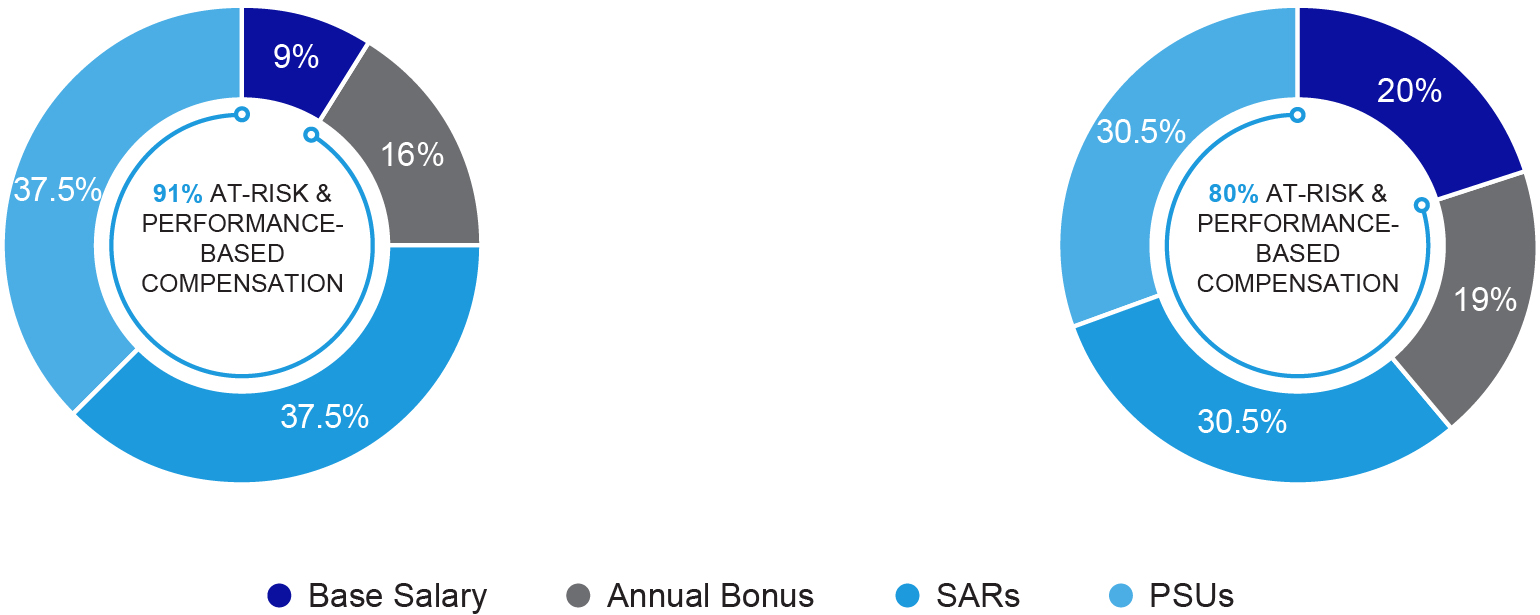
4 Carrier Global Corporation GAAP Adjusted* 









Ratify Appointment of Independent Auditor for 2024 What are you voting on? We are asking our shareowners to ratify the appointment of PricewaterhouseCoopers LLP (“PwC”) as Carrier's independent registered public accounting firm for the fiscal year ending December 31, 2024. The Audit Committee and the Board believe that the continued retention of PwC as our independent auditor is in the best interest of the company and our shareowners. 
2024 Proxy Statement 5 the leadinga global provider of healthy, safeleader in intelligent climate and sustainable building and cold chainenergy solutions, with a diverse and world-class diverse workforce. Through our performanceperformance-driven culture, we are drivingcreating long-term shareowner value by growing salesearnings and investing strategically to strengthen our position in the markets we serve.

Carrier’s HVAC segment providesto meetCarrier is at the forefront of heating, ventilationventilating and cooling needs ofsolutions for residential, commercial and commercialindustrial customers while enhancing building performance, energy efficiency and sustainability.around the world. Through an industry-leading family of HVAC brands, we offer anour global presence, and our innovative and complete portfoliodifferentiated digital solutions, we are transforming the built environment to be more energy efficient, sustainable and autonomous. Our solutions help customers achieve their targeted outcomes, including Abound, which monitors over 1.1 billion square feet of products, including building automationspace to help improve indoor air quality, and servicesenhance occupant comfort and productivity.
help optimize indoor environments to enhance human health,provides customers with enhanced visibility, increased connectivity and actionable intelligence across their cold chain operations.
productivity.
The OptiClean Dual-Mode Air Scrubber & Negative Air Machine was named as onesecurity needs, from the most complex jobs to the simplest conveniences. We offer a comprehensive suite of TIME’s 100 Best Inventions of 2020.6 Carrier Global Corporation 
RefrigerationCarrier’s Refrigeration segment provides a healthier, safer and more sustainable cold chain through the reliable transport and preservation of food, medicine and other perishable cargo. Our refrigeration and monitoring products, services and digital solutions strengthen the connected cold chain and are designed for trucks, trailers, shipping containers, intermodal applications, food and beverage retailers and warehouse cooling.
Carrier and Amazon Web Services Inc. began a multiyear transformative alliance to develop Carrier’s new Lynx digital platform to help customers reduce food and medicine loss, optimize supply chain logistics and enhance environmental sustainability.Portfolio Transformation 
FireSecurityprovidesand commercial refrigeration business, will transform Carrier into a wide range of residential, commercialmore focused, higher-growth business, further strengthening the company’s global leadership position in intelligent climate and industrial technologies designed to help save lives and protect property. Our globally recognized brands provide product and technology innovations that are supported by installation, maintenance and monitoring through a network of channel partners and our own field service business, along with web-based and mobile applications, and cloud-based services.energy solutions.
Kidde Fire Systems launched the IntelliSite Remote Monitoring System that offers real-time information access to fire suppression systems across multiple locations from a computer, tablet or smartphone.2021 Proxy Statement1
Our CompanyLeading the WayWe are the world leader in healthy, safe and sustainable building and cold chain solutions.HEALTHY BUILDINGSCarrier has long been the industry leader in healthy, safe and sustainable buildings. Through our Healthy Buildings Program, we help optimize built environments in ways that improve operational efficiency and positively impact occupants – from helping to ensure physical safety and security to improving health, productivity and cognitive performance. Today, we are uniquely positioned to provide healthy building solutions through our expertise, global footprint and rapid innovation capabilities. We employ a lifecycle approach to address nearly all aspects of buildings, with an industry-leading portfolio of advanced equipment, services and automation offerings covering HVAC and Fire & Security.HEALTHY HOMEIn 2020, as part of our Healthy Buildings Program, Carrier launched Healthy Homes – a suite of targeted solutions that can help improve the overall health of homes and the people inside. Carrier products make homes more comfortable and help make the air inside fresher and cleaner. Fire safety products can help protect people, pets and homes in the event of a fire.CONNECTED COLDCHAINMore than one-third of all food produced is wasted every year, resulting in an estimated 4.4 gigatons of greenhouse gas emissions. In addition, vaccines require precise conditions for safe transport and storage. The world needs a more connected cold chain for greater visibility and control. Carrier is committed to rapid innovation, partnerships and thought leadership to help preserve, protect and extend the supply of food, medicine and vaccines around the planet. In 2020, we launched the Healthy, Safe, Sustainable Cold Chain Program to help customers meet rapidly evolving supply chain demands and make their cold chain activities more effective.2Carrier Global Corporation
Advancing Solutions for CustomersOur CompanyDiversity & InclusionOur greatest strength is the diversity of our people and their ideas and experiences.Diversity and inclusion are the cornerstones of our values, and we believe that they are a source of innovation. To this end, we recently launched _belong, our diversity and inclusion philosophy and brand. We also launched a diversity and inclusion strategy that consists of four tenets – Reduce the Gap, Develop & Sponsor, Drive Inclusion and Lean Forward – all of which include a focus on recruiting, development and mentoring activities.Reducing the Gap Women Executives U.S. People of Color
Executives U.S. People of Color
Professionals 20% in 2015 13% in 2015 18% in 2015 31% 25% 23% in 2020 in 2020 in 2020 We also sponsor multiple Employee Resource Groups (ERGs), such as Pride, Black Alliance, Women Empowerment at Carrier (WE@Carrier), Carrier Hispanics & Latinos Employee Engagement Resource group (CHEER)develops intelligent climate and Veterans & Military. These ERGs operate with a formal leadership structure, a steering committee, senior leadership sponsorship and a defined mission statement that is aligned with supporting Carrier’s business strategy. We also have established multiyear relationships with two historically Black colleges and universities that include career and recruiting initiatives.Carrier Employee Scholar ProgramCarrier is committed to the continued development and engagement of our people. We promote continuous learning by offering a company-sponsored Employee Scholar Program, which covers the cost of an employee’s tuition, academic fees and books at approved institutions.



$160M+50+8,500+600+investedsince inception in 1996countrieswith employee participation since inceptiondegrees earnedsince inceptioncurrent participants2021 Proxy Statement3Decades of leadership in sustainability have guided Carrier to the forefront of healthy buildings, healthy homes and a more connected cold chain. Throughout our global operations, we are reducing our environmental footprint and making investments that have a positive impact on society.In 2020, Carrier supported more than 185 civic, cultural, economic and social welfare organizations around the world. We invested over $7 million in our communities through cash and in-kind donations, including nearly $800,000 through the Carrier Employee Matching Gifts Program, a dollar-for-dollar charitable donation matching program.During the year, we announced a $3 million, three-year donation to The Nature Conservancy, a global organization working to create a world where people and nature can thrive together. Our investment supports The Nature Conservancy’s Build Healthy Cities initiative, which promotes smart planning and science-based solutions to help make the cities of tomorrow more resilient, healthy and equitable.In 2020, Carrier supported more than 185 civic, cultural, economic and social organizations around the world.2020 Sustainability Goals*We measure the effectiveness of our sustainability practices through several key performance indicators – and our dedication to consistent improvement is reflected in the numbers. 



Goal: Goal: Goal: Goal: REDUCE GHG
EMISSIONS BY 15% REDUCE WATER
CONSUMPTION BY 25% REDUCE HAZARDOUS WASTE
GENERATION BY 10% INCREASE WASTE
RECYCLING RATE TO 90% Results: Results: Results: Results: 19% 44% 23% 94% Reduction Reduction Reduction Increase Goal Exceeded Goal Exceeded Goal Exceeded Goal Exceeded *These are part of our legacy sustainability goals, which were established when Carrier was a part of United Technologies and which we continued to pursue as an independent company. The goals had a baseline year of 2015 and concluded at the end of 2020.4Carrier Global CorporationCorporate Responsibility2030 Environmental, Social and Governance GoalsAs the leading global provider of healthy, safe and sustainable building and cold chain solutions, Carrier is committed to making the world safer, sustainable and more comfortable for generations to come. Building on our vision to createenergy solutions that matter for people andsupport our planet, Carrier is targeting carbon neutralitycommitment to achieving net-zero greenhouse gas emissions across our operationsvalue chain by 20302050. Our comprehensive offerings help customers reach and aimingexceed their goals and stay ahead of regulatory changes.customers’ carbon footprint by more than 1 gigaton over the same period. These targets will be supported by planned investments ofannual investment in research and development, investing more than $2 billion overin the next 10last four years.2024 Proxy Statement 7 environmental, social and governance (“ESG”)ESG goals underscore ourCarrier’s commitment to the things that matter and to continuously challenge ourselves to think bigger and to be better. Expanding on three decades of environmental targets, our goals now include measures to improve our planet, our people and communities.our communities through sustainable solutions, investments and practices. We strive to be a positive catalyst for positive and sustainable change as we innovate, for society, empower our people and operate with integrity. That’s That is The Carrier Way.OUR PLANET
•Reduce our customers’ carbon footprint by more than 1 gigaton by 2030•Invest over $2 billion to develop healthy, safe and sustainable building and cold chain solutions that incorporate sustainable design principles and reduce lifecycle impacts•Achieve carbon neutral operations•Reduce energy intensity by 10% across our operations•Achieve water neutrality in our operations, prioritizing water-scarce locations•Deliver zero waste to landfill from manufacturing locations•Establish a responsible supply chain program and assess key factory suppliers against program criteria OUR PEOPLE
•Exceed benchmark employee engagement•Achieve gender parity in senior leadership roles•Achieve a diverse workforce that represents the communities in which we live and work•Foster the growth of employee resource groups to drive social impact•Maintain world-class safety metrics OUR COMMUNITIES
•Positively impact communities by enabling access to safe and healthy indoor environments, alleviating hunger and food waste, and volunteering our time and talent•Invest in STEM education programs that promote diversity and inclusion•Promote sustainability through education, partnerships and climate resiliency programsWe strive to be a positive catalyst for change as we innovate for society, empower our people and operate with integrity.
Way.2021 Proxy Statement5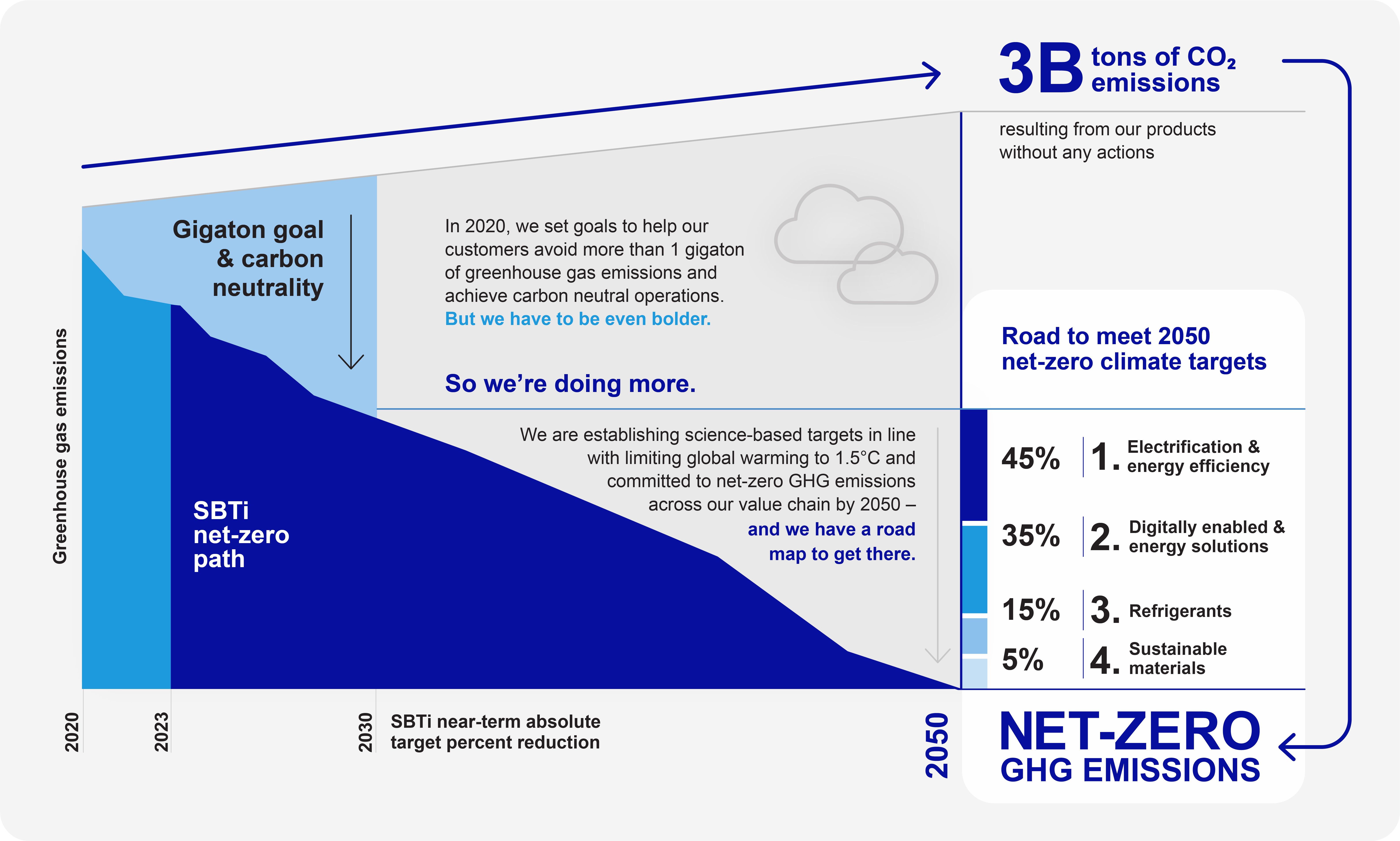
8 Carrier Global Corporation TableContentsOUR RESPONSE TO THE COVID-19 PANDEMICProtectinghelping customers avoid more than 1 gigaton of greenhouse gas emissions by 2030. Our PeopleWeproducts, services and digital capabilities help customers meet their energy, carbon and food-waste reduction goals. Energy-efficient heat pumps, all-electric refrigeration and building solutions, refrigerants with lower global warming potential and connected technologies are taking prudent measures to protect the health and safety of our employees. We implemented work-from-home requirements (where practical), social distancing measures, deep-cleaning protocols at our facilities and imposed travel restrictions, among other measures.Serving Our CustomersThe products and services we provide to our customers are more critical than ever before.For example, to address the unique challenges of vaccine distribution, we launched new Carrier Pods monitored by Sensitech, which combine leading refrigeration technology and cargo monitoring capabilities. These pods provide pharmaceutical companies, distribution centers, retailers and vaccine administrators with increased cold storage capacity, the flexibility to move vaccine storage to other locations and added visibility to help ensure the shelf life and efficacy of vaccines requiring precise refrigerated conditions.In addition, at the onsetjust a few of the pandemic, Carrier inventedways we are improving efficiencies in buildings, in homes and across the OptiClean, a negative air machine that helps hospitals protect caregivers and patients. As an air scrubber, OptiClean can also improve the indoor air quality of classrooms, restaurants, dental offices, commercial buildings andcold chain.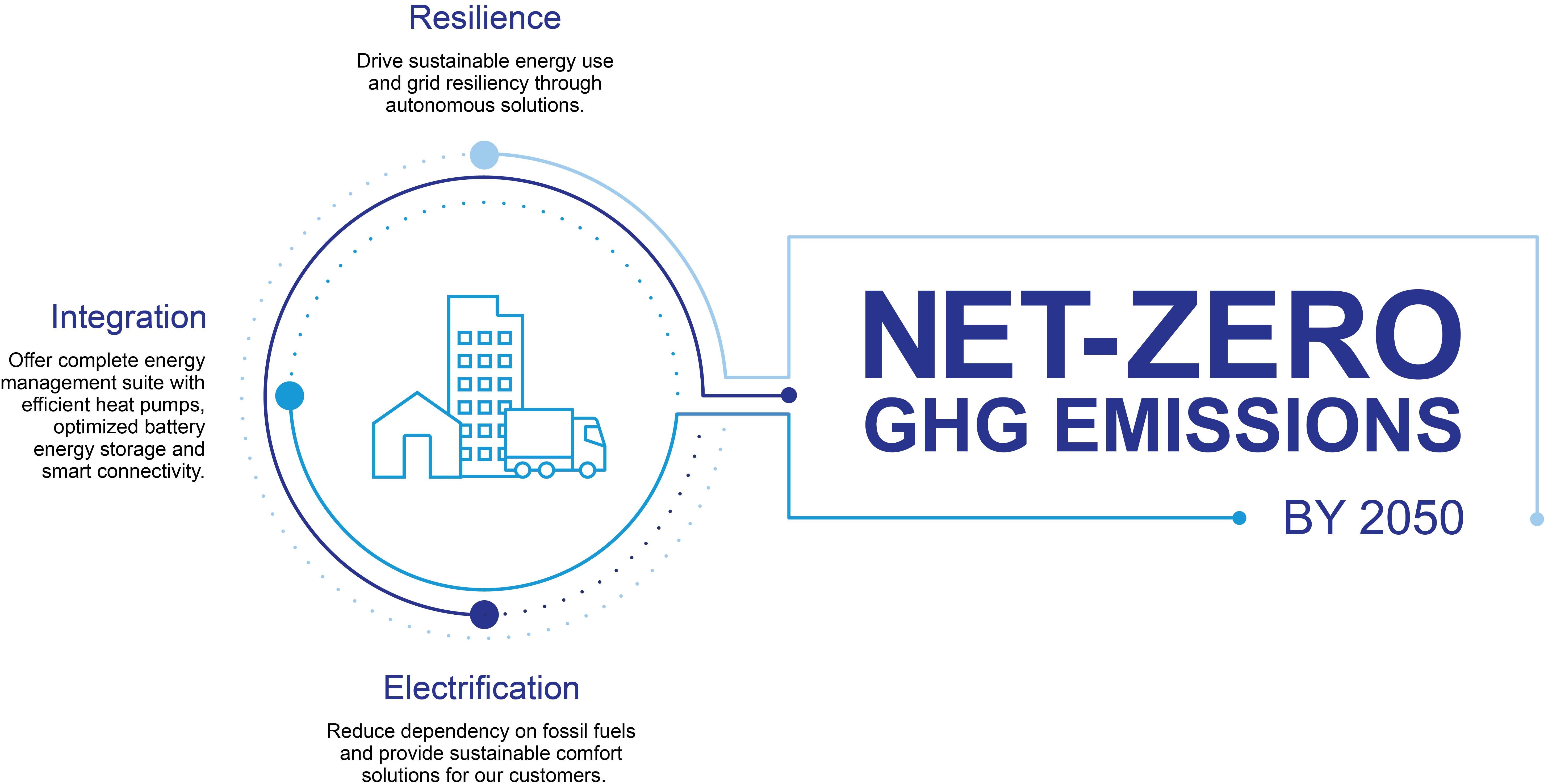
by pulling in air, scrubbing it using a HEPA filter, and then exhausting cleaner air back into the room, reducing contaminants in the air and offering further protection as part of an overall mitigation strategy.Supporting Our CommunitiesIn the United States, Carrier donated personal protective equipment for healthcare workers, hospitals and service technicians.Carrier Transicold donated a refrigeration unit to Gleaners Community Food Bank of Southeastern Michigan to help provide meals to children who were not receiving meals at school due to coronavirus-related closures.Carrier supported Habitat for Humanity’s emergency response fund in Palm Beach County, Florida, the location of our world headquarters.In Europe, our Fire & Security business made donations to support the purchase of ventilators and masks for hospitals in Madrid and Milan battling the coronavirus.In India, Carrier worked with United Way of New Delhi to provide personal protective equipment for healthcare workers and hospitals.In China, our GST business donated fire detection and alarm products to support the construction of a coronavirus hospital in Wuhan.And during 2020, we invested over $7than $965 million in sustainable research and design since 2020. Additionally, our communities through cashglobal venture capital group, Carrier Ventures, expanded its portfolio of strategic partnerships with high-growth companies to accelerate the development of sustainable innovations and in-kind contributions, including nearly $800,000 through the Carrier Employee Matching Gifts Program, a dollar-for-dollar charitable donation matching program.Building a Better, Healthier FutureIn addition to the work we are doing to help weather the pandemic, we are always looking to the future of healthy, safe and sustainabledisruptive technologies for building and cold chain net-zero solutions.6Carrier Global CorporationSustainable Innovations We focus on growth areas of electrification, energy management, and residential and light commercial HVAC technologies. MESSAGE FROM OUR LEAD INDEPENDENT DIRECTOR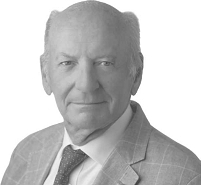
“The Board is dedicatedStrategic Collaboration We value strategic partnerships that enhance our research and development expertise and our channel to maintaining robust oversight, refreshment and evaluation processes … and continuing meaningful shareowner engagement, especially on important [ESG] issues.”Dear Fellow Shareowners,On behalf of the Board of Directors, I am pleased to share Carrier’s first Proxy Statement.2020 wasmarket or that become a momentous year for Carrier. In April, we completed our separation from United Technologies and became an independent public company trading on the New York Stock Exchange.My colleagues on the Board bring a rich and diverse blend of skills, experience and perspectives. We are excited about the challenges ahead of us and we work well together to find solutions. Each of us is firmly committed, in partnership with Dave Gitlin and his leadership team, to achieving long-term value for our shareowners while addressing the concernspart of our broader stakeholder community.Our governance practices, Carrier’s talented employees, robust operating systemsproduct offerings.Disruptive Technologies We prioritize software, analytics and resilient performance culture, enabled ustelematics.Commitment to weather the unprecedented disruptionExcellenceWe seek out companies that resulted from the COVID-19 pandemic. With this foundation, we are poised for growth.Looking forward, my priority is to ensure that our Board is effective in guiding Carrier to sustainable, long-term value creation. The Board is dedicated to maintaining robust oversight, refreshment and evaluation processes – of ourselves and Carrier management – and continuing meaningful shareowner engagement, especially on important environmental, social and governance issues.As you read the Proxy Statement, I trust that you will continue to share our enthusiasm for Carrier’s future. Thank you for your support. We will continue to work hard every day to deserve it.Sincerely,
Jean-Pierre Garnier, Ph.D.Lead Independent Director2021 Proxy Statement7
Sustainable Practices2020 was a profoundly transformational year for Carrier.On April 3, 2020, Carrier Global Corporation became a public company and our shares began trading under the symbol “CARR” on the New York Stock Exchange (“NYSE”). Before trading began on that day, United Technologies Corporation, since renamed Raytheon Technologies Corporation (“UTC”), completed the spin-off of Carrier into a separate, publicly traded company (the “Separation”) through a pro rata distribution of Carrier’s common stock to the shareowners of UTC who held shares of UTC as of the close of business on March 19, 2020 (the “Distribution”). As a result of the Separation and the Distribution, UTC shareowners of record received one share of Carrier common stock for every one share of UTC common stock. The Separation and the Distribution are further described in Carrier’s 2020 Annual Report on Form 10-K.2020 Performance Highlights2020 Financial Highlights$17.5 billionNet sales$3.1 billionGAAP operating profit$2.2 billionAdjusted operating profit*$2.25Diluted earnings per share$1.66Adjusted diluted earnings per share*$1.7 billionNet cash flows provided by operating activities$1.4 billionFree cash flow* **$2.8 billionReduction in net debt*• In 2020, we delivered net sales of $17.5 billion, operating profit of $3.1 billion and adjusted operating profit of $2.2 billion. Diluted earnings per share (“EPS”) was $2.25 and adjusted EPS was $1.66.*• Net cash flows provided by operating activities were $1.7 billion and capital expenditures were $312 million, resulting in free cash flow of $1.4 billion. Free cash flow included $272 million in tax payments related to the gain on the sale of Carrier’s shares in Beijer Ref AB (“Beijer”).*• In response to the COVID-19 pandemic, we implemented various measures to protect the health and safety of our employees, including work-from-home requirements (where practical), social distancing measures, deep-cleaning protocols at all of our facilities and travel restrictions.• We launched The Carrier Way – which describes our Vision (our aspiration; why we come to work every day), our Values (our absolutes; always do the right thing) and our Culture (our behaviors; how we work and win together, while never compromising our values).• We launched Carrier Excellence – our new operating system – and Carrier Alliance, which is an initiative that will strengthen and lengthen strategic relationships with our suppliers.• We launched our 2030 ESG goals, which include a target of carbon neutrality across our operations by 2030, and a target to reduce our customers’ carbon footprint by more than 1 gigaton over the same period.• We kicked off an initiative to simplify our business and reduce G&A expenses and bureaucracy – empowering our teams to focus on our customers and growth.• We announced Carrier 600, a cost-reduction program with a target to produce $600 million of recurring savings over three years. We increased this three-year target at the end of 2020 to $700 million under the renamed Carrier 700 program.• We invested in growth. We added more than 500 new sales professionals, increased our investments in R&D, introduced 124 new products and initiated a focused digital journey.• We introduced BluEdge, an enterprise-wide service and aftermarket offering designed to provide customers with superior service throughout the product lifecycle along with digitally enabled differentiation.• We increased our market share in core areas, including our residential, light commercial and applied HVAC businesses; cargo monitoring; and key parts of our Fire & Security portfolio.• We launched the Healthy Homes and Healthy Buildings Program and introduced the OptiClean Dual-Mode Air Scrubber & Negative Air Machine – a product that was recognized as one of TIME’s 100 Best Inventions of 2020.• We launched the Healthy, Safe, Sustainable Cold Chain Program and started collaborating with Amazon Web Services to develop Lynx, Carrier’s proprietary cloud-based platform with machine learning to help address cold chain challenges such as worldwide hunger, climate change, and safe medicine and vaccine distribution.* See Appendix A on page 74 for additional information regarding non-GAAP measures.** Includes $272 million in tax payments related to the gain on the sale of Carrier’s shares in Beijer.8Carrier Global CorporationAGENDA, BOARD AND GOVERNANCE SUMMARIESAgendaProposal 1Proposal 2Election of the Eight Director Nominees Named in the Proxy StatementAdvisory Vote to Approve Named Executive Officer Compensation
The Board recommends a vote FOR each of the director nominees
The Board recommends a vote FOR this proposal
Page 14
Page 30Proposal 3Proposal 4Appoint PricewaterhouseCoopers LLP to Serve as Independent Auditor for 2021Advisory Vote on the Frequency of Future Advisory Votes to Approve Named Executive Officer Compensation
The Board recommends a vote FOR this proposal
The Board recommends a vote for 1 YEAR
Page 63
Page 65Director Nominees
JOHN V. FARACI, 71Executive Chairman,Carrier Global Corporation
CHARLES M. HOLLEY, JR., 64Former Executive Vice President & Chief Financial Officer,Wal-Mart Stores, Inc.
JEAN-PIERRE GARNIER, 73Former Chief Executive Officer, GlaxoSmithKline plc
MICHAEL M. MCNAMARA, 64Chairman, PCH International Holdings; Venture Partner,Eclipse Ventures; Former ChiefExecutive Officer, Flex Ltd.
DAVID GITLIN, 51President & Chief Executive Officer, Carrier Global Corporation
MICHAEL A. TODMAN, 63Former Vice Chairman,Whirlpool Corporation
JOHN J. GREISCH, 65Former President & Chief Executive Officer, Hill-Rom Holdings, Inc.
VIRGINIA M. WILSON, 66Former Senior Executive Vice President & Chief Financial Officer, Teachers Insurance and Annuity Association of AmericaDiversity in Background of the Director Nominees

current orwomen andformer CEOspeople of color

current or formerindependentCFOsdirectorsThe Board recognizes that the long-term interests of Carrier and its shareowners are also advanced by responsibly addressing the concerns of other stakeholders, including Carrier employees, customers, suppliers and communities.20212024 Proxy Statement9 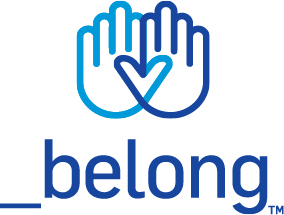
Global executive diversity* Global women executives U.S. People of Color executives U.S. People of Color professionals TableContentsAgenda, BoardColor.Governance SummariesGovernance SummaryFromUnited Carrier Asian Network. They reflect the outset asdiversity of Carrier’s workforce; foster a culture of inclusion, allyship and sponsorship for all; and continue to be open to all employees. Our ERGs led sessions on networking and career planning and held grassroots events throughout the year. In Japan, with our recent acquisition of Toshiba Carrier Corp., we expanded our efforts with the creation of an independent public company,inclusion and diversity council.Board has beentalent pipeline, and we increased student participation in our six-week leadership program. Mentors from Carrier led workshops on inclusion and diversity, and career preparation.strong corporate governance practices, which the directors believe are critical to achieving long-term shareowner valuecontinued development and which strengthen Board and management accountability. The following are highlightsengagement of our governance framework:people. We promote continuous learning through our Employee Scholar Program, which covers the cost of an employee’s tuition, academic fees and books at approved universities.BoardPractices
Independence
DirectorElections
ShareOwnershipShareownerRightsEngagedBoard
• Regular reviews of strategic direction and priorities • Regular reviews of significant risks • Annual Board, committee and director evaluations• 75% of director nominees are independent • All Board committees composed of independent directors • Robust Lead Independent Director role has explicit responsibilities • Independent directors meet regularly without management• Annual election of all directors • Majority voting for directors in uncontested elections• Rigorous share ownership requirements for directors and senior management • Directors required to hold Company-granted equity until retirement • No hedging, short sales or pledging of Carrier securities• Eligible shareowners can nominate through proxy access • Shareowners can act by written consent • 15% of shareowners can call special meetings • There are no supermajority shareowner voting requirements• 100% overall attendance at 7 Board meetings in 2020 • 100% overall attendance at committee meetings by committee members in 202010 Carrier Global Corporation Proposal 1: Election of DirectorsElection of DirectorsWHAT AM I VOTING ON?The Board presents eight directors at the 2021 Annual Meeting. Each nominee consented to being named as a nominee in the proxy materials and to serve if elected. Each director elected at the Annual Meeting will serve until the 2022 Annual Meeting or until a successor is duly elected and qualified.Our nominees hold and have held senior positions as leaders of various large and complex global businesses. Our nominees have been chief executive officers, chief financial officers, chief accounting officers and members of senior management. Through these roles, our nominees have developed experience and expertise in such areas as strategic planning, international business operations, human capital management, finance, innovation and risk management – among other areas. All but one of our nominees have prior experience serving on other public company boards, which, for a newly independent public company like Carrier, brings a seasoned and practical understanding of governance, public policy, compensation and sustainability practices to the Board’s deliberations.Detailed biographical information for each director nominee follows. We have included career highlights, other directorships, and other leadership and service experience. Our Board considered all of the aforementioned attributes and the results of our annual self-evaluation process when deciding to renominate each of the nominees.when deciding to renominate each of the nominees.As discussed below,described below. These criteria, which are set forth in connection with the refreshment and nomination process and on the recommendation of the Governance Committee (the “Committee”), the Board amended the Corporate Governance Guidelines that were adopted at the time of the Separation from UTC. The amended and renamedCarrier's Corporate Governance Principles, have, among other things, enhanced the criteria for board membershipare designed to reflect best practices and the directors’ priorities, which more appropriately reflect Carrier’s evolving business requirements as well asand to promote the long-term interests of Carrier, its shareowners and other stakeholders.The Board recognizes that the long-term interests of Carrier and its shareowners are also advanced by responsibly addressing the concerns of other stakeholders, including Carrier employees, customers, suppliers and communities, and stewardship of our planet. all Carrier directors, and believes that our current directors exhibit these attributes:directors:••• The highest••• The ability• The abilitypresent in the Board’s deliberations2024 Proxy Statement 11 enhancedconsiders sales and purchases of products and services between Carrier, including its subsidiaries, and other companies or charitable organizations where a director and a nominee (and immediate family members) may have relationships that are pertinent to the factorsindependence determination.it considers whenall of the nominees for election at the 2024 Annual Meeting, except for Messrs. Gitlin and Viessmann, are independent under NYSE listing standards and the Policy, because none of them has a business, financial, family or other relationship with Carrier that is considered material. With respect to the two non-independent nominees, Mr. Gitlin is currently an employee of Carrier, and Mr. Viessmann is the Chief Executive Officer, a member of the Executive Board and a significant beneficial owner of the Viessmann Group, from which Carrier acquired the VCS Business and with which Carrier has entered into various related agreements as discussed further below.candidate. Those factors includecandidate the following:Board considers their:••••••The Board’s consideration of its diversity with respect to a broad range of a candidate’s personal characteristics demonstrates our commitment to inclusiveness and our conviction that our greatest strength is the diversity of our people.2021 Proxy Statement1112 Carrier Global Corporation Proposal 1: Election of Directorsthat we expectexpected of each director, the CommitteeBoard, through its self-evaluation process and in consultation with the BoardGovernance Committee, has identified additionalbelow the skills and experience that are essential to the oversight and implementation of Carrier’s business and strategy and business requirements.

Financial SeniorWe place paramount importance on accurate financial reporting and robust financial controls and compliance. Therefore, we seek directors who have served in senior leadership roles of a financial function and/or the management of a large business resultingthat has resulted in a proficiency with complex financial management, financial reporting, capital allocation, capital markets, and mergers and acquisitions — reflecting, among other things, the heavy emphasis we place on accurate financial reporting and robust financial controls and compliance.acquisitions.

Human Capital Management Experience in effectively recruiting, engaging, developing and retaining a talented workforce is crucial. We believe that our employees are our most important asset and that, in turn, our success and growth depend in large part on our ability to attract, retain and develop a diverse population of talented and high-performing employees at all levels of the Company. This is why we value directors with experience in effectively engaging, developing, retaining and rewarding employees.company.

Innovation, Digital, Technology and TechnologyCybersecurityExperience with or oversight of innovative technologiesinnovation (including developing and adopting new technologies), digital solutions, engineering, information systems and cybersecurity.cybersecurity are skill sets that are vital to overseeing Carrier's transformation from an equipment manufacturer to a provider of digitally enabled lifecycle solutions.

International Business Operations International business experience ensures that valued business, political and cultural perspectives are included in the Board’s deliberations. Carrier has operations around the world, and a significant portion of our sales derive from outside the United States. Directors with international business experience impart valued business, political and cultural perspectives in the Board’s deliberations.

Knowledge of Company/
IndustryKnowledge or experience with Carrier’s businesses and/or consumer products –and services, whether acquired through service as a senior leader inor as a board member of a relevant business, or through long-term service on the UTC Boardaffords a deeper understanding of Directors prior to the Separation.Carrier's strategic, operating, regulatory and competitive environment.

Marketing/Sales ThisMarketing and sales experience is relevant to Carrierbeneficial as we implementfocus on forming and strengthening customer relationships to provide our three-pillar growth strategy, which is focused on strengthening and growing core businesses, increasing product extensions and geographic coverage, and growing services and digital todigitally enabled lifecycle solutions that create recurring salesrevenue opportunities.

Risk Management/
OversightThisRisk Management experience is critical to the Board’s role in overseeing and understanding majorenterprise risk exposures, including significantcompliance, cybersecurity, financial, human capital, operational, compliance,political, regulatory, reputational strategic, international, political and cybersecuritystrategic risks.

Senior Leadership Extensive leadership experience with a significant enterprise resulting inprovides a practical understanding of organizations,Carrier's organization, processes and strategic planning, alongand the challenges associated with demonstrated strengths in developing talent and driving change and long-term growth.the following page3 displays the most significant skills, experience and experienceattributes of each director. The Governance Committee regularly reviews the composition of the Board to ensure that it maintains a balance of skills, experience and experience,diversity of perspectives, and to assess whether there are gaps in light of current and anticipated strategic plans and business requirements.12Carrier Global Corporation2024 Proxy Statement 13 Proposal 1: Election of DirectorsDirectors’ Key Skills and Experience Summary








Financialxxxxxx
Human Capital Managementxxxxxxxx
Innovation and Technologyxxxx
International Business Operationsxxxxxxx
Knowledge of Company/Industryxxxx
Marketing/Salesxxx
Risk Management/Oversightxxx
Senior LeadershipxxxxxThe Board appreciates that robust and constructive self-evaluation is an essential element of good governance and continuous improvement. The self-evaluation informs the Board’s consideration of the following: •Board roles •Succession planning ••including committee assignments and succession planning 
The Board completed a self-evaluation, even though Carrier has been independent and publicly traded for less than one year. Dr. Garnier, our Lead Independent Director who also chairs the Governance Committee, guided that effort after consulting with the Committee and the Board as a whole regarding his recommended approach. Dr. Garnier then conferred with the directors individually to allow for their candid assessments of peer contributions and performance, and Board and Committee effectiveness. Afterwards, Dr. Garnier provided a summary of his conversations to the Board, which included feedback regarding the following topics:The Committee is responsible for and oversees the design and implementation of the annual self-evaluation.
Our Lead Independent Director guided this year’s self-evaluation process.• Director orientation and continuing education opportunities regarding Carrier and its businesses•of the Board and the diversity of the directors’ skills, experiences and personal characteristics• The effectiveness of the Board and the three standingits committees• Time allotments for discussionsleadership and deliberations•committee assignmentsCEO evaluation process •diversity, skills and experience of individual directors and the Board meeting topicsas a wholemeeting preparation materials•risk, including potential areas of disruption and ESG oversightmanagement’smanagement's relationship with the Board2021 Proxy Statement13Proposal 1: Election of Directors Committee periodically reviews the criteria for Board membership. That review complements the Board’s annual evaluation of its effectiveness which considersencompasses the following with regard toquestions, actions and outcomes, and plays an integral role in the Board’s compositionrefreshment and the nomination of candidates for election:process.
appropriatemost effective mix of skills and experiences,experience and a diversity of perspectives and personal characteristics that continuously improve oversight?perspectives?} Based on these considerations, the Board adjusts as necessary its priorities.structure, composition, recruitment and nominations to enhance its effectiveness on a continual basis.} 2021 Outcome:No changes.The Board considered it premature to change its composition because Carrier had been an independent company for less than one yearwas satisfied withand broadened the mix of skills, experiencesexperience and diversity of perspectivesits leadership and personal characteristics currently on the Board. The Board, however, did enhance the criteria for nomineesmembersGovernance Principlesclimate and energy industries.future refreshment opportunities.election at the 2024 Annual MeetingCommittee considers candidates recommended byBoard’s self-evaluation process is expected to contribute to the directors, managementconsideration of each incumbent as part of the refreshment and shareowners who satisfy the criteria the Board seeks in its directors.nomination process. A shareowner may recommend a director candidate by writing to Carrier’s Corporate Secretary (see "How Do I Contact the Corporate Secretary's Office" on page 7073 for contact information). The Governance Committee or Board also may engage search firms to assist in identifying and evaluating candidates and to ensure that the CommitteeBoard is considering a larger and more diverse pool of candidates.14 Carrier Global Corporation Board,board, as are the valuable experiences and deep understanding of Carrier’s business that a longer-servinglonger serving director may offer. In these circumstances, ouroffers. Our Corporate Governance Principles and Bylaws do not impose term limits on directors because the Board believes that a director who serves for an extended period will have that understanding and will thereforeoften be uniquely positioned to provide insight and perspective regarding Carrier’s operations and strategic direction. Nonetheless, theOur Corporate Governance Principles requireprovide that directors retire at the annual meetingAnnual Meeting after reaching age 75, unless the Board makes an exception to the policy in special circumstances. Moreover,Upon the Board’s self-evaluation process, including individual director evaluations, is expected to contribute to the Committee’s consideration of each incumbent as partrecommendation of the nominationGovernance Committee, the Board approved this exception for Dr. Garnier and refreshment process.20212024 Annual Meetingeight10 individuals presented in thethis Proxy Statement. All are current directors of Carrier and were elected by the shareowners at the 2023 Annual Meeting, except for Mr. Viessmann who joined the Board in January 2024 in connection with the Separation from UTC.20212024 Annual Meeting, any nominee becomes unavailable to serve, the Board may select a replacement nominee or reduce the number of directors to be elected. If the Board selects a replacement nominee before the 20212024 Annual Meeting, the proxy holders will vote the shares for which they serve as proxy for that replacement nominee.Director IndependenceUnder the NYSE listing standards, a majority of our directors must be independent; meaning, that the director does not have a direct or indirect material relationship with Carrier (other than as a director). The Company’s Director Independence Policy (the “Policy”) guides the independence determination and includes the categories of relationships that the Board has determined are not material relationships that would impair a director’s independence. The Policy is available on the Corporate Responsibility section of our website (see page 20).Before joining the Board, and annually thereafter, each director completes a questionnaire seeking information about relationships and transactions that may require disclosure, that may affect the independence determination or that may affect the heightened independence standards that apply to members of the Audit and Compensation committees. The Committee’s assessment of independence considers all known relevant facts and circumstances about the relationships bearing on the independence of a director or nominee. The assessment also considers sales and purchases of products and services, in the ordinary course of business, between Carrier (including its subsidiaries) and other companies or charitable organizations where a director and a nominee (and immediate family members) may have relationships that are pertinent to the independence determination.14Carrier Global CorporationProposal 1: Election of DirectorsWhile Carrier has been a public company for less than one year, in each of the past three years the annual payments Carrier made or received for products and services as well as Carrier’s charitable contributions fell below the thresholds in the Policy and NYSE listing standards (the greater of $1 million or 2% of the other company or organization’s consolidated gross revenues).The Board has determined that each of the nominees for election at the 2021 Annual Meeting, other than Messrs. Faraci and Gitlin who are currently employees of Carrier, is independent under the Policy and NYSE listing standards because none of the nominees, other than Messrs. Faraci and Gitlin, has a business, financial, family or other relationship with Carrier that is considered material.2021 Proxy Statement15Proposal 1: Election of Directors
John V. FaraciExecutive ChairmanCarrier Global CorporationFormer Chairman & Chief Executive OfficerInternational Paper
Lead Director71 76| DIRECTOR SINCE: 2020| COMMITTEES: NoneCompensation, Technology &InnovationAGE: 73 | DIRECTOR SINCE: 2020COMMITTEES: Compensation, Governance (Chair)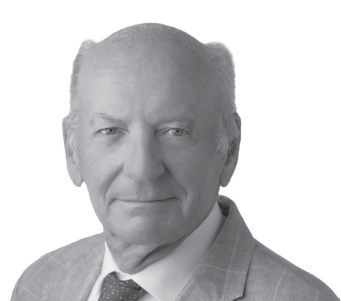
• International Paper (paper, packaging and distribution)• Chairman & Chief Executive Officer, 2003 to 2014• Executive Vice President & Chief Financial Officer, 2000 to 2003• Chief Executive Officer and Managing Director, Carter Holt Harvey Ltd. (former New Zealand subsidiary of International Paper), 1995 to 1999• • Operating Partner, 2016 to 2020OTHER CURRENT DIRECTORSHIPS• ConocoPhillips Company, since 2015• PPG Industries, Inc., since 2012• United States Steel Corporation, since 2019FORMER DIRECTORSHIPS• United Technologies Corporation, 2005 to 2020OTHER LEADERSHIP EXPERIENCE AND SERVICE• Member, Board of Trustees of the American Enterprise Institute• Member, Council on Foreign RelationsCAREER HIGHLIGHTS• Advent International (global private equity)• • • • • • • • • CARMAT AND COMMITTEES2018 • Collectis S.A.2020since 2020 • 2018 to 2022since 2015FORMER DIRECTORSHIPS• to 2022• United Technologies Corporation, 1997 to 2020 • • • • • • 16Carrier Global Corporation2024 Proxy Statement 15 Proposal 1: Election of Directors
President
Chief Executive OfficerCarrier Global Corporation
John J. GreischIndependentFormer President &Chief Executive OfficerHill-Rom Holdings, Inc.51 54| DIRECTOR SINCE: 2020| COMMITTEES: NoneAGE: 65 | DIRECTOR SINCE: 2020COMMITTEES: Compensation (Chair), Governance
• • • • 2018-2019• 2018 to 2019• • • • • Power Systems• • • Positions
• • • • • • • • • Vice President, Finance and Strategy, Bioscience, 2003• Vice President, Finance, Renal, 2002 to 2003• • • • • AND COMMITTEES2018• Cerner Corporation, since 2019• 2023 (executive chair)LLC (non-public, non-executiveMedical (non-public) (non-executive Chairman), since 2018• • • • 2021 Proxy Statement1716 Carrier Global Corporation Proposal 1: Election of Directors

Michael M. McNamaraIndependentChairmanPCH International HoldingsVenture PartnerEclipse VenturesFormer Chief Executive OfficerFlex Ltd.64 67 | DIRECTOR SINCE: 2020| COMMITTEES: Audit (Chair), CompensationGovernanceAGE: 64 | DIRECTOR SINCE: 2020COMMITTEES: Audit, Governance
• • • • • • • • • (public accounting)• • • AND COMMITTEES• (audit, chair• • • at AustinMcCombsMSB Foundation, The University of Texas at Austin
• PCH International Holdings (product developmentsupply chain management)• Chairman (non-public, non-executive),Chief Executive Officer, since 2019• Samara (experimental product development division of 2022)• (Samara division)since 2020• to 2022• since 2019• to 2022• • Ltd,Ltd. in 1994, including Chief Operating Officer• AND COMMITTEES• (audit; governance)since 2019FORMER DIRECTORSHIPS• to 2021• • 18Carrier Global Corporation2024 Proxy Statement 17 
Proposal 1: Election of Directors
Michael A. TodmanIndependentFormerChairmanWhirlpool Corporation
Virginia M. WilsonIndependentFormer SeniorPresident and Chief Financial Officer, 2013 to 2014Chiefrisk oversight; compensation and talent development)OfficerTeachers InsuranceInc., 2008 to 2023 (former Lead Independent Director)Annuity Association of AmericaResearch Institute18 Carrier Global Corporation 63 66| DIRECTOR SINCE: 2020| COMMITTEES: Audit, Compensation (Chair)AGE: 66 | DIRECTOR SINCE: 2020COMMITTEES: Audit, Governance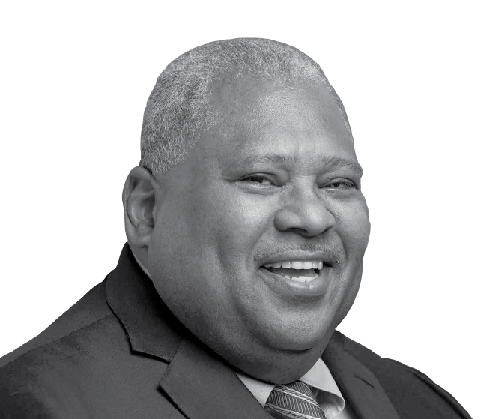
• • • • • senior positionscapacities since joining Whirlpool in 1993, including Executive Vice President,management, operations, sales and marketing positions in North America Region• and Europe• • AND COMMITTEES• (lead independent director; audit, chair• Prudential Financial, Inc., since 2016• • • 
• 2024 Proxy Statement 19 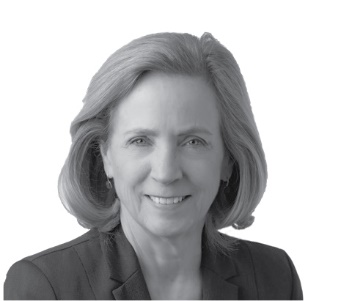
• • • • • • • • • • • • AND COMMITTEES• • 2021 Proxy Statement19
20 Carrier Global Corporation To this end, we believe that ourOur governance framework enables our independent, experienced and accomplished directors to provide advice, insight and oversight that will promotepromotes the long-termlong-term interests of the Company andcompany, our shareowners including consideration of the concerns ofand other stakeholders.(www.corporate.carrier.com)(see page 10), where you can access Carrier’s ESG frameworkgovernance documents. These documents reflect our commitmentscommitment to integrity, transparent financial reporting and strong financial controls, our approach to corporate governance and risk management, and our commitment to the environment and sustainability andsustainability. These documents include:•••Certificate of Incorporation•Bylaws••••Our • and excerpts from Carrier's Corporate Policy Manual ourthe Carrier Integrity Line for Anonymous Reporting Program, whichthat allows employees and other stakeholders to ask questions or raise concerns confidentially and outside the usual management channels••2020•Combined Role2024 Proxy Statement 21 under David GitlinOn February 4, 2021, the Board elected David Gitlin, Carrier’s current President & CEO, to the additional position of Chairman of the Board, effective upon his election to the Board at the 2021 Annual Meeting. Mr. Gitlin will succeed John V. Faraci, who will continue to serve on the Board upon his election at the Annual Meeting.When Carrier separated from UTC, Mr. Faraci left that company’s board to become Carrier’s executive chairman. In that position, Mr. Faraci imparted invaluable mentorship and guidance to Mr. Gitlin that was facilitated by his experience as a former CEO and seasoned public company director and by his understanding of Carrier’s business – which he acquired through his service on the UTC Board since 2005. Mr. Faraci’s role was critical as Carrier transformed into an independent public company.CEOChief Executive Officer ("CEO") should be separate or combined. Rather, under our Corporate Governance Principles, the Board has the flexibility to choose the most appropriate leadership structure that it believes will provide the most effective leadership and oversight for the Company.At present, the Board believes that the interests of shareowners are best served if the roles of Chairmancompany and CEO are combined in current President & CEO David Gitlin.its growth strategy. The Board considered several factors in reaching this decision, including:•Mr. Gitlin has served as CEO of Carrier since June 2019 and has served as a director since the Separation.•Before joining Carrier, Mr. Gitlin had been a 22-year veteran of UTC and held numerous senior positions, including President & Chief Operating Officer of Collins Aerospace Systems – which, in 2019 had annual sales of $26 billion – and President of UTC Aerospace Systems.•Through the Separation from UTC, the transformation of Carrier into a public company and during the COVID-19 pandemic, Mr. Gitlin has demonstrated strong leadership in the face of these challenges.20Carrier Global CorporationCorporate Governance•Mr. Gitlin has the requisite vision, experience and business acumen to lead the Board as well as the Company as we implement our long-term strategy.•Mr. Gitlin has fostered a strong working relationship between the Board and management through transparency and receptiveness to new ideas and approaches, and by cultivating accessibility to the management team.•Combining the roles of Chairman and CEO promotes decisive, unified leadership as Carrier implements its long-term strategy and settles into its position as an independent public company.•The Board has maintained a robust role for the Lead Independent Director with responsibilities that are delineated in the Governance Principles, and Dr. Garnier has exhibited strong and consistent leadership in that role.Enhanced BylawsAfter several months as a newly independent company, the Committee took a fresh look at the primary governance documents that were adopted in the course of the Separation. As part of this effort, the Board (upon the Committee’s recommendation) made the following changes to the Bylaws:•Enhanced certain disclosure requirements.•Added a new emergency bylaw that would take effect in the event of an emergency, disaster, catastrophe or similar condition where a quorum of the Board cannot be readily convened – changes deemed appropriate in light of the COVID-19 pandemic.Improved Corporate Governance PrinciplesAlso as part of the governance framework review, the Board (upon the Committee’s recommendation) considered and adopted amendments to the Corporate Governance Guidelines, since renamed the Corporate Governance Principles. The amendments, which reflect a comprehensive assessment of best practices and major investors’ expectations:•Affirmed that the Board recognizes that the long-term interests of Carrier and its shareowners are also advanced by responsibly addressing the concerns of other stakeholders, including Carrier’s employees, customers, suppliers and communities.•Amended the criteria for board membership to include a candidate’s diversity with respect to a broad range of personal characteristics.•Added a limit of two public company boards (including Carrier’s) for Carrier’s executive officers, including the CEO.Expanded Share Ownership RequirementsThe share ownership requirements that were adopted at the time of the Separation did not apply to the positions of business unit (“BU”) president, chief human resources officer (“CHRO”) and chief legal officer (“CLO”). Instead, they applied to members of the Executive Leadership Group (“ELG”) who may have held one of those positions. With Carrier’s decision to sunset the ELG program and close it to new entrants, and to correspond the share ownership requirements to Carrier’s leadership structure, the Board changed the requirements to apply to those positions rather than to ELG members only.Carrier’s Leadership StructureChairman and CEO RolesAs described earlier, the Board does not have a policy about whether the roles of Chairman of the Board and CEO should be separate or combined. The Committee however, routinely reviews our governance practices and boardBoard leadership structure. Andstructure, and the Board selects the structure that it believes will provideprovides the most effective leadership and oversight for the Company.company. In making this decision, at any given point in time, the Board considers and will consider a range of factors, including:including the Company’scompany’s operating and financial performance;performance, recent or anticipated changes in the CEO role;role, the effectiveness of the processes and structures for Board interaction with and oversight of management;management, and the importance of maintaining a single voice in leadership communications and Board oversight, both internally and externally, including with investors.2021 Proxy Statement2122 Carrier Global Corporation Corporate GovernanceUnderresponsibilities under the Governance Principles and the Bylaws:responsibilities:• • • independentnon-employee directors and the Chairman• • • • • • the independent directors to candidly raise issues or concerns for the Board’s consideration.Pre-SeparationRecruitmentIndependence Policy, Related Persons Transaction Policy, Share Ownership Requirements Policy and OrientationDirector RecruitmentOneCode of the most consequential tasks related to the Separation involved forming Carrier’s Board. Mr. Faraci and Dr. GarnierEthics – bothall of whom were servingwhich are available on the UTC Board at the time and, therefore, were very familiar with Carrier’s business requirements and the Separation’s underlying strategy – participated in UTC’s undertaking to identify, recruit, interview and select prospective directors. Mr. Gitlin was included in those efforts when he became Carrier’s President & CEO.Candidates were identified through traditional outlets. In some instances, a UTC director served on the boardCorporate Responsibility section of another public company with a director who had the skills and experience, among other attributes, that were essential to a new public company and an effective board. In other instances, UTC engaged a search firm. The candidates were then downselected for in-person interviews as needed. UTC’s full Board was kept informed throughout the process and ultimately approved the selection of Carrier’s directors.Director OrientationBefore the Separation, the then-future directors of Carrier met as a group with management on five separate occasions, and the then-future members of the Audit and Compensation committees each met on one other occasion. During these sessions, the then-future directors participated in orientation sessions that included reviews of the Company’s strategy and segments, financial and internal controls, compliance programs, enterprise risk management and compensation programs. Visits to our major facilities were constrained because of COVID-19.Going forward, new directors will go through a similar orientation that will familiarize them with the Company and include topics that are tailored to the director’s committee assignments. In addition, as a result of director feedback, directors will receive an even more in-depth orientation regarding our product and service offerings.Directors are encouraged to attend outside continuing education programs for directors and will be reimbursed by the Company for the cost of such programs and related expenses. Additional presentations and materials, including updates on recent business developments and on topical and beneficial subjects, are provided from time to time to certain directors or to all directors, as appropriate.Meetings and Committee CompositionBoard Meetingsis engaged,engages with, provides informed and meaningful guidance and feedback to, and maintains an open dialogue with management.management primarily through stated meetings and additional special meetings where required. At each stated meeting, of the Board, the agenda typically includes committee reports, a review of the Company’scompany’s financial results and outlook, a briefing on aspects of our long-term strategy, committee reports, and other matters — whether requested by the directors or deemed pertinent by management. In addition, the Board participated inand senior management hold an all-dayannual strategic planning session toward the end of 2020.22Carrier Global Corporation
in October.Corporate Governanceduring 2020 – including three special meetings – and each memberin 2023. Together, directors attended 98% of the Board who served during 2020 attended 100% of the aggregate of (i) the meetings of the Board held during 2020, and (ii) the96% of meetings held by each committee of the Boardcommittees on which such memberthey served during 2020.foursix of its seven meetings in 2020.Directors are encouraged to attend the Annual Meeting. Carrier, however, did not hold such a meeting during 2020 because the Separation did not occur until April of that year.advance. And management endeavors to make these materials available at least one week before a meetingadvance to facilitate more informed discussion and decision making.2024 Proxy Statement 23 MeetingsResponsibilities, Composition and Compositionthreefour standing committees: Audit, Compensation, Governance and Governance. Each committee isTechnology & Innovation. The Audit, Compensation, and Governance committees are composed entirelyexclusively of independent directors. Committee meetings are held in conjunction with stated Board meetings. TheAll four committees may meet more frequently as they may require. Each committee also has the authorityoperate pursuant to retain and terminate independent advisors to assist in the performance of its responsibilities. Each committee operates under a written charter – all of which are available on the Corporate ResponsibilityGovernance section of our website (see page 20) – that sets forth the committee’s purposes and responsibilities, and that21). Each charter is periodically reviewed by the respective committee to determine whether it should be updated to reflect best practices andand/or director feedback.Chair: Meetings: 7M. McNamaraA. Todman Michael A. TodmanPurposes &•statements;statements and disclosures in Carrier's Form 10-Q and 10-K, including climate- and cybersecurity-related disclosures; the independence, qualifications and performance of Carrier’s independent auditors and internal and external auditors;audit function; the Company’scompany’s compliance with its policies and procedures, internal controls, and Our Code of Ethics and applicable laws and regulations; and the policies and procedures relating topractices of Carrier's ERM program; financial risks and other significant areas of risk, assessmentincluding compliance- and management•cybersecurity-related risks nominationappointment of the independent auditor for approvalratification by shareowners••Pre-approves•The has determined that each of Messrs. Holley McNamara and Todman and Ms.Mses. Story and Wilson are “audit committee financial experts” as that term is defined in SEC rules, and that each has accounting and financial management expertise as provided under the Securities and Exchange Commission (“SEC”) rules.Chair: Meetings: 4Jean-Pierre GarnierMichael A. TodmanCharles M. Holley, Jr.Purposes &•• and mitigate compensation-based risk incentive compensationbonus plans for executives,• including performance goals for senior executives related to the implementation of Carrier's ESG program Executive Chairman and CEO,•Approves the compensation for Section 16 officers and certain other senior executives•long-term incentiveLTI awards•2021 Proxy Statement2324 Carrier Global Corporation Corporate GovernanceGovernance CommitteeChair: Jean-Pierre GarnierMeetings: 4John J. Greisch••Developscorporate governance principles•Oversees the designamendments to Corporate Governance Principles and implementation of the annual self-evaluation of theother Board the committees and individual directors•policies ••Reviews and monitorsleadership•Reviewsoversees Carrier’sphilanthropic activities, environmental, health and safety programs and related ESG goals and initiatives, government relations (including the Carrier Political Action Committee ["Carrier PAC"] and political expenditures), product integrity programs, and positions on significant public issuescorporate social responsibility,digital developments and trends, including diversity,those in the environment,field of sustainability that could have a material impact on Carrier, its customers and suppliersaan extensive range of risks, such asincluding compliance, financial, geopolitical, legal, financial, operational, strategicregulatory, reputational and reputational risks.strategic. Within these broad categories, specific risks include human capital management, which includes talent acquisition, development and retention;include: climate impacts; cybersecurity; the competitive landscape (including disruptive technologies); human capital management (including talent acquisition, development and retention); logistics and supply chain; and the impact of disruptive events such as(including natural disasters and pandemics.Enterprise Risk Management (“ERM”)ERM program, which is a companywide effort –that is managed by senior executives –and overseen by the Audit Committee and Board to identify, assess, manage, report and monitor enterprise risks that may affect our ability to achieve the Company’scompany’s objectives and strategy. The Audit Committee has oversight responsibility for the ERM program and process.eachownership of enterprise risk is assigned to the appropriate business unit andsegment or corporate functional departmentfunction that is responsible for identifyingdeveloping and reportingimplementing comprehensive mitigation plans. The Board reviews these risks thatand mitigation plans on an annual basis in conjunction with Carrier's strategic plan. Mitigation plans are specificreviewed for effectiveness and include a broad range of measures to its operationsmanage and when applicable,reduce risk, including adjustments to the Company at large. strategic and business initiatives, research and development, product design, increased protections for our facilities and supply chain, and enhanced internal controls, including employee and contractor training.and Board also discussreview enterprise risks with senior management on a regularan on-going basis including through reviews of compliance issues and business risks. For example, cybersecurity risk – including product and information technology infrastructure risks – is an enterprise risk thatthroughout the Audit Committee and the Board (through committee reports) receive regular updates, including three such briefings in 2020.focus.focus and charter responsibilities as described in the table on the following page. At each regular meeting, or more frequently as needed, the Board receives and considers committee reports that may provide additional detail on risk management issues and management’s response.
response to them. For example, cybersecurity risk is an enterprise risk that the Audit Committee and the Board oversee and review, with four briefings to the Audit Committee and one briefing to the Board.24Carrier Global Corporation2024 Proxy Statement 25 Corporate Governancethe oversight of Carrier’s risk management process and structure,strategic risks, while the Audit Committee oversees the Company’s overallcompany’s ERM policies and practices for ERM. In addition, responsibilitypractices. Responsibility for the oversight of specific risk categories is allocated among the Board and its committees as follows:Full Board of Directors Audit CommitteeCompensation CommitteeGovernance Committee•• including Carrier's ESG program and related goals• including climate-related risks, pursuant to Carrier's ERM program•program• Significant operational risks• Significantpolicies and practices• Capital structure•prices• Compliance programs•hedgingreputationaloperational risks• Significant strategic risks• Cybersecurity risks••• Compensation including those related to implementation of senior leaders• Compensation plan design• Executive retention• Corporate governance•••• Health health and safety• Corporate social responsibility• Diversity•policy issuesCompany’scompany’s business – whether at the local, state or federal level in the United States, or with foreign governments and international governmental organizations.reviewsreview and monitorsmonitor the Company’scompany’s government relations activities, including those of the Carrier Political Action Committee (“Carrier PAC”).PAC. These activities are governed by and conducted in accordance with the standards articulated in Ourour Code of Ethics and Corporatecorporate policy on Government Relations, both of which are available on the Company’s website (see page 20).Companycompany, our shareowners and our shareowners.other stakeholders. These initiatives are not based on the personal agendas of individual shareowners or Carrier’s directors, officers or employees.Companycompany does not make or direct political contributions to candidates for U.S. federal office and, as a matter of policy, does not contribute to candidates for state or local office in the U.S.United States or for offices in foreign countries. The Carrier PAC, which is entirely funded by voluntary contributions, is nonpartisan and will contributecontributes to candidates for federal office who are supportive of Carrier’s corporate business interests and public policy goals, regardless of political party.26 Carrier Global Corporation on financial performance, capital allocation and business strategy, including our ESG-related initiatives. In 2020,offers them an opportunity to discuss with management hosted an investor and analyst day and conducted roadshows in the months leading up to the Separation. Since we became a public company, management has participated in eleven investor conferences and held numerous teleconferences with shareowners around the world.In 2020, we engaged with institutional investors holding more than 400 million shareswide range of Carrier common stock, which represented almost 46% of our shares outstanding. In 2021, we expect our discussions to also focus on the clarity and effectiveness of our disclosures, including those related to our ESG, and diversity and inclusion initiatives.
subjects.2021 Proxy Statement25Shareowner Engagement in 2023 



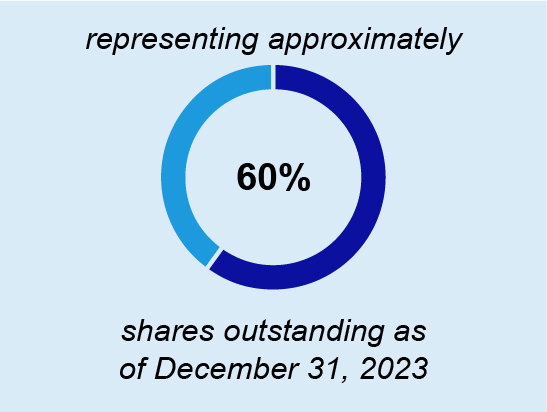
Topics Discussed 2023 Topics Discussed Expected 2024 Topics 2024 Proxy Statement 27 TableUnder the terms of the Carrier Board of Directors Deferred Stock Unit Plan (“Carrier Director DSU Plan”), annual base retainers for non-employee directors are payable 40% in cash and 60% in Deferred Stock Units ("DSUs"). A director may elect to receive the cash retainer in DSUs. Non-Employee Director Annual Retainer 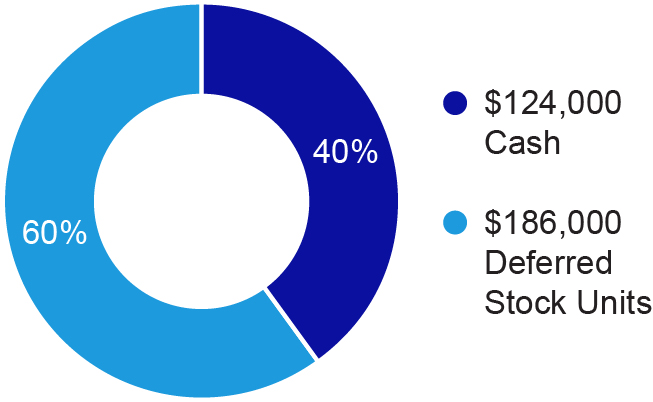
ROLE CASH($) DEFERRED STOCK UNITS($) TOTAL($) All Non-Employee Directors (base retainer) 124,000 186,000 310,000 Lead Independent Director 14,000 21,000 35,000 Audit Committee Chair 10,000 15,000 25,000 Audit Committee Member 6,000 9,000 15,000 Compensation Committee Chair 8,000 12,000 20,000 Governance Committee Chair 8,000 12,000 20,000 Technology & Innovation Committee Chair 8,000 12,000 20,000 20202024 to April 20212025 Board cycle were payable 42%the same as for the prior Board cycle. This marks the fifth consecutive Board cycle in cash and 58% in DSUs. A director also may electwhich the Board compensation has remained the same (apart from a one-time reduction to receive the cash retainer in DSUs.
ROLE CASH DEFERRED STOCK UNITS TOTAL All Non-Employee Directors (base retainer) $124,000 $173,600 $297,600 Additional Compensation for Services* as: Lead Independent Director $14,000 $21,000 $35,000 Audit Committee Chair $10,000 $15,000 $25,000 Audit Committee Member $6,000 $9,000 $15,000 Compensation Committee Chair $8,000 $12,000 $20,000 Governance Committee Chair $8,000 $12,000 $20,000 *Directors serving in multiple leadership roles receive incremental compensation for each role.Because ofDSU amount during the COVID-19 pandemic and the non-employee directors’ base retainer DSU awardaddition of compensation for the 2020-2021 Board cycle was reduced by $12,400, from $186,000 to $173,600, which aligned with similar pay reductions for Carrier’s Executive Leadership Team.2020.Effective at2021 Annual Meeting,terms of the total base retainer willCarrier 2020 LTI Plan, the maximum annual compensation (cash and equity awards) that may be $310,000, composed of $124,000 in cash and $186,000 in DSUs. Therepaid by the company to any non-employee director is $1.5 million.no changessubject to the incremental role-based retainers. These changes will restore the directors’ compensation to the amount set at the Separation.28 Carrier Global Corporation 26Carrier Global CorporationCompensation of Directors20202023 Director CompensationNAME TOTAL($) Jean-Pierre Garnier — 310,000 833 310,833 John J. Greisch — 345,000 2,736 347,736 Charles M. Holley, Jr. 134,000 201,000 4,796 339,796 Michael M. McNamara — 330,000 833 330,833 Susan N. Story — 325,000 4,138 329,138 Michael A. Todman 138,000 207,000 3,299 348,299 — — — — Virginia M. Wilson 140,668 211,000 25,000 376,668 Beth A. Wozniak 124,000 186,000 880 310,880 services in 2020.1 NAME FEES
EARNED OR
PAID IN CASHSTOCK
AWARDS2ALL OTHER
COMPENSATION3TOTAL Jean-Pierre Garnier — $352,600 — $352,600 John J. Greisch — $317,600 $5,000 $322,600 Charles M. Holley, Jr. $134,000 $188,600 — $322,600 Michael M. McNamara $130,000 $182,600 — $312,600 Michael A. Todman $130,000 $182,600 — $312,600 Virginia M. Wilson $130,000 $182,600 — $312,600 1Mr. Faraci is an executive officer and executive chairman of Carrier’s Board. Because Mr. Faraci was not a NEO in 2020 and did not receive any additional compensation with respect to services provided as a director, he is omitted from this table. During 2020, his compensation as an executive officer of Carrier consisted of salary ($667,424), equity-based awards and personal use of the corporate aircraft ($99,146, which reflected the incremental variable operating costs). The equity-based awards consisted of restricted stock units (“RSUs”) and stock appreciation rights (“SARs”). The grant date fair values of the RSUs and SARs was $765,272 and $764,876, respectively. The grant date fair values were calculated in accordance with FASB ASC Topic 718, but exclude the effect of estimated forfeitures. The assumptions made in calculating the fair value of these awards are described in Note 14 – Stock-Based Compensation, to the accompanying Notes to the Consolidated Financial Statements in Carrier’s 2020 Annual Report on Form 10-K. Mr. Faraci also received $51,000 in compensation from Carrier in 2020 for pre-Separation governance activities while he served on the UTC Board. As previously disclosed by UTC, the fees for these activities were calculated consistent with its policy of compensating its non-employee directors for in-person attendance at special meetings.2Stock Awards consist of the grant date fair value of the DSU awards credited to the non-employee director’s account, including any portion of the annual cash retainer that the non-employee director elected to receive as DSUs. The value of the DSU awards was calculated in accordance with FASB ASC Topic 718 using assumptions described in Note 14 – Stock-Based Compensation, to the accompanying Notes to the Consolidated Financial Statements in Carrier’s 2020 Annual Report on Form 10-K. The number of units credited to each non-employee director in 2020 was calculated by dividing the value of the award by $17.80, the NYSE closing price per share of Carrier common stock on May 12, 2020, which was the date contemplated by the Carrier Director DSU Plan in connection with the Separation.3Amounts in this column include incidental benefits and matching contributions to eligible nonprofit organizations under the Company’s matching gift program that covers non-employee directors as well as Company employees.20212024 Proxy Statement2729 TableContentsOur rigorousthe Board expanded the existing share ownership requirements. Prior to the change, the share ownership requirements detailed below, which were implemented following the Separation from UTC, promote and strengthen the alignment of ourextended to Carrier's non-employee directors, the Chairman & CEO, and management withonly certain ELT members. Beginning January 1, 2024, the interests of our shareowners.6x5x4x3xbase salary for CEObase salary for Executive Chairman; and annual base cash retainer for independent directorsbase salary for CFObase salary for ELG membersUnder these requirements, non-employee directors have been required to achieve their ownership level within five years of joining the Board. Similarly, the Executive Chairman, CEO, CFO and ELG members have been required to achieve their respective levels within five years of attaining their positions or, if applicable, joining the ELG. Ifshare ownership requirements arenow extend to all ELT members and Carrier's Controller. The share ownership requirements vary by position and range from 1X to 6X base salary, or the annual cash retainer for non-employee directors. The share ownership requirements may be satisfied by ownership of company common stock, Deferred Stock Units (“DSU”) and Restricted Stock Units (“RSUs”), but excluding stock options, Stock Appreciation Rights (“SARs”) and unvested Performance Share Units (“PSUs”). Individuals who do not met after thismeet the foregoing share ownership requirements within the applicable five-year period then the individual will not be permitted to sell Carrier shares of company common stock until satisfying these requirements. Each of the ownership levels have been achieved. All directorsDirectors and ELG membersNEOs currently comply withexceed their respective ownership requirements as outlined below or are on track to meet them within the five-year period.As discussed earlier, in February 2021 the Board adopted new share ownership requirements because those that were adopted at the time of the Separation did not apply to the positions of BU president, CHROCLO. Instead, they applied to members of the ELG who may have held one of those positions. With Carrier’s decision to sunset the ELG program and close it to new entrants, and to correspond the share ownership requirements to Carrier’s leadership structure, the Board changed the requirements to apply to those positions rather than to ELG members only.6x 5x 4x 3x Chairman & CEO Non-employee directors Chief Legal Officer ("CLO") Companycompany as of February 12, 2021,15, 2024, regarding the beneficial ownership of our common stock byby: (i) each director each NEO, and all currentnominee; (ii) NEOs identified in "Compensation Discussion and Analysis" that begins on page 33; and (iii) the directors and executive officers and directors as a group.No director, NEO, None of the directors, the NEOs or the directors and executive officers together as a group owned more than 1% of our common stock. The Total Shares Beneficially Owned column does not include Restrict Stock Units (“RSUs”) and Performance Share Units (“PSUs”) granted to executive officers because this equity is not beneficially owned under SEC rules.stock as of that date. Unless otherwise noted, each person named in the table below has sole voting and investment power. Directors and Executive Officers SARs
EXERCISABLE
WITHIN 60 DAYS1DIRECTOR RSUs
CONVERTIBLE TO
SHARES WITHIN 60
DAYS2DIRECTOR DSUs
CONVERTIBLE
TO SHARES
WITHIN
60 DAYS3TOTAL SHARES
BENEFICIALLY
OWNED4John V. Faraci 2,077 47,120 49,197 Jean-Pierre Garnier 98,459 116,569 David Gitlin 216,991 526,679 John J. Greisch 17,992 53,409 Charles M. Holley, Jr. 10,684 10,713 Michael M. McNamara 10,344 10,344 Michael A. Todman 10,344 10,344 Virginia M. Wilson 10,344 10,344 David Appel 69,436 110,507 Patrick Goris Timothy McLevish Christopher Nelson 62,402 101,653 Kevin J. O’Connor 516 Directors & Executive Officers as a group (17 in total)5 1,202,279 DIRECTORS AND EXECUTIVE OFFICERS Jean-Pierre Garnier 126,279 144,389 David Gitlin 1,289,711 1,991,290 John J. Greisch 42,873 78,290 Charles M. Holley, Jr. 28,574 28,603 Michael M. McNamara 31,377 31,377 Susan N. Story 10,897 10,897 Michael A. Todman 25,183 25,183 1,647 58,610,606 Virginia M. Wilson 24,973 24,973 Beth A. Wozniak 12,980 12,980 Patrick Goris 104,443 178,602 Kevin O'Connor 322,740 388,823 Jurgen Timperman 148,750 187,608 Timothy N. White 13,317 62,598,714 2830 Carrier Global Corporation Share Ownership1The SARs in the table reflect the net number of shares of Carrier common stock that would be issued to the executive officers if their vested SARs were exercised within 60 days of February 12, 2021. Once vested, each SAR can be exercised for the number of shares of Carrier common stock having a value equal to the increase in value of a share of Carrier common stock from the date the SAR was granted through the exercise date. The net number of shares of Carrier common stock was calculated using $37.28 per share, which was the closing price on February 12, 2021.2The non-employee director RSUs are distributed in shares of Carrier common stock upon termination of service. The table reflects the number of shares that the director has the right to acquire at any time within 60 days of February 12, 2021, following the director’s separation form the Board. Mr. Faraci, who previously served on the UTC Board of Directors, received these RSUs in connection with the Separation from UTC and which were attributable to that prior service. Carrier does not award such RSUs to its non-employee directors.3The non-employee director DSUs are converted into Carrier common stock upon termination of service. The table reflects the number of shares that the director has the right to acquire at any time within 60 days of February 12, 2021, following the director’s separation from the Board. Mr. Faraci and Dr. Garnier acquired a portion of the DSUs reflected in the table in connection with the Separation from UTC and their prior service on that company’s board.4Includes shares for which voting and investment power is jointly held by the director or NEO: D. Gitlin (278,771 shares).5Reflects as of February 12, 2021, the holdings of the directors and executive officers listed in the Company’s 2020 Annual Report on Form 10-K.holdersshareowners known to Carrier to be beneficial owners ofbeneficially own more than 5% of the outstanding shares of Carrier common stock.NAME AND ADDRESS SHARES PERCENT OF CLASS 60,728,408 7.20 % 83,664,060 10.00 % 92,829,907 11.10 % 65,216,592 7.80 % 93,816,461 11.18 % 58,608,959 6.53 % 2020.NAME AND ADDRESS SHARES PERCENT OF CLASS BlackRock, Inc.1 67,417,311 7.8% 55 East 52nd Street New York, NY 10055 Capital Research Global Investors2 49,256,599 5.7% 333 South Hope Street Los Angeles, CA 90071 State Street Corporation3 68,846,254 7.94% State Street Financial Center One Lincoln Street Boston, MA 02111 The Vanguard Group4 94,833,852 10.95% 100 Vanguard Boulevard Malvern, PA 19355 1BlackRock, Inc., reported in a Schedule 13G filed with the SEC that, as of December 31, 2020, it held sole power to vote or to direct the vote of 58,863,398 shares and sole power to dispose or direct the disposition of 67,417,311 shares.2Capital Research Global Investors reported in a Schedule 13G filed with the SEC that, as of December 31, 2020, it held sole voting power with respect to 49,253,394 shares, shared voting power with respect to zero shares, sole dispositive power with respect to 49,256,599 shares, and shared dispositive power with respect to zero shares.3State Street Corporation (“State Street”) reported in a Schedule 13G filed with the SEC that, as of December 31, 2020, it held sole voting power with respect to zero shares, shared voting power with respect to 65,113,412 shares, sole dispositive power with respect to zero shares, and shared dispositive power with respect to 68,816,684 shares. State Street also reported that its subsidiary, State Street Global Advisors Trust Company, owned 5.92% of Carrier common stock (or 51,306,620 shares) and that in this capacity it has sole voting power with respect to zero shares, shared voting power with respect to 17,080,272 shares, sole dispositive power with respect to zero shares, and shared dispositive power with respect to 51,306,620 shares.4The Vanguard Group reported in a Schedule 13G filed with the SEC that, as of December 31, 2020, it held sole voting power with respect to zero shares, shared voting power with respect to 1,318,242 shares, sole dispositive power with respect to 94,833,852 shares, and shared dispositive power with respect to 3,779,356 shares.20212024 Proxy Statement2931Proposal 2: Advisory Vote to Approve Named Executive Officer CompensationIYou Vote For thisThis Proposal?a say-on-paythe "say-on-pay" vote. While this vote is advisory and therefore not binding on the Board, the outcome of the vote and discussions with investors in the coming year will inform the Compensation Committee’s evaluation of Carrier’s compensation practices and the Committee’s future decisions regarding compensation. We also expect that investor feedback regarding the clarity and transparency of compensation disclosures, if any, will be reflected in future proxy statements to the extent appropriate.3032 Carrier Global Corporation (CD&A)("CD&A") provides important information about Carrier’s executive compensation philosophy and programs for fiscal year 2020.2023. In addition, this CD&A describes compensation decisions made by the Compensation Committee of the Board (sometimes referred to within this CD&A as the “Committee”), which is responsible for overseeing the compensation programs for all executives including, for 2020,2023, including Carrier’s NEOs:•NAMED EXECUTIVE OFFICERS (NEOs) TITLE David Gitlin PresidentChairman & Chief Executive Officer •Patrick Goris Senior Vice President & Chief Financial Officer •Jurgen TimpermanPresident, Fire & Security Timothy White President, Refrigeration Kevin J. O’Connor, O'ConnorSenior Vice President & Chief Legal Officer •David Appel, President, Refrigeration•Former President, HVAC •Timothy McLevish, Special Advisor to the President & CEO and former Senior Vice President & Chief Financial OfficerOn October 19, 2020, the Company announced that as part of a planned transition, McLevish would retire from the Company in February 2021. His successor, Mr. Goris, assumed the role of Chief Financial OfficerNelson's employment ended on November 16, 2020, at which point Mr. McLevish transitioned into the role of Special Advisor to the President and CEO, a position he held until his retirement on Feb 15, 2021.2020 May 26, 2023.2020 was a year unlike any other. It was a profoundly transformational year, as the Company became a stand-alone public company on April 3, 2020, following the Separation from UTC, and in the midst of a global pandemic.Despite all of this, the Company delivered strong financial results during a challenging year.2020 Performance Highlights1•Delivered operating profit of $3.1 billion, and adjusted operating profit of $2.2 billion•Delivered net cash flows provided by operating activities of $1.7 billion, and free cash flow of $1.4 billion, which included $272 million in tax payments related to the gain on the sale of the shares in Beijer Ref Ab (“Beijer”)•Carrier’s stock price appreciated 180% from the Separation through the end of 2020•Implemented Carrier 600, a cost reduction program with a target to produce $600 million of recurring savings over three years, and subsequently increased the target to $700 million at the end of 2020, under the renamed Carrier 700 program•Invested in growth, which included adding 500 new sales professionals, increased our investments in R&D, and introduced 124 new products1See Appendix A on page 74 for additional information regarding non-GAAP measures.Established the FoundationPrior to the Separation, a new Executive Leadership Team (“ELT”) was identified, leaders were appointed into their new roles, and substantial efforts were made to develop a new operating model and business priorities to ensure a seamless transition of leadership and operations following the Separation. Because the Separation occurred in fiscal year 2020, NEOs’ incentive compensation was determined by performance targets established by the UTC Compensation Committee prior to the Separation and by the Carrier Committee following the Separation.Upon the Separation from UTC, the Committee took steps to establish our foundation, redefine our compensation philosophy and re-design our programs inherited from UTC to align with the needs and focus areas of Carrier as a new independent company. However, both the Separation and the COVID-19 pandemic affected our 2020 executive compensation decisions.Conducted a Review of Carrier’s Executive Compensation ProgramsFollowing the Separation, the Committee and Company leadership conducted a full reviewCompany’s compensation programsprogram is to ensure appropriateness for Carrier as a new independent companyencourage and alignment to business priorities andreward the external market.creation of sustainable, long-term shareowner value. The Committee approved a revised compensation philosophy and principles, as noted below, along with program design changes which will be implemented in 2021.2021 Proxy Statement31Tablecurrent elements of ContentsCompensation Discussion and AnalysisIn summary, the 2021 executive compensation program design will continue to consist of three components, base salary, annual bonus and long-term incentives for the CEO and NEOs. Changes reflected in the 2021 annual bonus program and long-term incentive plan, as reflected in the table below, are aligned with the Company’s goal of achieving long-term sustainable growth and further linkingdirectly align the interests of the executives and shareowners, are competitive, motivate achievement of short- and long-term financial goals and strategic objectives, and align realized pay with shareowners, as evidenced specifically by the inclusion of Sales as an individual metric in the 2021 annual bonus plan, and including Performance Share Units in the 2021 long-term incentive program.COMPENSATION ELEMENT2020 METRICS12021 METRICSAnnual BonusAdjusted Operating Profit2 (50%)Free Cash Flow2 (50%)Sales (40%)Adjusted Operating Profit2 (40%)Free Cash Flow2 (20%)Annual Long-Term Incentive (Equity)50% SARs50% SARsGrants50% RSUs50% PSUs31In April 2020, following the Separation, the Carrier Compensation Committee decided to equally weight the financial metrics of adjusted operating profit and free cash flow, placing a greater emphasis on free cash flow, to further emphasize the importance of cash generation to the future success of the Company.2Performance goals and results are based on non-GAAP financial measures, see Appendix A on page 74 for more details.3PSUs will consist of two equally weighted measures of relative Total Shareholder Return (TSR) and Earnings Per Share Growth (EPS) measured as a Compound Annual Growth Rate (CAGR) over a 3-year period.Additionally, the Committee approved a new compensation peer group for external benchmarking purposes, as discussed later in the document beginning on page 39.Defined Carrier’s Compensation performance. for Executive Compensationlong-termshort- and short-termlong-term financial goals while executing on the Company’scompany’s strategic vision to create exceptional shareowner value.•We create compensation plans that are simple and transparent to employees and investors.•We strive to attract and retain the best, most diverse teams, motivated through compensation programs that are market competitive.•We pay for performance and ensure that incentive plans have a clear connection between increasing shareowner value and exceeding customer commitments.•Compensation programs are clearly aligned to business priorities and shareowner interests, underpinned by a culture strongly tied to the Carrier Code of Ethics and The Carrier Way.32Carrier Global Corporation
▪We create compensation plans that are simple and transparent to employees and shareowners.TableContentsCompensation DiscussionEthics and AnalysisAdopted Compensation Best“best practice”.best practices.2024 Proxy Statement 33 What We Do What We Do Not Do 
 Use an independent executive compensation consultant to advise the Committee
Use an independent executive compensation consultant to advise the Committee
 Annually review and update the composition of
Annually review and update the composition of compensation peer group,our Compensation Peer Group, as appropriate
 Emphasize long-term, performance-based compensation and meaningful share ownership guidelines, applicable to all ELT members, to align executive and shareowner interests
Emphasize long-term, performance-based compensation and meaningful share ownership guidelines, applicable to all ELT members, to align executive and shareowner interests
 Align a portion of PSU payouts with stock price performance through a relative TSR metric
Align a portion of PSU payouts with stock price performance through a relative TSR metric
 Design transparent, formulaic incentive plans to promote short- and long-term business success
Design transparent, formulaic incentive plans to promote short- and long-term business success
 Have
Have “double-trigger”"double-trigger" provisions for severance payable in the event of a change in control
 Have a
Have a “clawback” provisionstand-alone Clawback Policy applicable to Section 16 officers in accordance with the New York Stock Exchange listing requirements Have additional "clawback" provisions in both
Have additional "clawback" provisions in both annualthe Annual and long-term incentiveLong-Term Incentive plans to recover cash and equity incentive payments from executives in certainfor misconduct and other circumstances
 Maintain a three-year vesting schedule for annual equity awards
Maintain a three-year vesting schedule for annual equity awards
 Perform annual compensation risk assessment to ensure program does not encourage excessive risk-taking
Perform annual compensation risk assessment to ensure program does not encourage excessive risk-taking
 Provide excise tax
Provide excise tax gross-upgross-ups on severance/change in control payments
 Permit repricing of stock options or other equity-based awards without shareowner approval
Permit repricing of stock options or other equity-based awards without shareowner approval
 Pay dividends on SARs or PSUs during
Pay dividends on SARs or PSUs during restricted/performance period
 Permit non-employee directors, executives or other employees to engage in short sales or enter into hedging, puts, calls or other
Permit non-employee directors, executives or other employees to engage in short sales or enter into hedging, puts, calls or other “derivative”"derivative" transactions with respect to Companycompany securities
 Permit non-employee directors or executives to engage in pledging, hedging or short sales
Permit non-employee directors or executives to engage in pledging, hedging or short sales
 Provide excessive perquisites
Provide excessive perquisites
 Provide single-trigger benefits under
Provide single-trigger benefits under change in control agreements.change-in-control agreements  Provide time-based RSUs to NEOs
Provide time-based RSUs to NEOs2021 Proxy Statement33Favorable Say-on-Pay Results 2021 2022 2023 94% 94% 94% 34 Carrier Global Corporation Financial Highlights GAAP Adjusted* Compensation Discussion and Analysis2020 Executive Compensation and How 2020 Impacted PayThe impact of the Separation and the COVID-19 pandemic in 2020 had multiple impacts on executive compensation programs, and the compensation of the CEO and NEOs, including:•Compensation actions taken

early 2020,billions)





responsebillions)

COVID-19 pandemicmost comparable GAAP measure.•2020 Annual Bonus Plan changesSeparationprevious year’s gains. Strong price/cost management and productivity drove the COVID-19 pandemicincrease in adjusted operating profits in 2023.•2020 Long-term Incentive Awards•Treatment of Unvested UTC Equity Awards upon Separation•2020 CEO and NEO Compensation Changes•Founder’s Grants related to the SeparationAdditional details, and summary actions, follow:Compensation Actions Taken in Response to the COVID-19 PandemicThe COVID-19 pandemic had a significant impact on our business in fiscal year 2020. We implemented an immediate set of actions in response to the evolving conditions and uncertainty the COVID-19 pandemic presented. We prioritized the safety of our employees, customers, and communities while demonstrating agility and ability to maintain production and business operations. In response to the macroeconomic environment caused by the COVID-19 pandemic, we instituted temporary cost reductions, where legally feasible, during fiscal year 2020, including reductions in compensation as follows:EXECUTIVE PAYREDUCTIONSDEFERRED SALARYINCREASESFURLOUGHS/TEMPORARYPAY REDUCTIONSREDUCED ANNUALBONUS PAYOUTMAXIMUMCEO and NEOs: 15%Other executives: 8.6% – 15% For the period May 1 – October 31, 2020For all employees, globally, including the CEO and NEOs3 weeks of unpaid leave for all U.S. non-executive salaried and management-represented employeesReduced from 200% to 150% for the Stub period (as defined below)2020 Annual Bonus Plan ChangesBonus Plan Changes Related to the SeparationAt the beginning of 2020, the annual bonus award performance goals for NEOs and eligible executives were aligned to the bonus plan design and financial metrics and targets inherited from UTC, which focused on adjusted operating profit at constant currency and free cash flow, weighted 60% and 40%, respectively.As a result of and following the Separation, the Committee implemented changes to the Carrier Global Corporation Executive Annual Bonus Plan (“Bonus Plan”) to more appropriately align the performance goals with the business imperatives of Carrier as a standalone company. These changes included aligning the payout slopes for both financial metrics, and equally weighting the financial metrics of adjusted operating profit at constant currency (50%) and free cash flow (50%), placing a greater emphasis on free cash flow, to further emphasize the importance of cash generation to the future success of the Company.Bonus Plan Changes Related to the COVID-19 PandemicAt the time of Separation, it was expected that the COVID-19 pandemic would have a dramatic impact on the Company’s 2020 financial results. Accordingly, in order to reflect the anticipated impact of the COVID-19 pandemic on the Company, the Committee bifurcated 2020 into two separate performance periods, with one comprised of the first quarter of 2020, for which the pre-Separation performance goals established by UTC applied, and one comprised of the remaining three quarters of 2020 (the “Stub Period”), for which modified performance goals, approved by the Committee post-Separation, applied. The modified performance goals were established based on the best information available at the time, in dynamic and uncertain COVID-19 pandemic-related economic conditions. Additionally, in light of the modified performance goals, the Committee reduced the maximum payout opportunity for the Stub Period by 50%, from 200% to 150%.34Carrier Global Corporation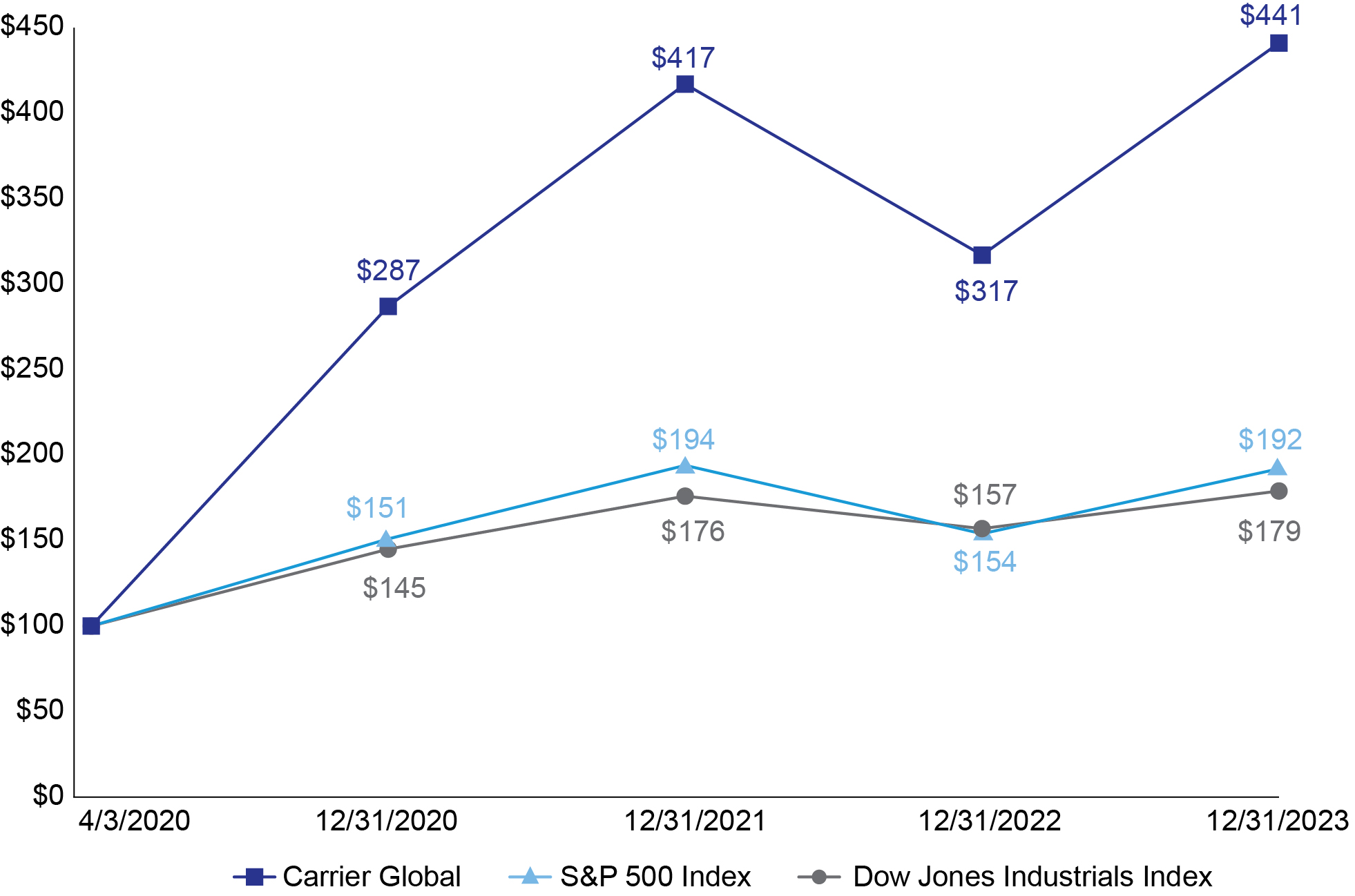
Compensation Discussion and AnalysisPerformance Goal Results and Payout Levels for the First Quarter of 20201FINANCIAL MEASURE3 WEIGHTING THRESHOLD
50% PAYOUT TARGET
100% PAYOUT MAXIMUM
200% PAYOUT PAYOUT PAYOUT RESULT
PERCENTAGEAdjusted Operating Profit at Constant Currency1 60% 
60% 36% Free Cash Flow2 40% 
200% 80% Annual Bonus (Q1) Earned payout
percentage for financial measures 116% 1Performance goals and results are based on non-GAAP financial measures, see Appendix A on page 74 for more details.Performance Goal Results and Payout Levels for Quarters 2-4 the Stub Period of 20201FINANCIAL MEASURE3 WEIGHTING THRESHOLD
50% PAYOUT TARGET
100% PAYOUT MAXIMUM
150% PAYOUT PAYOUT PAYOUT RESULT
PERCENTAGEAdjusted Operating Profit at Constant Currency 50% 
150% 75% Free Cash Flow2 50% 
150% 75% Annual Bonus (Stub Period) Earned payout
percentage for financial measures 150% 1Performance goals and results are based on non-GAAP financial measures, see Appendix A on page 74 for more details.2Carrier reported free cash flow for the stub period of $1.4 billion, which includes $272 million in tax payments related to the gain on the sale of Carrier’s shares in Beijer. Of the $272 million, the Committee approved the exclusion of $215 million from the calculation of free cash flow for purposes of the bonus plan performance measures.Overall Performance Payout Levels for 2020The resulting calculated payouts of each of the two performance periods resulted in an overall weighted average payout percentage of 141.5% of target (116% for Q1 2020 and 150% for the Stub Period Q2 – Q4), reflecting management’s exceptional delivery on financial targets and crisis management through a period of extreme uncertainty.Q1 (25%) Q2 – Q4 (75%)
“STUB PERIOD” FINAL CALCULATED PAYOUT 116% + 150% = 141.5% 20212024 Proxy Statement35 Discussion and AnalysisFinal Determination of the 2020 Annual Bonus Plan Payout Factor1Given the performance in the second half of 2020 against the revised stub period performance goals, the Committee conducted a thorough review of various payout scenarios compared to both original and revised performance goals. The Company’s performance relative to the original performance goals, previously established by UTC before any knowledge of the COVID-19 pandemic economic uncertainty, would have resulted in an overall payout of approximately 127.5% of target, as noted in the table below.In consideration of all relevant factors including the original performance goals and resulting payout against those goals, the Committee used its discretion to reduce the payout percentage and ultimately approved a Company Performance Factor of 120% of target, as it desiredProgram Overviewmanagement for producing resultsstrong financial performance that were significantly ahead of plan and guidance for the Stub Period, while also recognizing that the Company’s overall 2020 performance had been negatively impacted by the effects of the COVID-19 pandemic.FINANCIAL MEASURE WEIGHTING THRESHOLD
50% PAYOUT TARGET
100% PAYOUT MAXIMUM
150% PAYOUT PAYOUT PAYOUT RESULT
PERCENTAGEAdjusted Operating Profit at Constant Currency 50% 
55% 27.5% Free Cash Flow2 50% 
200% 100% Annual Bonus Earned payout percentage, for financial measures under original performance goals 127.5% 
In consideration of all relevant factors, the Committee used its discretion to reduce the payout percentage and ultimately approved a Company Performance Factor of 120% of target.Final CompanyPerformanceFactor120%1Performance goals and results are based on non-GAAP financial measures, see Appendix A on page 74 for more details.2Carrier reported free cash flow of $1.4 billion, which includes $272 million in tax payments related to the gain on the sale of Carrier’s shares in Beijer. Of the $272 million, the Committee approved the exclusion of $215 million from the calculation of free cash flow for purposes of the bonus plan performance measures.2020 Long-Term Incentive Awards “LTI”The UTC Compensation Committee did not grant PSUs to Carrier executives in early 2020 given the difficulty of establishing long-term performance goals prior to the Separation. As a result, 2020 annual LTI awards to Carrier executives, granted in February 2020, consisted of SARs (50%) and RSUs (50%). The Carrier Compensation Committee has, and will, continue to annually review the design of LTI awards to ensure consistency with the program’s fundamental objective of aligning the interests of executives and shareowners while attracting and retaining talented senior leaders. Annual LTI awards are subject to three-year, service-based (and in the case of PSUs, performance-based) vesting requirements, with exceptions for death, disability, retirement, change in control and certain qualifying involuntary terminations.The 2021 LTI awards to the CEO and NEOs will consist of 50% SARs and 50% PSUs in order to align with the company’s Compensation philosophy and guiding principles, with the goal of achieving long-term, sustainable growth and further linking interests of executives with shareowners.Treatment of Unvested UTC Equity Awards Upon SeparationIn connectionis aligned with the Separation, as established and approved by UTC, any unvested UTC equity awards held by Carrier executives were converted to unvested Carrier equity awards in accordance with the conversion methodology detailed in the Employee Matters Agreement between Carrier, UTC and Otis Worldwide Corporation (“Otis”).Unvested UTC SAR and RSU awards were converted into unvested Carrier SAR and RSU awards, respectively, and were adjusted in a manner that was intended to preserve the aggregate intrinsic value immediately after the Separation when compared to the aggregate intrinsic value immediately prior to the Separation.36Carrier Global CorporationCompensation Discussion and AnalysisUnvested UTC PSU awards were converted into unvested, time-based Carrier RSU awards with the number of shares subject to the award adjusted to preserve the aggregate intrinsic value of the original award.long-term, sustainable shareowner value. The conversion formula considered UTC’s performance during the period leading up to the Separation and assumed target-level performance for the remaininglargest portion of the performance period, resulting in performance factors of 119% and 122% for UTC PSUs granted in 2018 and 2019, respectively.All converted unvested equity awards remain subject to the same terms, vesting conditions and other restrictions that applied to the original UTC award immediately before the Separation.2020 CEO and NEO Compensation ChangesThe Separation from UTC and value creation opportunity for shareowners requires a highly experienced and capable executive team. Following the Separation, in April 2020, the Committee, along with its Independent Compensation Consultant, reviewed competitive market data and established compensation opportunities (base salary, annual bonus and long-term incentive targets) based on the following factors: expanded role scopes and breadth of the CEO and NEO’s responsibilities, strategic importance of the position, competitive market data, and a desire to ensure long-term retention. For a more detailed discussion of how we use peer group data see page 39.CEO Pay1As part of this review, and upon his appointment as President and CEO of the newly independent Carrier Global Corporation, the Committee increased Mr. Gitlin’s total target compensation opportunity to $11 million. This included an increase in base salary to $1.2 million, a target bonus opportunity increase to 150% of base salary, and a Long-Term Incentive target award increase to $8 million*. The Committee believes this target compensation opportunity, while still in the lower quartile for comparable positions at Compensation Peer Group companies, is appropriate given Mr. Gitlin’s increased responsibility as a new public company President and CEO.Other NEOsAlso as part of this review, and upon the appointments of Mr. Nelson and Mr. Appel as segment presidents of HVAC and, Refrigeration, respectively, for the newly independent Carrier, the committee increased the base salary and target bonus opportunities for them to reflect their expanded roles and responsibilities, and to ensure market competitive total compensation. Mr. Goris and Mr. O’Connor were recruited to the Company to lead their respective functions, based on more than 25 years, each, of relevant leadership, functional and business experience. Mr. Goris’ recruitment and hire followed the announcement of Mr. McLevish’s retirement from the Company planned for February 2021. Base salary and target bonus changes and 2020 pay impacts are noted in the 2020 CEO and NEO Actual Compensation section.All base salary increases for the CEO and NEOs were deferred until November 1, 2020 as partis at-risk compensation. As described in the table below, both our annual bonus and LTI awards are contingent on company performance relative to key financial metrics and multiyear cliff vesting requirements.Company’s compensation actions in response to the COVID-19 pandemic, at which time they were implemented with effect from November 1, 2020.Founder’s Grants2Following Separation, given the significant period of change for the Company, the need to focus on long-term growth and performance of the company, and to ensure clear alignment of2023 executive compensation with shareowner interests, the Committee, with advice from the Committee’s Independentprogram. These elements are intended to promote and reward financial performance through a variety of performance metrics and time horizons.Consultant, approved a one-time equity grant to select executives, including the CEO and NEOs active at the time of the grant, in connection with the Separation. The design of this program was based on benchmarking and an analysis of other recently separated and newly independent companies.NEOs active at the time of the grant received a combination of SARs and PSUs which vest after three years from the date of the grant. Commensurate with their scope of roles and external benchmarking, Mr. Gitlin received a Founder’s Grant in the amount of $3 million; Messrs. Appel, McLevish and Nelson each received a grant in the amount of $1.5 million; Mr. O’Connor received a grant in the amount of $1 million. PSU vesting is earned based on Carrier’s three-year Total Shareholder Return (TSR) relative to a subset of industrial companies in the S&P 500 index measured from May 2020 to May 2023. Payout opportunities under the Founder’s Grant are based on significant Company performance during the period, including target payouts for performance at the 60th percentile of peer group companies, and maximum payout for performance in the top 15% of peer group companies. Payouts are capped at a maximum of 100% if TSR is negative during the performance period, regardless of relative performance.1ELEMENT Mr. Gitlin originally received a $5 million annual grantPROGRAM COMPONENTS PERIOD CEO OTHER NEOs BASE
SALARYCash Fixed compensation component payable in February 2020, approved by UTCcashOne year 

ANNUAL
BONUSAt-Risk Pay Performance- Based Pay Cash Variable compensation component payable in cash based on performance against annually established goals and commensurateassessment of individual and business segment performanceOne year 

LONG-TERM
INCENTIVES
(LTI)Stock Appreciation Rights
(SARs)
50%Drive long-term stock price appreciation; align the interests of executives with his role as a Segment President for UTC. Following the Separation, in May 2020, the Carrier Compensation Committee, in conjunction with the Independent Compensation Consultant, approved a $3 million grantshareowners; serve to align Mr. Gitlin to his new annual LTI target of $8 million, in recognition of hisretain executive talentThree years 

Performance Share Units (PSUs)
50%Incentivize focus on long-term shareowner value creation through profitable growth and increase in scopeshare price over time; promote retention through long-term performance achievement and responsibility as President and CEO of the newly independent Carrier Global Corporation.vesting requirementsThree years 2These values differ from the corresponding values reported in the Summary Compensation Table and the Grants of Plan-Based Awards Table due to different methodologies used in assigning the economic value of equity-based awards required for accounting and proxy statement reporting purposes. For accounting and proxy purposes, the value of SARs reflects the grant date fair value based on a binominal lattice model, and the grant date fair value of the PSUs are based on a Monte Carlo simulation we use to value the awards that considers award performance metrics, maximum and target payouts among other factors.2021 Proxy Statement37CEO 2023 Other NEOs 2023 
36 Carrier Global Corporation Compensation Discussion and AnalysisRELATIVE TSR PERCENTILE(S&P 500 SUBSET OF INDUSTRIAL COMPANIES)PSU PAYOUT PERCENTAGE≥85thMaximum – 200%60thTarget – 100%35thMinimum – 25%<35th0%Compensation Setting at CarrierThe Committee works in close partnership with the Independent Compensation Consultant and management to establish and administer the Company’s executive compensation programs through the annual compensation review cycle, with compensation decisions underpinned by appropriate review of external market data and peer group companies, as described in detail below.KEY PARTICIPANTS PRIMARY ROLES AND RESPONSIBILITIES RELATING TO EXECUTIVE COMPENSATION DECISIONS •Company,company, the business unitssegments and the CEO as they relate to the annual and long-term incentive programs.•plans Company,company, business unitsegment and NEO performance relative to the pre-established goals and objectives set for the year.•Approvesyeardata.•data ELTExecutive Leadership Team ("ELT") members and executive officers and makes adjustments, as appropriate.•appropriate officers. •officers stockshare ownership requirements, perquisites and supplemental benefit arrangements.•arrangements practices.•practices inputinputs regarding executive compensation decisions and policies.•policies directors.directorsConsultant•Consultant*Compensation Committee concerning our compensation levels and our compensation programs.•programs Compensation Committee.CommitteeCEO and Management •Considermember/member and executive officer, his or hertheir business unitsegment and/or function, market benchmarks, internal equity and retention risk when determining pay recommendations.•PresentrecommendationsNEOs, ELT members and executive officers.•Doofficerscompensation.•compensation Independent Compensation Consultant, provideCommittee's independent compensation consultant, provides insight on program design and compensation market data to assist the Committee with its decisions.38Carrier Global Corporationdecisions Compensation Discussion and AnalysisIndependent Compensation ConsultantIn anticipation of* During 2023, the Separation,Committee was assisted by Pearl Meyer, & Partners (“Pearl Meyer”) was retained by the UTC Compensation Committee to serve as the initial compensation consultant to the Committee commencing on the Separation. After the Separation, the Committee reviewed and determined to retain Pearl Meyer to serve as its independent compensation consultant for 2020. Although Pearl Meyer may make recommendations on the form and amount of compensation, the Committee makes all decisions regarding the compensation of the CEO, NEOs, other ELT members, and executive officers.During 2020, Pearl Meyer advised the Committee on a variety of subjects, including compensation plan design and trends, pay-for-performance analytics, benchmarking data and related matters. Pearl Meyer reportswho reported directly to the Committee, participates inattended all Compensation Committee meetings as requested, and communicatescommunicated with the Committee Chair between meetings, as necessary. A Pearl Meyer representative attended each of the four Committee meetings in 2020.doesdid not perform other services for or receive other fees from Carrier. The Committee therefore determined that Pearl Meyer qualified as an independent consultant. The Committee has the sole authority to modify or approve Pearl Meyer’s compensation, determine the nature and scope of its services, evaluate its performance, terminate the engagement and hire a replacement or additional consultant at any time.and the Committeealso reviews and approves compensation for NEOs, non-NEO ELT members and other executive officers. Additionally, the Committee approves incentive plan designs, includingwhich include establishing performance measures, weightings and targets for annual bonus compensation and PSUs,LTI, setting target compensation values, granting equity awards and determining payouts, as well as determining the types and levels of benefits.
2024 Proxy Statement 37 How We Use Peer Group DataIn reviewing competitive compensation levels for 2020 after the Separation, the Committee considered the Compensation Peer Group (“CPG”) data for the CEO and other NEOs. The Committee compared the executive compensation program to those at the 18 companies that make up the CPG, which was chosen by the UTC Compensation Committee prior to the Separation. As a result of this comparison, the Committee made certain adjustments to 2020 compensation levels for NEOs as described above under “2020 CEO and NEO Compensation Changes”. sufficiently competitive executive compensation program, the Committee believes the target value of each principal element of compensation (i.e., base salary, target annual bonus and target LTI award value) should approximate the market median of the companies whichthat Carrier views as competitors for executive talent. The Committee will annually evaluateevaluates each compensation element relative to the market for each ELT member’s role and adjustadjusts, as necessary. However, individual compensation may vary from market median benchmarks based on the Committee’s assessment of other factors that it determines to be relevant, including business unit/segment/function and individual performance, job scope, retention risk, internal pay equity, versatility of skills and experience in a role.2021 Proxy Statement39TableTo establish the competitive market rate for each of ContentsCompensation Discussion and AnalysisHowthe principal components of ELT compensation, the Committee selects a group of publicly traded companies referred to as the "Compensation Peer Group." The Committee annually reviews the Compensation Peer Group is ConstructedTheto maintain relevancy and to ensure the availability of data, while seeking to avoid significant changes in the Compensation CommitteePeer Group to ensure a level of UTC approved a 2020 CPG for Carrier before the separation. These companies were selected based on the following criteria: similarity to Carrier in size, geographic footprint and operational complexity, considering factors such as revenue, market capitalization, global scope of operations, manufacturing footprint and research and development activities. The 2020 CPG was used solely for the purpose of benchmarking executive compensation.2020 Compensation Peer Group• 3M Company• Fortive Corporation• Parker Hannifin Corporation• Cummins Inc.• Honeywell International Inc.• Rockwell Automation, Inc.• Danaher Corporation• Illinois Tool Works Inc.• Stanley Black & Decker, Inc.• Dover Corporation, Inc.• Ingersoll-Rand• TE Connectivity• Eaton Corporation• Johnson Controls International Inc.• Western Digital Corporation• Emerson Electric Co.• Lear Corporation• Whirlpool Corporation2020year-over-year comparison.CARRIER CARRIERPERCENTILE RANKING Revenue ($M)$18,173
12 of 19Market Capitalization ($M)$32,691
9 of 191.Revenues are stated in millions for the latest four quarters disclosed as of January 22, 2021. Market capitalization stated in millions as of December 31, 2020.In June 2020, the Committee approved a revised CPG made up of 16 companies, as shown in the following table. Companies added to the CPG compete with Carrier for executive talent and are similar to Carrier in industry, business model, revenue and/or market capitalization. Companies removed from the CPG generally were removed due to mergers and acquisitions activity, and/or business, revenue and/or market capitalization disparity. The revised CPG was used for purposes of benchmarking compensation for the 2021 programs.2020 Revised • Revenue
($M)$22,098 
Company• Co.• Dover Inc.• Eaton Corporation• plc• Fortive Corporation• • • Inc.• plc
Corporation•
Corporation•
Decker, Inc.• Rockwell Automation, Inc.• •
Ltd.• plcMarket
Capitalization
($M)$48,203 
40Carrier Global CorporationCompensation DiscussionDecember 31, 2023.Analysis2020NEO Compensation OverviewCarrier’sprograms are designed to reward strong financial performance that is aligned with long-term, sustainable shareowner value. The largest portion of compensationprogram for the CEO and NEOs, is “at-risk” compensation — both annual bonus awards and LTI awards that are contingent on Company performance relative to key financial metrics and/or multi-year time-based vesting requirements.In accordance with the principle of aligning pay with performance, the Carrier Board, at the Committee’s recommendation, approved an annualized total target direct compensation package for the CEO, of which 89% is ‘at risk’. In addition, in 2020, approximately 80% of total target direct compensation for other NEOs (on average, excluding Mr. McLevish) was ‘at risk’. Under the annual bonus and LTI plans, compensation is considered to be ‘at risk’ because it is performance-based (payouts depend on achievement relative to pre-established performance goals), subject to time-based vesting requirements (equity awards subject to forfeiture if vesting requirements are not met and the risk of a potential decrease in the Company stock price), and/or is subject to restrictive covenants and clawback provisions.The following table summarizes the principal componentsexecutives, primarily consists of the 2020 executive compensation program. These elements are intended to promotefollowing elements:reward financial performance through a variety of performance metrics and time horizons.2020 TOTAL TARGET DIRECTCOMPENSATION MIXELEMENTFORM OFAWARD1PROGRAM COMPONENTSPERIODCEOOTHER NEOS2,3BASE SALARYCashFixed compensation component payable in cashOne year

ANNUAL BONUSCashVariable compensation component payable in cash based on performance against annually established goals and assessment of individual and business unit performanceOne year

At-Risk PayPerformanceBasedLONG-TERMINCENTIVE (LTI)SARs (50%)Drive long-term share price appreciation; align the interests of executives with shareholders; serve to retain executive talentVest after threeyears

RSUs (50%)Realized value based on our stock price performanceVest after threeyears1The Compensation Committee of UTC did not grant Performance stock Units (PSUs) to Carrier executives in early 2020 given the difficulty of establishing long-term performance goals in the face of the Separation. As, a result, 2020 LTI awards to Carrier executives (granted in February 2020) consisted of SARs (50%) and RSUs (50%). 2021 annual equity grants included a mix of SARs (50%) and PSUs (50%) to ensure alignment with the goal of achieving long-term, sustainable growth and further linking interests of executives with shareowners.2For the calculations above, total target direct compensation for fiscal year 2020 includes annual base salary, the target value of annual bonus compensation and the target value of annual cycle awards of long-term equity-based incentive compensation; but does not include the target value of other special, one-time grants such as sign-on, retention, or Founder’s Grants.3Data for Mr. McLevish was excluded from the compensation mix calculations in order to reflect only one CFO; Mr. McLevish’s at risk pay comprised 86% of his total target direct compensation.2021 Proxy Statement41
50% PSUs (using the company's methodology described below)
2023 Base SalaryCompensation Discussion and Analysis2020 CEO and NEO Actual CompensationThe compensation program for the CEO and NEOs, and other executives, primarily consists of base salary, annual bonus and long-term incentive compensation.The overall objective of the compensation program is to encourage and reward the creation of sustainable, long-term shareowner value. The current elements of the executive compensation program directly align the interests of the executives and shareowners, are competitive, motivate achievement of short- and long-term financial goals and strategic objectives and align realized pay with performance.2020 Base Salary2020 CEO and NEO Compensation ChangesAs previously mentioned, following the Separation, in April 2020, the Committee, along with its Independent Compensation Consultant, reviewed competitive market data and established compensation opportunities (base salary, annual bonus and long-term incentive targets) based on the following factors: expanded role scope and breadth of the CEO’s and NEOs responsibilities, strategic importance of the position, competitive market data, and a desire to ensure long-term retention.As part of this review, and upon his appointment as President and CEO of the newly independent Carrier Global Corporation, the Committee increased Mr. Gitlin’s total target compensation opportunity to $11 million. This included an increase in base salary to $12 million, a target bonus opportunity increase to 150% of base salary, and a Long-Term Incentive target award increase to $8 million.Committee’sBoard’s determination of his own compensation. Actual salaries may vary from market median based on factors such as job scope and responsibilities, experience in role, breadth of skills, tenure, individual performance, retention risk and internal pay equity.As part of company-wide cost control measures related to In 2023, the COVID-19 pandemicCommittee recommended and the related economic downturn, the base salaries of the CEO and NEOs were reduced by 15% between May 1, 2020 and October 31, 2020. The Committee decided to end the temporary salary reductions with effect from November 1, 2020, as it became apparent that the Company was maintaining stronger than expected performance. In addition, planned 2020 annualBoard approved an increase in Mr. Gitlin's base salary increases for NEOs were delayed until November 1, 2020.38 Carrier Global Corporation fiscal year 20202022 and 2023 annual base salary for each NEO. NEO APRIL 3, 2020
BASE SALARY1MAY 1, 2020 TEMPORARY
BASE SALARY %
REDUCTIONNOVEMBER 1, 2020
BASE SALARY2 David Gitlin $1,000,000 (15%) $1,200,000 Patrick Goris3 – – $700,000 Kevin J. O’Connor3 $650,000 (15%) $650,000 David Appel $546,000 (15%) $600,000 Christopher Nelson $600,000 (15%) $650,000 Timothy McLevish3 $800,000 (15%) $800,000 1Base salary at time of the Separation.2Base salary following reinstatement of base salary reductions and implementation of deferred and approved 2020 increases, with effect from November 1, 2020.3Mr. Goris’ hire date was November 16th, 2020; Mr. O’Connor was not eligible for a 2020 merit increase due to his hire date of January 2, 2020 Mr. McLevish was not eligible for a 2020 merit increase due to his planned retirement in February 2021.42Carrier Global Corporation
Base salary adjustments became effective on April 1, 2023.NEO ANNUAL BASE SALARY
AS OF 12/31/2022 ($)ANNUAL BASE SALARY
AS OF 12/31/2023 ($)PERCENT
INCREASEDavid Gitlin 1,350,000 1,400,000 3.7 % Patrick Goris 760,000 800,000 5.3 % Jurgen Timperman 620,000 650,000 4.8 % Timothy White 620,000 644,800 4.0 % Kevin O'Connor 681,000 708,000 4.0 % 715,000 — — Compensation Discussion and Analysis2020Objectives•Establishes challenging but achievable performance goals that are consistent with the Committee’s assessment of opportunities and risks for the upcoming year, as communicated to investors.•Sets annual bonus targets for executives that are market competitive.•Allows the Committee to make discretionary adjustments if it determines that measured performance does not fully align with its assessment of overall performance.peer groupCompensation Peer Group median.20202023 annual bonus targets for each NEO are shown below. The Committee electedMr. Gitlin's annual bonus target was increased from 160% to increase175% to align his target with that of his peers in the target award percentageCompensation Peer Group.NEO 2023 ANNUAL BONUS
TARGET VALUE
(AS % OF BASE SALARY)2023 ANNUAL BONUS
TARGET VALUE ($)David Gitlin 175 % 2,450,000 Patrick Goris 100 % 800,000 Jurgen Timperman 90 % 585,000 Timothy White 90 % 580,320 Kevin O'Connor 80 % 566,400 — — each of Messrs. Gitlin, Appel, and Nelson in 2020 based on market analysis and input from its independent compensation consultant to ensure appropriate external alignment based on the scope of their respective positions.NEO PRE-SEPARATION POST-SEPARATION 2020 BLENDED David Gitlin 125% 150% 143.75% Patrick Goris Not eligible for 2020 bonus Kevin J. O’Connor 80% 80% 80% David Appel 60% 90% 82.5% Christopher Nelson 80% 90% 87.5% Timothy McLevish 100% 100% 100% Background on Financiala 2023 Annual Bonus payout.2024 Proxy Statement 39 Goals*Relative WeightingADJUSTED OPERATING PROFITDEFINITIONFREE CASH FLOWWEIGHTHow areSalesSales (a GAAP measure) adjusted for the impact of foreign exchange, acquisitions and/or divestitures. 1/3 The Committee believes sales performance metrics defined for annual bonus purposes?aligns with the company’s focus on organic growth which can be increased by improving market share, introducing new products and services, entering new markets, and pricing effectively.Adjusted Operating Profit Carrier’s adjusted operating profit at constant currency represents operatingOperating profit (a GAAP measure), excluding restructuring costs, amortization of acquired intangibles, and other significant items of a non-recurring and/or non-operationalnonoperational nature at a fixedand further adjusted for the impact of acquisitions, divestitures, foreign currency translation rate.exchange and other items.Carrier’s free cash flow1/3The Committee believes that adjusted operating profit is an appropriate operating earnings goal because it measures the effectiveness and efficiency of our core operations. Free Cash Flow (FCF) , represents netNet cash flows provided by operating activities (a GAAP measure) less capital expenditures.Why did the Committee select these metrics?While this metric was initially adopted by the UTC Compensation Committee, the Carrier Committee believes thatexpenditures and further adjusted operating profit at Constant Currency is an appropriate Carrier-wide operating earnings goal because it measures the performance of Carrier’s core operations and excludes non-recurring and/or non-operational items andfor the impact of foreign currency translation.exchange, acquisitions and/or divestitures and related transaction costs.While this metric was initially adopted by the UTC Compensation Committee, the1/3The Committee believes that FCF performance is a relevant measure of the ability to generate cash to fund operations and key strategic and business investments. Why does the Company use non-GAAP financial performance goals for annual bonus purposes?The Committee believes annual bonuses should not be positively or negatively impacted by short-term decisions made in the best interest of Carrier’s long-term business strategies. Using non-GAAP performance measures encourages decision-making that considers long-term value creation that does not conflict with annual bonus metrics. Adjustments for restructuring; non- recurring and other significant, non-operational items; and acquisitions and divestures provide a more relevant assessment of business performance and aligns compensation opportunities with the non-GAAP financial expectations we communicate to investors.2021 Proxy Statement43Compensation Discussion1Performance goals and AnalysisADJUSTED OPERATING PROFITFREE CASH FLOWHow did the UTC Compensation Committee set performance goals in Q1?An adjusted operating profit at constant currency goal was set to align with the performance expectations communicated to investors for the year. The original goal set by the UTC Compensation Committee was adjusted post-Separation.The Carrier FCF goal was set to align with the performance expectations communicated to investors for the year. The original goal set by the UTC Compensation Committee was adjusted post-Separation.How did the Carrier Compensation Committee set performance goals in the Stub Period (Q2-Q4)?At the time of the Separation, it was expected that the COVID-19 pandemic would have a dramatic impact on the Company’s 2020 financial results. Accordingly, in order to reflect the anticipated impact of COVID-19 pandemic on the Company, the Committee bifurcated 2020 into two separate performance periods, with one comprised of the first quarter of 2020, for which the pre-spin performance goals established by UTC applied, and one comprised of the remaining three quarters of 2020 (the “Stub Period”), for which the modified performance goalsresults are based on non-GAAP financial measures and additional adjustments as approved by the Committee post-Separation applied. Additionally, in light of the reset plan, the Committee reduced the maximum payout opportunity for the Stub Period by 50%, from 200% to 150%.What goals applied for 2020?Original plan (locked at a fixed currency translation rate) approved by UTC: $2,713MQ1: $473M;Stub Period (Q2 – Q4): $2,240MRevised Q2 – Q4: $1,415MOriginal plan approved by UTC: $1,307MQ1: ($218M)Stub Period Q2 – Q4: $1,525MRevised Q2 – Q4: $1,079M*Performance goals and results are based on non-GAAP financial measures, see Appendix A on page 74 for more details.As previously mentioned, the calculated payoutCommittee. See Appendix A beginning on page 76 for 2020 bonus awards was 127.5% againstmore details.original 2020 financial targets and reweighted metrics, and 141.5% against the revised plan design and revised financial metrics due to COVID-19 pandemic. The Committee used its discretion to reduce the final payout percentage and ultimately approved a2023 Company Performance Factor, Messrs. Gitlin, Goris and O'Connor, as corporate NEOs, were measured on corporate financial metric goals. Messrs. White and Timperman, as business segment NEOs, were measured on an equally weighted combination of 120%corporate financial metric goals (50%) and their respective business segment financial metric goals (50%).Corporate NEOs Business Segment NEOs 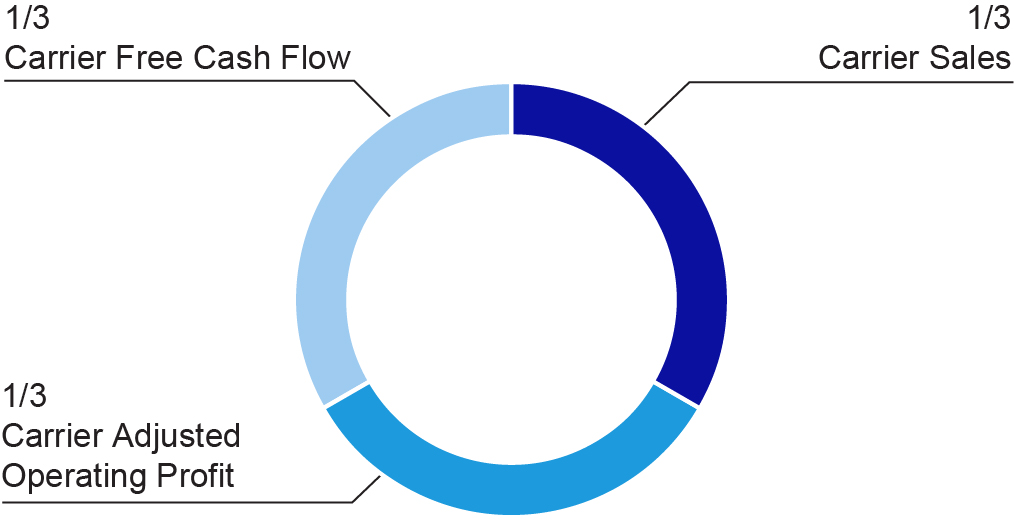

target, as it desiredCarrier's priorities and goals. As a part of the individual performance factor portion of the 2023 Annual Bonus Plan ("Individual Performance Factor"), each NEO's progress against these goals can result in upward or downward adjustments to reward management for producing results that were significantly ahead of plan and guidance for the Stub Period, while at the same time recognizing that the Company’s overall 2020 performance had been negatively impactedNEO's calculated annual bonus payout determined by the effects of the COVID-19 pandemic.Pool DeterminationBase Salary $ x Annual Bonus Target % x
Factor Weightx Individual Performance
Factor %= Final Annual Bonus Payout $ funding poolannual bonus award for the Bonus Planeach executive is calculated by first multiplying each executive’s annual base salary by his annual bonus target value (base salary x annual bonus target)percentage, multiplied by the applicable Company performance factorPerformance Factor approved by the Committee.Committee, which takes into account business segment performance results if applicable. An Individual Performance Factor is then applied, resulting in a participant's final annual bonus payout. An individual participant's annual bonus payout cannot exceed 200% of such participant's annual bonus target value.40 Carrier Global Corporation amountstargets are then aggregatedaligned with shareowner value creation and are intended to determinebe stretch but achievable. The Committee has the total funding pool from whichauthority to reduce the final Company Performance Factor if it believes measured financial performance does not align with its assessment of overall performance.bonussales and adjusted operating profit targets, and almost achieved maximum payout for eligible executives will be paid.WEIGHTING THRESHOLD
50% PAYOUTTARGET
100% PAYOUTMAXIMUM
200% PAYOUTACHIEVEMENT COMPANY
PERFORMANCE
FACTORSales 1/3 
110.0% 36.7% Adjusted Operating
Profit1/3 
124.0% 41.3% Free Cash Flow 1/3 
195.0% 65.0% Final Company Performance Factor: 143.0% make a discretionarymakes an adjustment to increase or decrease the Individual Performance Factor and final annual bonus calculated relative to the executive’s individual performance.payout. The Committee considers these recommendations and makes any adjustments it deems appropriate. Mr. Gitlin has no role in the Committee’s determination of his own annual bonus.final 2020 CompanyBoard of Directors assigned an Individual Performance Factor was 120%, which was used to determine the total funded pool from which the annual bonuses were paid. The Committee assigned an individual performance factor of 100% for Mr. Gitlin. The CEO, based on his assessment of individual performance, assignedrecommended to the Committee individual performance factors of 100% for each of the eligible NEOs reflective of which the averagetheir individual performance, factordelivery on strategic objectives and overall contributions toward achieving the company’s 2023 financial goals.allthe CEO and NEOs are noted below.NEO David Gitlin 175 % 2,450,000 143.0 % 100.0 % 143.0 % 3,503,500 Patrick Goris 100 % 800,000 143.0 % 100.0 % 143.0 % 1,144,000 Jurgen Timperman 90 % 585,000 143.0 % 100.0 % 143.0 % 836,550 Timothy White 90 % 580,320 105.0 % 100.0 % 105.0 % 609,340 Kevin O'Connor 80 % 566,400 143.0 % 100.0 % 143.0 % 809,960 — — — — — — 101%.NAME TARGET BONUS AMOUNT COMPANY
PERFORMANCE FACTORINDIVIDUAL PERFORMANCE
FACTORFINAL 2020 BONUS AWARD
(WITH COMPANY AND INDIVIDUAL
PERFORMANCE FACTOR APPLIED)David Gitlin $1,725,000 100% $2,070,000 Patrick Goris1 — — — Kevin J. O’Connor $520,000 120% 100% $624,000 David Appel $495,000 103% $611,820 Christopher Nelson $568,750 108% $737,100 Timothy McLevish $800,000 95% $912,000 12024 Proxy Statement Mr. Goris was not eligible for 2020 Bonus given his hire41METRIC WEIGHTING RATIONALE FEATURES SARs Not applicable 50% Stock price appreciation November 16, 2020.grantPSUs Adjusted Earnings Per Share (“EPS”) Compound Annual Growth Rate (“CAGR”) 25% Stock price appreciation motivates achievement of long-term business strategy PSUs 25% Stock price appreciation motivates achievement of long-term business strategy 443M Co. Emerson Electric Co. Johnson Controls International plc Snap-On Incorporated A. O. Smith Corporation Fortive Corporation Masco Corporation Stanley Black & Decker, Inc. Allegion plc Generac Holdings Inc. Nordson Corporation Trane Technologies plc Ametek, Inc. General Electric Co. Otis Worldwide Corporation Wabtec Corporation Caterpillar Inc. Honeywell International Inc. PACCAR Inc. Xylem Inc. Cummins Inc. IDEX Corporation Parker Hannifin Corporation Dover Corporation Illinois Tool Works Inc. Pentair plc. Eaton Corporation plc Ingersoll-Rand Inc. Rockwell Automation, Inc 42 Carrier Global Corporation Compensation Discussionshares earned will be interpolated for results between those percentiles. If performance shares are earned but our absolute TSR is negative, the number of shares earned for the portion tied to Relative TSR will be capped at target.THRESHOLD TARGET MAXIMUM Carrier Global Corporation TSR Performance Relative to a Subset of the S&P 500 Industrials Index Percent of Target Shares Earned 25% 100% 200% AnalysisAnnual Long-Term Incentive AwardsThe table below shows the fiscal yearFounder’s Grant PSU Resultslong-term incentive awards for each NEO.NEO2020 LONG-TERM INCENTIVE AWARD GRANTAS APPROVED BY UTC, PRIOR TO SEPARATIONDavid Gitlin1$8,000,000Patrick Goris2—Kevin J. O’Connor$1,700,000David Appel$703,000Christopher Nelson$1,700,000Timothy McLevish$3,500,0001Mr. Gitlin originally received a $5 million annual grant in February 2020, approved by UTC and commensurate with his role as a Segment President for UTC. Following the Separation, in May 2020, the Committee, in consultation with the Independent Compensation Consultant, approved a $3 million grant to align Mr. Gitlin to his new annual LTI target of $8 million, in recognition of his increase in scope and responsibility as President and CEO of the newly independent Carrier Global Corporation.2Mr. Goris was not eligible for 2020 LTI award given his hire date of November 16, 2020.Other Compensation ElementsRetirement and Deferred Compensation BenefitsIn connection with the Separation from UTC, the CEO and a select group of other executives received a one-time equity grant (the "Founder's Grant"). The Founder's Grant was issued as a combination of SARs and PSUs which vested on May 13, 2023, three years from the date of the grant. The PSU portion of the Founder's Grant vested based on Carrier’s three-year Total Shareholder Return (TSR) relative to a subset of industrial companies in the S&P 500 index measured from May 2020 to May 2023. Payout was satisfied at the maximum 200% since the rTSR percentile was above the 85th percentile. Among our NEOs, Messrs. Gitlin, O'Connor, Timperman and Nelson received the Founder's Grant.WEIGHTING THRESHOLD
25% PAYOUTTARGET
100% PAYOUTMAXIMUM
200% PAYOUTACHIEVEMENT PERFORMANCE
FACTORRelative TSR Percentile 100% <35th 
200.0% 200.0% WEIGHTING TARGET
100% PAYOUTMAXIMUM
200% PAYOUTACHIEVEMENT 50% 
200.00% 100.0% Relative TSR Percentile 50% <25th 
170.97% 85.5% Final Performance Factor: 185.5% 2021 PERFORMANCE PEER GROUP FOR RELATIVE TSR ("rTSR") 3M Co. Emerson Electric Co. Illinois Tool Works Inc. Roper Technologies, Inc. A. O. Smith Corporation Fastenal Co. Ingersoll-Rand Inc. Snap-On Incorporated Allegion plc Flowserve Corporation Johnson Controls International plc Stanley Black & Decker, Inc. Ametek, Inc. Fortive Corporation Masco Corporation Trane Technologies plc Caterpillar Inc. Fortune Brands Innovations, Inc. PACCAR Inc. Wabtec Corporation Cummins Inc. General Electric Co. Parker-Hannifin Corporation W. W. Grainger, Inc. Dover Corporation Honeywell International Inc. Pentair plc. Xylem Inc. Eaton Corporation plc Johnson Controls International plc W. W. Grainger, Inc. 2024 Proxy Statement 43 NEO TARGET VALUE OF SARs ($) TARGET VALUE OF PSUs ($) David Gitlin 5,575,000 5,575,000 11,150,000 Patrick Goris 1,400,000 1,400,000 2,800,000 Jurgen Timperman 950,000 950,000 1,900,000 Timothy White 800,000 800,000 1,600,000 Kevin O'Connor 850,000 850,000 1,700,000 1,400,000 1,400,000 2,800,000 44 Carrier Global Corporation adopted compensation andNEOs are eligible for company-provided benefit plans, including a qualified 401(k) savings plan, health and welfare benefits, deferred compensation, and other nonqualified supplemental retirement plans. NEOs generally participate in these plans on the same basis as other eligible U.S. salaried employees. Our Deferred Compensation Plan offers deferral opportunities for base salary and annual bonus compensation. Our nonqualified supplemental retirement plans similaruse the same formula as our qualified savings plan to thoseprovide benefits that were in effect at UTC beforemay not be paid under our qualified savings plan due to annual limitations imposed under the Separation, except that Internal Revenue Code ("IRC").did not adoptalso continues to pay benefits under a nonqualified defined benefit plan similar(the Pension Preservation Plan, or "PPP") to eligible employees hired prior to January 1, 2010. Benefits are calculated using a final average earnings or cash balance formula based on dates of hire, and all future benefit accruals were frozen effective December 31, 2019. Messrs. Gitlin and Nelson are the UTC Pension Planonly NEOs eligible for non-represented employees.Below are brief descriptions of each retirement and deferred compensation arrangement that Carrier sponsors for its US employees. Seebenefits under the PPP. More information about their benefits can be found in the Pension Benefits and the Nonqualified Deferred Compensation sectionsTable on pages 57-5853 and 54, respectively.more details.PLANDESCRIPTIONPension Preservation Plan (“PPP”)An unfunded, nonqualified defined benefit plan that provides retirement benefits that were accrued under the UTC Pension Plan to employees hired prior to January 1, 2010. Participants hired by UTC prior to July 1, 2002 accrued benefits using a final average earnings (“FAE”) formula until December 31, 2014, at which time they transitioned to a cash balance benefits formula that was already in effect for participants hired on or after July 1, 2002. Under the cash balance formula, participants earned two types of credits — pay credits and interest credits. Effective December 31, 2019, benefit accruals under this plan were frozen, other than with respect to the continued accrual of interest credits.Carrier Retirement Savings PlanA tax-qualified defined contribution plan that permits eligible employees to defer up to 50% of their compensation (22% for highly compensated employees) which consists of base salary plus annual bonus. Non-represented employees receive an employer matching contribution equal to 60% of the first 6% of compensation contributed to the plan by the employee. All NEOs are eligible to receive an age-based Company automatic contribution (ranging from 3% to 8% of earnings) to their Carrier Retirement Savings Plan account.Carrier Represented Employee Pension PlanA tax-qualified defined benefit pension plan for represented employees that is closed to new entrants. Eligible employees receive a pension benefit using benefit formula based on years of service and multiplier negotiated with their respective union. No NEOS are eligible for this plan.Carrier Savings Restoration Plan (“SRP”)An unfunded, nonqualified plan that permits eligible employees to defer up to 6% of their compensation to the extent such compensation exceeds the IRC compensation limit applicable to the qualified Carrier Retirement Savings Plan. The plan also provides employer matching contributions at the same rate that would have been provided in the Carrier Retirement Savings Plan, if not for the IRC compensation limits.Carrier Company Automatic Contribution Excess Plan (“CACEP”)An unfunded, nonqualified plan providing the age-based Company automatic contributions eligible employees would have received under the Carrier Retirement Savings Plan, if not for IRC compensation and contribution limits. The plan also provides missed matching contributions for employees whose contributions to the Carrier Retirement Savings Plan are limited by the IRC contribution limits.Carrier Deferred Compensation Plan (“DCP”)An unfunded, nonqualified plan that allows eligible employees to defer up to 50% of base salary and up to 70% of annual bonus compensation. To the extent that the amounts deferred would have been matched if made under the Carrier Retirement Savings Plan or Carrier Savings Restoration Plan, the plan also provides for employer matching contributions at the same rate.Carrier LTIP PSU Deferral PlanAn unfunded, nonqualified plan that allows eligible employees to defer between 10% and 100% of their vested PSU awards. Upon vesting, the deferred portion of each PSU award is converted into deferred stock units that accrue dividend equivalents.2021 Proxy Statement45
up to 50 hours per year. Personal use of the corporate aircraft is generally prohibited for other NEOs, except in rare situations and with preapproval by the CEO.Compensation Discussionbase salary and AnalysisPerquisitescertain buy-up options. Messrs. Gitlin, Nelson and Other BenefitsWe provideTimperman also are eligible for a grandfathered disability benefit inherited from UTC upon the CEO and NEOs with the following benefits,Separation in 2020 equal to 80% of base salary plus target bonus compensation.the Committee believes contribute to attraction and retention.PERQUISITE/BENEFITS*DESCRIPTIONLife InsuranceNEOs are eligible to participate in the same life insurance program offered to other employees. As part of the Legacy UTC Compensation Arrangements discussed below, Mr. Gitlin also has company-funded life insurance coverage up to three times his base salary at age 62 (projected or actual) (the “CEO Life Insurance Policy”).Long-Term DisabilityNEOs are eligible to participate in the same company-funded long-term disability program as other employees, with a basic annual benefit upon disability that is equal to 60% of base salary, and certain buy-up options. Messrs. Gitlin, O’Connor, Appel, and Nelson are also eligible for a grandfathered benefit equal to 80% of base salary plus target bonus compensation that was inherited from UTC.Executive PhysicalNEOs are eligible for a comprehensive annual executive physical.Executive Leased VehicleNEOs receive an annual allowance toward the cost of a leased vehicle. The value of the allowance varies by NEO. Lease payments above the annual allowance are paid directly by the executive.Financial PlanningNEOs are eligible to receive an annual financial planning benefit.Personal Aircraft UsageThe CEO is allowed personal use of the Corporate aircraft for up to 50 hours per year. The Committee believes this optimizes the efficient use of the CEO’s time. The CEO can approve personal use of Corporate aircraft for directors, including the Executive Chairman, and other employees. During the critical period immediately following the Separation when commercial air travel was curtailed and/or compromised as a result of COVID-19 pandemic and Company travel restrictions imposed due to health and safety concerns, the CEO authorized limited use of the Corporate aircraft for employees that were in the process of relocating and needed to travel to Company headquarters for business reasons. The Company worked with its outside tax and legal consultants to ensure that all travel on the corporate aircraft during that time was appropriately classified and reported as imputed income.*See footnote (5) to the Summary Compensation Table on page 51 for more details on these perquisites/benefits.Change in Control Arrangementsnonot entered into employment agreements with any of the NEOs. We may provide at-will offer letters to newly hired executive officers. We also do not have any agreements that would provide automatic “single-trigger” accelerated vesting of equity compensation or excise tax gross-up payments to any NEOs in the event of a change in control of the Company.Offer Lettercompany.Patrick Goris, Retirementexit the Fire & Security businesses, the Committee in 2023 approved a performance incentive and retention bonus arrangement for Mr. Timperman. Under this arrangement, Mr. Timperman has the opportunity to earn a cash bonus award if Fire & Security achieves performance above the financial plan targets for adjusted operating profit and free cash flow (“Performance Bonus”) in 2023 and 2024. The financial plan targets reflect Carrier’s internal business plan targets, for which achievement above these targets is challenging, yet achievable. Since Fire & Security achieved the financial plan targets in 2023, the corresponding portion of Timothy MclevishCarrier extended an offer letterthe Performance Bonus is reflected in the Summary Compensation Table for Mr. Timperman, but under the terms of the arrangement, payment will not be made until the earlier of the certification of the 2024 financial plan results or the completion of the divestiture of Fire & Security, with completion date to be as defined by the company.Goris, Senior Vice PresidentTimperman will be eligible for a cash bonus following completion of the company’s exit of Fire & Security (“Deal Bonus”), subject to his continued employment. The maximum bonus opportunity over a multiyear period, for both the Performance Bonus and Chief Financial Officerthe Deal Bonus, is $2.5 million, which the Compensation Committee determined is commensurate with the additional challenges and responsibilities required of Carrier,Mr. Timperman in connection with the efforts to exceed financial plan targets, while concurrently leading efforts to divest Fire & Security.commencementenhanced 2023 awards were forfeited.2024 Proxy Statement 45 employmentthe Board approved supplemental equity awards ("Supplemental Equity Awards") for Mr. Gitlin and Mr. Goris. As Carrier is implementing a significant portfolio transformation, further described on November 16,page 7, to drive profitable growth and create substantial value for shareowners. Carrier is at a pivotal moment in this portfolio transformation with the acquisition of Viessmann Climate Solutions and the divestiture of its Fire & Security and commercial refrigeration businesses. The Supplemental Equity Award is designed to incentivize and support Mr. Gitlin and Mr. Goris’ long-term retention, given their critical role in guiding this transformation and further positioning Carrier as the global leader in intelligent climate and energy solutionsoffer letter provides for an annualSupplemental Equity Award was approved with the advice and input from the Compensation Committee’s independent compensation package consistingconsultant, which included a review of a base salary of $700,000, a target bonus compensation award of 100% of base salaryrelevant benchmarking data and a target 2021was in addition to Mr. Gitlin and Mr. Goris’ annual equity award opportunity of $26 million. In addition,grant, which was approved on the offer letter provides for a sign-on equity award valued at $4 million,same date.50% RSUs(i) PSUs (446,110 for Mr. Gitlin and 50%44,615 for Mr. Goris), and (ii) SARs which vests one third per year(1,725,330 for three years from the award date,Mr. Gitlin and a cash sign-on award of $1 million to offset compensation forfeited from his former employer as a result of joining carrier.172,535 for Mr. Goris also received standard relocation benefitswith an exercise price of $56.33 per share), which represents the closing price on the grant date. The number of PSU shares earned under the Supplemental Equity Awards will be based on the level of performance achieved against EPS growth performance goals during the three-year performance period of 2024 through 2026 with payout ranging from 0% to 200% of the target number of shares. Earned PSUs are subject to time-based vesting and will vest in connection with his relocationthree equal annual installments in each of 2027, 2028 and 2029, subject to Palm Beach Gardens, Florida.Mr. McLevish maintained his base Salary through his retirement date, and his annual bonus target and eligibilitycontinuous employment through the end of 2020.Legacy UTC Compensation ArrangementsELG Program SunsetUTC utilized an “Executive Leadership Group” (“ELG”) program to identify and compensate its most senior executives. Asvesting date. The SARs granted as part of the program, ELG members received certain supplemental benefits, including enhanced lifeSupplemental Equity Award will cliff vest on the five-year anniversary of the grant date, subject to continuous employment through such date.disability insurance benefits, as well asGoris remain with Carrier through 2029. Upon a one-time RSU award upon appointment into the program. The one-time RSU award vests in casestermination of mutually agreeable separation after three years of ELG serviceemployment for any reason (other than death or followingdisability) absent a change in control. For purposescontrol of this award, a mutually agreeable separation is deemed to have occurred if: (i)Carrier, the ELG member’s position has been eliminated or diminished by a divestiture, restructuring, shift in priorities or similar event; (ii) the ELG member retires between age 62Supplemental Equity Award recipients will forfeit their unvested SARs and 65 with the Company’s consent; or (iii) the ELG member retires at age 65 or older.In 2013 and 2015 respectively, Messrs. Gitlin and Nelson were designated as ELG members, and received the one-time RSU award upon their appointment into the program. Following his hire, and prior to the Separation, Mr. O’Connor was also designated by UTC as an ELG member and was granted the one-time RSU award on January 2, 2020.46Carrier Global CorporationCompensation Discussion and AnalysisThe Carrier Compensation Committee has decided to sunset the ELG program for Carrier moving forward and close the program to new entrants, beginning in 2021. However these legacy ELG members retain their one-time RSU awards in Carrier equity which will be paid in the event of their separation from service, subject to the vestingPSUs. There are no retirement-eligible provisions described above and contingent upon the ELG members agreeing to the following post-employment covenants for the protection of the Company: (i) non-competition; (ii) employee non-solicitation; (iii) non-disparagement; (iv) protection of confidential, sensitive and proprietary information; and (v) post-termination cooperation.Retention Award for David AppelPrior to the Separation, UTC approved a retention award denominated in UTC RSUs with a grant date fair value of $1 million for Mr. Appel. The grant was subsequently awarded by the Company following the Separation, on June 1, 2020. The award vests three years from the date of the grant subject to Mr. Appel’s continued service with the Company, except in the event of his retirement on or after June 1, 2022, and includes standard post-employment restrictive covenants and separation treatment (as outlined below).ELT membersexecutives (which includes each of the NEOs) from engaging in activities after termination or retirement that are detrimental to Carrier, such as disclosing proprietary information, soliciting Carrier employees or engaging in competitive activities, the LTI Plan includes clawback provisions that would allow Carrier to claw back LTI awards paidissued during the three-year period preceding termination or retirement.Plansplans both provide for the clawback, recoupment and/or recovery of awards under certain circumstances. Under the Annual Bonus Plan, Carrier can claw back bonuses if a performance goal is recalculated as a result of the executive’s negligence or misconduct, and the corrected performance goal would have (or likely would have) resulted in a reduced bonus. Under the LTI Plan, Carrier has the authority to cancel awards, including vested awards, and to recoup any gains realized by participants from previous long-term incentiveLTI awards if a participant is terminated for cause.cause, including as a result of willful misconduct or negligence that is injurious to the company. Carrier also may also claw back long-term incentiveLTI awards if the participant violates post-employment competition, solicitation,non-competition, non-solicitation or non-disparagement covenants, or if it is discovered within three years that the participant could have been terminated for cause.ChangeControlaccordance with the New York Stock Exchange listing requirements, the Board adopted a standalone Clawback Policy. This policy, filed as an exhibit to Carrier's 2023 Annual Report on Form 10-K, requires the Board to pursue clawbacks for excess compensation paid to Section 16 officers due to financial restatements resulting from material noncompliance with reporting requirements. The policy applies to the Annual Bonus Plan and PSU Awards granted under the LTI Plan and includes a three-year lookback on the award value exceeding amounts that would have been paid under restated financials.adoptedmaintains a Senior Executive Severance Plan (the “Severance Plan”) to provide certainty in the event a member of the ELT is involuntary separated, including the NEOs.46 Carrier Global Corporation (“(as described below). Subject to the execution of a release and covenant agreement, which will contain a release of claims, perpetual covenants of confidentiality and non-disparagement, and covenants of non-competition and non-solicitation that will extend for a period of two years after termination, the Severance Plan provides for the following payments and benefits upon a qualifying termination:Plan”) which became effective on April 3, 2020. The eligible participants under thePlaninclude the NEOs of Carrier.Under the Change in Control Severance Plan, a “change in control” generally means the occurrence ofunder which any of the following events:•Any person becomes the beneficial owner of 20% or more of the combined voting power of Carrier’s outstanding common stock;•Incumbent directors no longer constitute a majority of the Board;•A merger or similar event where Carrier shareowners own less than 50% of the voting shares of the new organization; or•Shareowners approve a plan of complete liquidation or dissolution of Carrier.Pursuant to the Change in Control Severance Plan, any Carrier NEO who is terminated without cause or resigns for good reason on, or within the two years following,of, a change in control (as defined in the severance plan) of Carrier, would be entitled to receive certain benefits (subject to the NEO’s execution of a release of claims in favor of Carrier and agreement to a one-year post-termination noncompetitionnon-competition covenant and a two-year post-termination non-solicitation covenant):•a lump sum cash severance payment equal to three times (for the Chief Executive Officer) or two times (for the other NEOs) the sum of (a) the officer’s annual base salary and (b) the officer’s target annual bonus;•a prorated target annual bonus for the year of termination (reduced by any annual bonus payment to which the NEO is entitled for the same period of service);•up to 12 months of healthcare benefit coverage continuation at no premium cost to the officer;•outplacement services for 12 months; and•continued financial planning services for 12 months.aan NEO in connection with a change in control of Carrier, whether pursuant to the severance planSeverance Plan or otherwise, would be subject to the golden parachute excise tax imposed under Sections 280G and 4999 of the IRC, then the officerNEO will either receive all such payments and benefits and pay the excise tax, or such payments and benefits will be reduced to the extent necessary so that the excise tax does not apply, whichever approach results in a higher after-tax amount of the payments and benefits being retained by the NEO.2021 Proxy Statement47Compensation Discussion and AnalysisExecutive align leadershipencourage the alignment of management and shareowner interests, certain executive are expected to maintain ownership of Company stock equal tothe Board has adopted the following applicable market value(as a multiple of base salary):Requirements6x 5x 4x 3x 6x Chairman & CEO4xNon-employee directors3x(1)base salary for CEObase salary for CFObase salary forELG members(1)With the sunset of the ELG Program in 2021, the Carrier Compensation Committee approved share ownership requirements to be defined based on position, as a multiple of the incumbent’s base salary, as follows: CEO – 6x; CFO and Segment Presidents (HVAC, Refrigeration, andSecurity) – 4x; SVP & Chief Legal Officer and SVP & Chief Human Resources Officer – 3x.Security; President, Refrigeration;CLO What counts: Shares owned outright or jointly by the executive,and DSUs.What does not count: Stockbut excluding stock options, SARs and PSUs.The requisite share ownership level must be achieved within five years after the ownership requirement first appliesunvested PSUs individual. Asmultiple of December 31, 2020, covered executive officers met or weretheir then base salary (or base annual cash retainer for non-employee directors). The Board has also recently expanded its share ownership requirements as described in the Share Ownership section beginning on track topage 30. Non-employee directors and ELT members who do not meet the applicableforegoing share ownership requirements within the applicable timeframe.If the Chief Executive Officer, Chief Financial Officer or other covered executives do not meet the ownership requirement after this five-year period then the applicable individual iswill not be permitted to sell shares of Carrier common stock until achievingsatisfying these requirements. Each of the requirednon-employee directors and ELT members currently comply with their respective ownership level.Succession PlanningOn an annual basis,requirements or are on track to meet them within the President & CEO and the Senior Vice President & Chief Human Resources Officer provide the Board with information about the succession planning for key senior leadership roles, including the CEO. Succession plans include a readiness assessment, biographical information and future career development plans. The Board’s views are incorporated into succession plans which are updated annually based on this feedback. This output is the culmination of a broader, bottoms-up, succession planning review and high potential identification process that Carrier conducts across the organization on an annual basis.2024 Proxy Statement 47 executivesemployees to enter into short sales of Carrier common stock. Similarly, directors, officers and executive officersemployees may not pledge or assign an interest in Carrier common stock or other equity interests as collateral for a loan. Additionally, transactions in put options, call options or other derivative securities that have the effect of hedging the value of Carrier securities are also prohibited, whether or not those securities were granted to or held directly or indirectly, by the director, officer or employee. Carrier’s long-term incentive planLTI Plan prohibits repricing of underwater stock options and stock appreciation rightsSARs without shareowner approval.2020, Internal Revenue Code2023, IRC section 162(m) limited Carrier’s deduction to $1 million for annual compensation paid to covered employees, as defined in IRC section 162(m). also believes that the Company’scompany’s interests are best served by maintaining flexibility in the way compensation is provided, even if it might result in the non-deductibility of certain compensation under the Internal Revenue Code.48Carrier Global Corporation
IRC.Compensation Discussion and AnalysisCompensation Risk Assessment2020,2023, the Carrier Compensation Committee and management, with the assistance of Pearl Meyer, conducted a review of Carrier’s compensation strategies, plans, programs, policies and practices, including executive compensation, major broad-based compensation programs and sales compensation. The goal of this review was to assess whether any of Carrier’s compensation strategies, plans, programs, policies or practices, either individually or in the aggregate, would encourage executives or employees to undertake unnecessary or excess risks that were reasonably likely to have a material adverse impact on Carrier.&and philosophy, annual and long-term incentiveLTI design, sales compensation, severance benefits (both absent a change in control of Carrier and following a change in control of Carrier), corporate governance, compensation policies and practices, such as clawback provisions, executive stockshare ownership requirements, and prohibition on short sales, pledging and hedging of Carrier securities. Based on the review, management and the Committee concluded that Carrier’s compensation strategies, plans, programs, policies and practices did not pose material risk due to a variety of mitigating factors. These factors included:Rigorous Share Ownership RequirementsWe maintain significant share ownership requirements for our NEOs and directors. These requirements are intended to reduce risk by aligning the economic interests of executives and directors with those of our shareowners. A significant stake in future performance discourages the pursuit of short-term opportunities that can create excessive risk. See page 48 for more information.Prohibition on Short Sales, Pledging and Hedging of Carrier SecuritiesWe prohibit our directors, officers and employees from entering into transactions involving short sales of our securities. Further, directors and executive officers are prohibited from pledging or assigning an interest in Carrier stock, stock options or other equity interests as collateral for a loan. Transactions in put options, call options or other derivative securities that have the effect of hedging the value of Carrier securities also are prohibited, whether or not those securities were granted to or held, directly or indirectly, by a director, officer or employee.Clawback Provision in both Annual and Long-Term Incentive Plan and Post- Employment CovenantsWe reserve the right to clawback, recoup, and/or recover both annual and long-term incentive and bonus awards from all of our executives in a number of circumstances (see page 47 for more details). These provisions allow Carrier to clawback compensation in a number of circumstances, including post-employment activities detrimental to Carrier, such as disclosing proprietary information, soliciting Carrier employees or engaging in competitive activities.Compensation Discussion and AnalysisCD&A with the management of the Companycompany and have recommended to the Board that the Compensation Discussion and AnalysisCD&A be included in Carrier’s Proxy Statement for the 20212024 Annual Meeting.ChairJean-Pierre GarnierCharles M. Holley, Jr.Michael A. Todman202148 Carrier Global Corporation NAME AND POSITION YEAR SALARY
($)BONUS
($)TOTAL
($)2023 1,387,500 — 6,127,211 5,894,030 3,503,500 36,319 746,640 17,695,200 2022 1,337,500 — 4,483,081 4,530,856 2,013,120 — 857,690 13,222,247 2021 1,275,000 — 4,708,211 4,359,119 3,827,200 — 723,285 14,892,815 2023 790,000 — 2,747,681 2,643,095 1,144,000 — 183,765 7,508,541 2022 748,750 — 1,453,401 1,468,988 743,740 — 227,564 4,642,443 2021 711,250 — 1,496,298 1,385,258 1,315,600 — 257,120 5,165,526 2023 642,500 — 2,198,289 2,114,464 1,167,800 — 136,794 6,259,847 2022 615,000 — 896,804 906,171 460,350 — 168,776 3,047,101 2021 595,000 — 1,093,488 1,012,325 783,000 — 155,501 3,639,314 2023 638,600 — 1,016,807 977,935 609,340 — 151,037 3,393,719 2022 615,000 700,000 755,129 763,089 440,820 — 144,529 3,418,567 2021 225,000 500,000 1,791,985 1,790,859 853,200 — 608,412 5,769,456 2023 701,250 — 934,351 898,666 809,960 — 182,545 3,526,772 2022 676,000 — 802,354 810,819 507,760 — 196,195 2,993,128 2021 658,250 — 889,495 823,433 973,000 — 172,580 3,516,758 2023 312,083 — 2,747,681 2,643,095 — 27,415 135,135 5,865,409 2022 703,750 — 1,250,639 1,263,878 695,960 — 255,227 4,169,454 2021 665,000 — 1,208,429 1,118,849 1,157,760 — 212,431 4,362,469 2024 Proxy Statement 49 NAME TOTAL
($)D. Gitlin 181,360 115,692 26,100 368,372 17,490 29,548 2,963 5,115 746,640 P. Goris — — 30,030 109,540 16,000 22,870 2,365 2,960 183,765 J. Timperman — — 30,030 70,329 13,115 22,565 — 755 136,794 T. White 14,223 — 30,030 65,023 17,490 22,555 — 1,716 151,037 K. O'Connor 26,921 — 30,030 79,990 17,490 22,683 2,371 3,060 182,545 C. Nelson — — 37,228 79,705 8,673 9,529 — — 135,135 Summary Compensation TableNAME AND POSITION YEAR SALARY
($)BONUS
($)1STOCK
AWARDS
($)2OPTION
AWARDS
($)3CHANGE
IN PENSION
VALUE AND
NONQUALIFIED
DEFERRED
COMPENSATION
EARNINGS
($)4ALL OTHER
COMPENSATION
($)5TOTAL
($) David Gitlin 2020 958,333 2,070,000 5,803,499 5,194,412 302,617 1,112,090 15,440,951 President & Chief Executive Officer 2019 966,667 1,200,000 2,150,799 2,066,540 969,211 386,063 7,739,280 2018 900,000 1,300,000 2,950,834 1,051,810 — 239,548 6,442,192 Patrick Goris6 2020 87,500 1,000,000 2,000,132 2,000,926 — 41,053 5,129,611 Senior Vice President & Chief Financial Officer Kevin J. O’Connor7 2020 598,788 624,000 3,418,839 2,237,347 — 544,832 7,423,806 Senior Vice President & Chief Legal Officer David Appel 2020 514,050 611,820 2,202,320 1,064,780 289,619 156,578 4,839,167 President, Refrigeration Christopher Nelson 2020 563,333 737,100 1,730,133 1,491,206 84,192 162,235 4,768,199 President, HVAC 2019 593,750 350,000 2,346,684 2,202,364 205,153 98,531 5,796,482 Timothy McLevish8 2020 740,000 912,000 2,594,040 2,255,024 — 159,353 6,660,417 Special Advisor to the President & Chief Executive Officer 2019 203,030 165,000 1,000,080 2,793,945 — 18,275 4,180,330 1Bonus. Fiscal 2020 cash bonuses provided under Carrier’s Executive Annual Bonus Plan, 2019 and 2018 were provided under UTC’s Executive Annual Incentive Plan. Payments are primarily based on the achievement of pre-established goals. However, the Carrier Compensation Committee retains, and the UTC compensation committee retained, discretion to adjust annual bonus amounts based on its assessment of overall performance. Consequently, annual bonuses are reported in the Bonus column rather than in the Non-Equity Incentive Plan Compensation column. For Mr. Goris, the amount shown includes a cash sign-on bonus of $1,000,000 paid in the fourth quarter of 2020 to offset compensation forfeited from his former employer.2Stock Awards. Grant date fair value of the PSUs portion of the Founder’s Grant and RSUs granted during 2020, calculated in accordance with FASB ASC Topic 718, but excluding the effect of estimated forfeitures. The grant date fair values shown for PSU awards (“Founder’s Grant) granted in 2020 to our named executive officers assume target-level performance. If the PSU awards (“Founder’s Grant) are valued at two times the target number of shares (the maximum potential payout), then for fiscal 2020 the stock award amount would increase by $1,685,910, $562,031, $842,955, $842,955 and $842,955 for Messrs. Gitlin, O’Connor, Appel, Nelson and McLevish, respectively. For additional information on awards made in fiscal 2020, see the Grants of Plan-Based Awards Table and Outstanding Equity Awards Table. The assumptions made in calculating the fair value of the RSUs granted on February 4, 2020 are set forth in Note 21: Stock-Based Compensation, to the Consolidated Statement to Raytheon Technologies Corporation’s 2020 Form 10-K and the assumptions for the PSUs granted on May 14, 2020 are set forth in Note 14: Stock-Based Compensation, to the Consolidated Financial Statements to Carrier’s 2020 Annual Report on Form 10-K. Additionally, amounts shown include the incremental fair value resulting from the conversion of UTC PSUs into Carrier RSUs for the NEOs who held UTC PSUs. Pursuant to accounting guidance under FASB ASC Topic 718, the conversion resulted in a grant modification that caused incremental fair value determined by comparing the aggregate fair value of the outstanding awards immediately before and after the modification. The following table separates the grant date fair value of RSUs granted during 2020 and the incremental fair value attributable to the conversion of stock awards at Separation, both calculated in accordance with FASB ASC Topic 718, but excluding the effect of estimated forfeitures. NAME Grant Date Fair Value of Stock Awards
(RSUs) Granted in February 2020
($)Incremental Fair Value of Pre-2020
PSU Awards at Separation
($) D. Gitlin 2,509,200 77,514 P. Goris — — K. O’Connor 856,800 — D. Appel 350,370 8,984 C. Nelson 856,800 30,378 T. McLevish 1,751,085 — 3Option Awards. Grant date fair value of SARs granted during 2020, calculated in accordance with FASB ASC Topic 718, but excluding the effect of estimated forfeitures. The assumptions made in calculating the fair value of the SARs granted by UTC prior to the Separation on February 4, 2020 are set forth in Note 21: Stock-Based Compensation to the Consolidated Financial Statements set forth in the 2020 Annual Report on Form 10-K of Raytheon Technologies Corporation. The assumptions made in the valuation of the SARs granted by Carrier are set forth in Note 14: Stock-Based Compensation to the Consolidated Financial Statements set forth in Carrier’s 2020 Annual Report on Form 10-K.50 Carrier Global Corporation TableContentsTARGET
($)TARGET
(#)D. Gitlin — 409,150 2,450,000 4,900,000 — — — — — — — 02/01/2023 — — — 15,977 127,810 255,620 — — — 6,127,211 02/01/2023 — — — — — — — 506,360 46.14 5,894,030 P. Goris — 133,600 800,000 1,600,000 — — — — — — — 02/01/2023 — — — 7,165 57,315 114,630 — — — 2,747,681 02/01/2023 — — — — — — — 227,070 46.14 2,643,095 J. Timperman — 97,695 585,000 1,170,000 — — — — — — — 02/01/2023 — — — 5,732 45,855 91,710 — — — 2,198,289 02/01/2023 — — — — — — — 181,655 46.14 2,114,464 T. White — 96,913 580,320 1,160,640 — — — — — — — 02/01/2023 — — — 2,652 21,210 42,420 — — — 1,016,807 02/01/2023 — — — — — — — 84,015 46.14 977,935 K. O'Connor — 94,589 566,400 1,132,800 — — — — — — — 02/01/2023 — — — 2,437 19,490 38,980 — — — 934,351 02/01/2023 — — — — — — — 77,205 46.14 898,666 C. Nelson — 133,600 800,000 1,600,000 — — — — — — — 02/01/2023 — — — 7,165 57,315 114,630 — — — 2,747,681 02/01/2023 — — — — — — — 227,070 46.14 2,643,095 Tables– 2023 Annual Bonus.”4Change in Pension Value and Nonqualified Deferred Compensation Earnings. The amounts in this column reflect the change, if any, in the year-over-year actuarial present value of each NEO’s accrued benefit under Carrier’s Pension Preservation Plan. Actuarial value computations are based on the assumptions disclosed in the Pension Benefits table. For Messrs. Gitlin, Appel, and Nelson, the increase in the Carrier PPP benefit is attributable to the decrease in the discount rate used to value Carrier’s PPP benefits, which decreased from 3.27% to 2.25% in 2020. Carrier’s DCP does not provide above-market rates of return.5All Other Compensation. The 2020 amounts in this column consist of the following items: NAME PERSONAL
USE OF
CORPORATE
AIRCRAFT
($)aLEASED
VEHICLE
($)bINSURANCE
PREMIUMS
($)cCOMPANY
CONTRIBUTIONS
TO 401(K)
PLANS
($)dCOMPANY
CONTRIBUTIONS
TO
NON-QUALIFIED
RETIREMENT
PLANS
($)eRELOCATION
BENEFITS
($)fFINANCIAL
PLANNING
($)gTAX
PREPARATION/
REIMBURSEMENT
PAYMENTS
($)hHEALTH
BENEFITS
($)iMISCELLA-
NEOUS
($)jTOTAL
($) D. Gitlinj 73,011 37,085 63,604 27,000 221,567 650,548 16,000 — 18,100 5,175 1,112,090 P. Goris — — — — — 37,669 1,885 — 1,499 — 41,053 K. O’Connor 32,060 21,711 — 25,935 17,258 414,398 15,606 — 17,864 — 544,832 D. Appel — 29,652 — 33,060 50,930 — 15,589 12,529 14,818 — 156,578 C. Nelson — 22,375 — 32,250 73,697 — 16,000 — 17,913 — 162,235 T. McLevish — 23,382 — 15,675 76,770 9,300 16,000 — 18,226 — 159,353 aIncremental variable operating costs incurred for personal air travel which includes fuel (calculated on the basis of aircraft-specific average consumption rates and fleet average fuel costs), fleet average landing and handling fees, additional crew lodging and meal allowances, and catering and hourly maintenance contract charges, when applicable. Because fleet-wide aircraft utilization is primarily for business purposes (approximately 80% in 2020), capital and other fixed expenditures are not treated as an incremental cost. Where two or more NEOs traveled for personal reasons on the same flight, the incremental operating costs are proportionately split among the NEOs. The Carrier Board of Directors authorized Mr. Gitlin to use up to 50 hours of personal time on the corporate aircraft of which 23.4 were utilized.bAnnual costs incurred by Carrier in connection with a leased vehicle provided to the NEO.cPremiums paid on behalf of Mr. Gitlin under the CEO Life Insurance Policy inherited from UTC. Under this plan, Carrier pays the premiums on a cash value life insurance contract owned by the CEO. Life insurance benefits equal up to three times the CEO’s actual or projected base salary at age 62. Once vested, at age 55, Carrier funds the policy to maintain coverage following retirement.dDollar value of company matching and age-based Company automatic contributions made into the pre-Separation UTC Employee Savings Plan and post-Separation Carrier Retirement Savings Plan.eDollar value of company contributions to the Carrier Savings Restoration Plan (“SRP”) and the Carrier Automatic Contribution Excess Plan (“CACEP”) inherited from UTC. Under the SRP, participants are credited with a benefit equal to the company matching contribution that the NEO did not receive under the Carrier Employee Savings Plan due to Internal Revenue Code limits. The CACEP provides an additional age-based company automatic contribution for compensation earned over Internal Revenue Code limits. For Mr. McLevish, amount includes a benefit restoration company contribution to the Carrier Deferred Compensation Plan (“DCP”) to recognize the reduction in the value of employer matching or other contributions under the Carrier Retirement Savings Plan or the SRP, as a result of the reduction of his compensation pursuant to the DCP.fRepresents relocation assistance to Palm Beach Gardens, Florida. Costs shown above include closing costs, movement of household goods, temporary living accommodations (if needed while searching for a home), and other standard move costs and incentives commensurate with their levels; and reimbursement for taxes on imputed income associated with the relocation-related benefits provided to Messrs. Gitlin ($75,764), O’Connor ($57,494) and McLevish ($5,661).gCosts associated with a financial planning benefit available to NEOs provided by a third party.hCosts associated with tax preparation services provided by a third party.iCosts incurred by the Company associated with annual executive physicals and broad-based company-covered healthcare benefits. In addition, certain NEOs are eligible for grandfathered long-term disability benefits as part of the Legacy UTC Compensation Arrangements described on page 46; however, because no cost is incurred unless the NEO actually becomes disabled, no amount is reflected in this column.jFor Mr. Gitlin, this amount includes a credit of opt-out of the Company’s basic life insurance and costs to the Company related to Board gifts and spouse travel.6Mr. Goris joined Carrier in November 2020. He received a cash sign-on bonus of $1 million paid in the fourth quarter of 2020 and a sign-on equity award with a target grant date value of $4 million on December 1, 2020 to offset compensation forfeited from his former employer.7Mr. O’Connor joined Carrier in January 2020. He received a sign-on equity award with a target grant date value of $2 million on January 2, 2020 to offset compensation forfeited from his former employer. He also received a one-time RSU retention grant with a value of $1 million.8Mr. McLevish served as Carrier’s Senior Vice President & Chief Financial Officer through November 2020. He then transitioned to the role of Special Advisor to the President and Chief Executive Officer. Mr. McLevish maintained his base salary through his retirement date, and his annual bonus target and eligibility through the end of 2020.20212024 Proxy Statement51 Compensation TablesGrants of Plan-Based Awards ESTIMATED FUTURE PAYOUTS
UNDER
EQUITY INCENTIVE PLAN AWARDS2ALL OTHER
STOCK AWARDS:
NUMBER OF
SHARES OF
STOCKALL OTHER
OPTION AWARDS:
NUMBER OF
SECURITIES
UNDERLYINGEXERCISE OR BASE
PRICE OF OPTIONGRANT DATE
FAIR
VALUE OF STOCK
AND OPTIONGRANT DATE1 THRESHOLD
(#)TARGET
(#)MAXIMUM
(#)OR UNITS
(#)3OPTIONS
(#)4AWARDS
($/SH)5AWARDS
($)6D. Gitlin 2/4/2020 — — — — 544,370 $25.58 2,132,130 2/4/2020 — — — 98,106 — — 2,509,200 4/3/20207 — — — — — — 77,514 5/14/2020 23,120 92,480 184,960 — — — 1,685,910 5/14/20208 — — — — 661,400 $16.55 3,062,282 5/14/20209 — — — 92,500 — — 1,530,875 P. Goris 12/1/202010 — — — — 182,900 $37.60 2,000,926 12/1/202010 — — — 53,195 — — 2,000,132 K. O’Connor 1/2/202011 — — — — 217,150 $25.60 1,000,791 1/2/202012 — — — 39,063 — — 1,000,004 1/2/202013 — — — 39,063 — — 1,000,004 2/4/2020 — — — — 185,445 $25.58 726,330 2/4/2020 — — — 33,500 — — 856,800 5/14/2020 7,708 30,830 61,660 — — — 562,031 5/14/2020 — — — — 110,200 $16.55 510,226 D. Appel 2/4/2020 — — — — 76,570 $25.58 299,904 2/4/2020 — — — 13,699 — — 350,370 4/3/20207 — — — — — — 8,984 5/14/2020 11,560 46,240 92,480 — — — 842,955 5/14/2020 — — — — 165,200 $16.55 764,876 6/1/202014 — — — 45,830 — — 1,000,011 C. Nelson 2/4/2020 — — — — 185,445 $25.58 726,330 2/4/2020 — — — 33,500 — — 856,800 4/3/20207 — — — — — — 30,378 5/14/2020 11,560 46,240 92,480 — — — 842,955 5/14/2020 — — — — 165,200 $16.55 764,876 T. McLevish 2/4/2020 — — — — 380,461 $25.58 1,490,148 2/4/2020 — — — 68,465 — — 1,751,085 5/14/2020 11,560 46,240 92,480 — — — 842,955 5/14/2020 — — — — 165,200 $16.55 764,876 1Equity awards granted by UTC before the Separation (April 3, 2020) were converted as follows: the number of unvested Carrier shares subject to the SAR award was determined by multiplying the original UTC SAR award, by the conversation ratio, calculated in accordance with the conversion methodology detailed in the Employee Matters Agreement. The per share exercise price of the Carrier SAR award was determined by multiplying the exercise price of the original UTC SAR award by the conversion ratio, calculated in accordance with the conversion methodology detailed in the Employee Matters Agreement. The number of Carrier shares underlying the unvested RSU award was determined by multiplying the original UTC RSU award, by the conversation ratio, calculated in accordance with the conversion methodology detailed in the Employee Matters Agreement. The UTC Compensation Committee approved the52Carrier Global CorporationCompensation Tables2020 annual LTI awards at its January 31, 2020 meeting, specifying February 4, 2020 as the award grant date. All awards granted before Separation are shown after taking into account the Separation-related adjustment and without inclusion of dividend equivalents for RSUs credited after the grant date and prior to the Separation.2Consists of Founder’s Grant PSUs that are earned based on three-year TSR relative to a subset of industrial companies in the S&P 500 index measured from May 2020 to May 2023. Vesting ranges from a payout of 25% of target if threshold performance is achieved (relative TSR performs at the 35th percentile) to a maximum payout of 200% if maximum performance (relative TSR performs at or above the 85th percentile) is achieved. If Carrier’s three-year TSR is negative, the payout for the TSR portion of the award is capped at 100% regardless of Carrier’s relative TSR performance versus the companies within a subset of industrial companies in the S&P 500 Index. Each PSU corresponds to one share of Carrier common stock. Unvested PSUs do not accrue dividend equivalents. Vested PSUs are settled in unrestricted shares of Carrier common stock at the end of the performance period following the Committee’s review and approval of performance achievement levels.3RSUs (except for the one-time RSU award granted to Mr. O’Connor on January 2, 2020 described in footnote 12 below and the sign-on award granted to Mr. Goris on December 1, 2020 described in footnote 10 below) vest three years from the grant date, subject to the NEO’s continued service with the company, except in certain limited circumstances described in the footnotes to the Potential Payments on Termination or Change in Control table. Each RSU corresponds to one share of Carrier common stock. When Carrier pays a dividend to shareowners, RSUs earn dividend equivalents during the vesting period that are reinvested as additional RSUs. The reinvested RSUs vest on the same date as the underlying RSUs.4SARs vest and become exercisable three years from the grant date, subject to the NEO’s continued service with the company, except in certain limited circumstances described in the footnotes to the Potential Payments on Termination or Change in Control table.5The SAR exercise price equals the closing price of Carrier common stock on the grant date (or, in the case of awards granted by UTC prior to the Separation, the closing price of UTC’s common stock on the grant date, adjusted in accordance with the conversion methodology detailed in the Employee Matters Agreement, to reflect the Separation).6Grant date fair value of awards granted in 2020, with vesting assumed at 100% of target for performance-based awards. Values are calculated in accordance with FASB ASC Topic 718 but excluding the effect of estimated forfeitures.7Reflects the incremental fair value associated with the conversion of outstanding UTC PSUs into Carrier RSUs upon the Separation.8The number of SARs includes additional annual awards of 331,000 SARs approved by Carrier’s Compensation Committee after Separation.9The number of RSUs reflects additional annual awards of 92,500 RSUs approved by Carrier’s Compensation Committee after Separation.10In connection with his hire, Mr. Goris received RSU and SAR awards on December 1, 2020. These awards vest one third per year for three years from the grant date, subject to the NEO’s continued service with the company, except in certain limited circumstances described in the footnotes to the Potential Payments on Termination or Change in Control table. RSUs earn dividend equivalents during the vesting period that are reinvested as additional RSUs each time Carrier pays a dividend to shareowners. The reinvested RSUs vest on the same date as the underlying RSUs.11In connection with his hire, Mr. O’Connor received a SAR award on January 2, 2020. This award vests three years from the grant date, subject to continued service with the company, except in certain limited circumstances described in the footnotes to the Potential Payments on Termination or Change in Control table.12In connection with his hire, Mr. O’Connor received an RSU award on January 2, 2020. This award vests three years from the grant date, subject to continued service with the company, except in certain limited circumstances described in the footnotes to the Potential Payments on Termination or Change in Control table. RSUs earn dividend equivalents during the vesting period that are reinvested as additional RSUs each time Carrier pays a dividend to shareowners. The reinvested RSUs vest on the same date as the underlying RSUs.13As part of the Legacy UTC Compensation Arrangement, a one-time RSU award was granted to Mr. O’Connor. This award will vest in the event of a mutually agreeable separation following three years of grant date, upon death or a change in control. One-time RSUs accumulate dividend equivalents that are reinvested as additional RSUs during the vesting period. Vested one-time RSUs are settled in shares of Carrier common stock. RSUs earn dividend equivalents during the vesting period that are reinvested as additional RSUs that vest on the same date as the underlying RSUs.14As part of the Legacy UTC Compensation Arrangement, Mr. Appel received a retention RSU award on June 1, 2020 which vest three years from the grant date subject to the NEO’s continued service with the company, except in certain limited circumstances described in the footnotes to the Potential Payments on Termination or Change in Control table. RSUs earn dividend equivalents during the vesting period that are reinvested as additional RSUs each time Carrier pays a dividend to shareowners. The reinvested RSUs vest on the same date as the underlying RSUs.2021 Proxy Statement53Compensation TablesOPTION AWARDS STOCK AWARDS NAME / GRANT
DATE NUMBER OF
SECURITIES
UNDERLYING
UNEXERCISED
OPTIONS (#)
EXERCISABLE NUMBER OF
SECURITIES
UNDERLYING
UNEXERCISED
OPTIONS (#)
UNEXERCISABLE OPTION
EXERCISE
PRICE
($)1 OPTION
EXPIRATION
DATE NUMBER OF
SHARES OR
UNITS OF
STOCK THAT
HAVE NOT
VESTED
(#)2 MARKET
VALUE OF
SHARES OR
UNITS OF
STOCK THAT
HAVE NOT
VESTED
($)3 EQUITY INCENTIVE
PLAN AWARDS:
NUMBER OF
UNEARNED
SHARES, UNITS
OR OTHER RIGHTS
THAT HAVE NOT
VESTED
(#)4 EQUITY INCENTIVE
PLAN AWARDS:
MARKET OR
PAYOUT VALUE
OF UNEARNED
SHARES, UNITS
OR OTHER RIGHTS
THAT HAVE NOT
VESTED
($)5 D. Gitlin 05/14/2020 – 331,000 6 $16.55 5/13/2030 92,971 6 $3,506,866 05/14/2020 – 330,400 7 $16.55 5/13/2030 – – 184,960 $6,976,691 02/04/2020 – 544,370 8 $25.58 2/3/2030 99,206 8 $3,742,050 – – 02/05/2019 – 607,182 9 $20.19 2/4/2029 133,556 9 $5,037,732 – – 01/02/2018 – 320,042 10 $21.43 1/1/2028 155,706 10 $5,873,230 – – 01/03/2017 46,819 – $18.53 1/2/2027 – – – – 01/04/2016 67,250 – $15.98 1/3/2026 – – – – 01/02/2015 39,158 – $19.24 1/1/2025 – – – – 11/12/2013 – – – – 97,421 11 $3,674,720 – – P. Goris 12/01/2020 – 182,900 12 $37.60 11/30/2030 53,195 12 $2,006,515 – – K. O’Connor 05/14/2020 – 110,200 7 $16.55 5/13/2030 – – 61,660 $2,325,815 02/04/2020 – 185,445 8 $25.58 2/3/2030 33,874 8 $1,277,727 – – 01/02/2020 – 217,150 13 $25.60 1/1/2030 39,502 13 $1,490,015 – – 01/02/2020 – – – – 39,502 11 $1,490,015 – – D. Appel 06/01/2020 – – – – 46,063 14 $1,737,496 – – 05/14/2020 – 165,200 7 $16.55 5/13/2030 – – 92,480 $3,488,346 02/04/2020 – 76,570 8 $25.58 2/3/2030 13,852 8 $522,497 – – 02/05/2019 – 114,856 9 $20.19 2/4/2029 22,856 9 $862,128 – – 01/02/2018 – 51,745 10 $21.43 1/1/2028 30,605 10 $1,154,421 – – 01/03/2017 8,512 – $18.53 1/2/2027 – – – – 01/04/2016 20,175 – $15.98 1/3/2026 – – – – 01/02/2015 11,747 – $19.24 1/1/2025 – – – – 01/02/2014 38,867 – $18.81 1/1/2024 – – – – 01/02/2013 10,725 – $14.05 1/1/2023 – – – – C. Nelson 05/14/2020 – 165,200 7 $16.55 5/13/2030 – – 92,480 $3,488,346 02/04/2020 – 185,445 8 $25.58 2/3/2030 33,874 8 $1,277,727 – – 06/14/2019 – 396,014 15 $20.95 6/13/2029 73,209 15 $2,761,443 – – 02/05/2019 – 236,292 9 $20.19 2/4/2029 50,403 9 $1,901,201 – 01/02/2018 – 125,624 10 $21.43 1/1/2028 58,178 10 $2,194,474 – – 06/15/2017 – – – – 106,001 16 $3,998,358 – – 01/03/2017 17,876 – $18.53 1/2/2027 – – – – 06/01/2015 – – – – 57,527 11 $2,169,918 54Carrier Global CorporationCompensation TablesOPTION AWARDS STOCK AWARDS NAME / GRANT
DATE NUMBER OF
SECURITIES
UNDERLYING
UNEXERCISED
OPTIONS (#)
EXERCISABLE NUMBER OF
SECURITIES
UNDERLYING
UNEXERCISED
OPTIONS (#)
UNEXERCISABLE OPTION
EXERCISE
PRICE
($)1 OPTION
EXPIRATION
DATE NUMBER OF
SHARES OR
UNITS OF
STOCK THAT
HAVE NOT
VESTED
(#)2 MARKET
VALUE OF
SHARES OR
UNITS OF
STOCK THAT
HAVE NOT
VESTED
($)3 EQUITY INCENTIVE
PLAN AWARDS:
NUMBER OF
UNEARNED
SHARES, UNITS
OR OTHER RIGHTS
THAT HAVE NOT
VESTED
(#)4 EQUITY INCENTIVE
PLAN AWARDS:
MARKET OR
PAYOUT VALUE
OF UNEARNED
SHARES, UNITS
OR OTHER RIGHTS
THAT HAVE NOT
VESTED
($)5 T. McLevish 05/14/2020 – 165,200 7 $16.55 5/13/2030 – – 92,480 $3,488,346 02/04/2020 – 380,461 8 $25.58 2/3/2030 69,234 8 $2,611,506 – – 10/01/2019 – 741,181 17 $22.37 9/30/2029 45,220 17 $1,705,698 – – 1The exercise price of each SAR is equal to the closing price on the NYSE of Carrier common stock on the grant date. For SARs granted prior to April 3, 2020, exercise prices shown were adjusted upon the Separation by using the conversion methodology detailed in the Employee Matters Agreement.2Reflects RSUs, including dividend equivalents reinvested as additional RSUs each time Carrier pays a dividend to shareowners during the vesting period for eligible awards. The reinvested RSUs vest on the same date as the underlying RSUs. For RSUs granted prior to April 3, 2020, the number of RSUs was adjusted upon the Separation by using the conversion methodology detailed in the Employee Matters Agreement. The 2018 and 2019 PSUs that were converted to RSUs upon the Separation are not eligible for dividend equivalents.3Calculated by multiplying the number of unvested RSUs by $37.72, the NYSE closing price of Carrier common stock on the last trading day of 2020.4PSUs granted as part of the Founder’s Grant, scheduled to vest on May 14, 2023, that are subject to vesting contingent on company performance relative to pre-established performance goals measured over a three-year period (May 2020 through May 2023) and the NEO’s continued service, except in certain limited circumstances as detailed in footnotes to the Potential Payments on Termination or Change-in-Control Table. The number of shares shown assumes maximum-level performance.5Calculated by multiplying the number of unvested PSUs by $37.72, the NYSE closing price of Carrier common stock on the last trading day of 2020.6Additional annual SAR and RSU awards granted to Mr. Gitlin which will vest May 14, 2023, subject to continued service, except in certain limited circumstances as described in the footnotes to the Potential Payments on Termination or Change-in-Control table.7SARs granted as part of the Founder’s Grant scheduled to vest on May 14, 2023, subject to the NEO’s continued service, except in certain limited circumstances as described in the footnotes to the Potential Payments on Termination or Change-in-Control table.8SARs and RSUs scheduled to vest on February 4, 2023, subject to the NEO’s continued service, except in certain limited circumstances as described in the footnotes to the Potential Payments on Termination or Change-in-Control table.9SARs and RSUs scheduled to vest on February 5, 2022, subject to the NEO’s continued service, except in certain limited circumstances as described in the footnotes to the Potential Payments on Termination or Change-in-Control table. Includes the 2019 UTC PSUs that converted to Carrier RSUs upon the Separation. The former UTC PSU awards remain eligible to vest on the original vesting date, subject only to continued employment.10SARs and RSUs, including the 2018 UTC PSUs that converted to Carrier RSUs upon Separation that vested on January 2, 2021.11One-time Legacy UTC Compensation Arrangement RSU grant which will vest in the event of a mutually agreeable separation (as described in the ELG Program Sunset section on page 46) following three years of grant date, upon death, disability or qualified termination following a change-in-control.12SAR and RSU awards granted to Mr. Goris in connection with his hire, which will vest one third per year on the anniversary of the grant date, subject to continued service or earlier in the case of death, disability, involuntary termination (other than for cause), or upon a qualifying termination following a change-in-control.13SAR and RSU awards granted to Mr. O’Connor in connection with his hire, which will vest on January 2, 2023, subject to continued service or earlier in the case of death, disability, or upon a qualifying termination following a change-in-control.14Retention RSU award granted to Mr. Appel which will vest on June 1, 2023, subject to continued service or earlier in the case of death, disability, retirement (on or after June 1, 2022), involuntary termination (other than for cause), or upon a qualifying termination following a change-in-control.15Special Retention SAR and RSU awards granted to Mr. Nelson which will vest June 14, 2022, subject to continued service or earlier in the case of death, disability or upon a qualifying termination following a change-in-control.16Retention RSU award granted to Mr. Nelson which will vest on June 15, 2021, subject to continued service or earlier in the case of death, disability or upon a qualifying termination following a change-in-control.17SAR and RSU awards granted to Mr. McLevish in connection with his hire, which will vest on October 1, 2022, subject to continued service or earlier in the case of death, disability, retirement (on or after October 31, 2021), involuntary termination (other than for cause), or upon a qualifying termination following a change-in-control.2021 Proxy Statement55Compensation Tablesadjusted and converted into vested SARs of Carrier, (as shownRaytheon and Otis that remain exercisable until the expiration of their term, regardless of continued employment with Carrier. Only such vested Carrier SARs are included in the previous table), RTX and Otis. Both the number of outstanding UTC SARs and thethis table.OPTION AWARDS STOCK AWARDS NAME / GRANT DATE NUMBER OF SECURITIES UNDERLYING UNEXERCISED OPTIONS (#) EXERCISABLE NUMBER OF SECURITIES UNDERLYING UNEXERCISED OPTIONS (#) UNEXERCISABLE OPTION EXPIRATION DATE D. Gitlin 02/01/2023 — 506,360 6 46.14 01/31/2033 — — 255,620 14,685,369 02/02/2022 — 421,475 7 47.51 02/01/2032 — — 190,810 10,962,035 02/04/2021 — 440,315 8 38.33 02/03/2031 — — 210,857 12,113,735 05/14/2020 331,000 — 16.55 05/13/2030 — — — — 05/14/2020 330,400 — 16.55 05/13/2030 — — — — 02/04/2020 544,370 — 25.58 02/03/2030 — — — — 02/05/2019 607,182 — 20.19 02/04/2029 — — — — 01/02/2018 320,042 — 21.43 01/01/2028 — — — — 01/03/2017 46,819 — 18.53 01/02/2027 — — — — 01/04/2016 67,250 — 15.98 01/03/2026 — — — — 01/02/2015 39,158 — 19.24 01/01/2025 — — — — 11/12/2013 — — — — 101,357 9 5,822,960 — — P. Goris 02/01/2023 — 227,070 6 46.14 01/31/2033 — — 114,630 6,585,494 02/02/2022 — 136,650 7 47.51 02/01/2032 — — 61,860 3,553,857 02/04/2021 — 139,925 8 38.33 02/03/2031 — — 67,011 3,849,782 12/01/2020 182,900 — 37.60 11/30/2030 — — — — J. Timperman 02/01/2023 — 181,655 6 46.14 01/31/2033 — — 91,710 5,268,740 02/02/2022 — 84,295 7 47.51 02/01/2032 — — 38,170 2,192,867 02/04/2021 — 102,255 8 38.33 02/03/2031 — — 48,972 2,813,441 05/14/2020 165,200 — 16.55 05/13/2030 — — — — 10/16/2017 — — — — 56,292 9 3,233,975 — — T. White 02/01/2023 — 84,015 6 46.14 01/31/2033 — — 42,420 2,437,029 02/02/2022 — 70,985 7 47.51 02/01/2032 — — 32,140 1,846,443 09/01/2021 42,548 85,097 10 57.89 08/31/2031 10,651 10 611,900 — — K. O'Connor 02/01/2023 — 77,205 6 46.14 01/31/2033 — — 38,980 2,239,401 02/02/2022 — 75,425 7 47.51 02/01/2032 — — 34,150 1,961,918 02/04/2021 — 83,175 8 38.33 02/03/2031 — — 39,836 2,288,578 05/14/2020 110,200 — 16.55 05/13/2030 — — — — 02/04/2020 185,445 — 25.58 02/04/2030 — — — — 01/02/2020 217,150 — 25.60 01/02/2030 41,098 9 2,361,080 — — C. Nelson 02/02/2022 117,570 — 47.51 02/01/2032 — — 53,230 3,058,064 02/04/2021 113,015 — 38.33 02/03/2031 — — 58,350 3,352,208 02/04/2020 185,445 — 25.58 02/03/2030 — — — — award wasSAR is equal to the closing price on the NYSE of Carrier common stock on the grant date. For SARs granted prior to April 3, 2020, exercise prices shown were adjusted atupon the time of the Separation to reflect the post-Separation stock prices of the three companies by using the conversion methodology detailed in the Employee Matters Agreement. The table below reflectsAgreement, dated as of April 2, 2020, among the outstanding RTXcompany, UTC and Otis SARs heldWorldwide Corporation (“Otis”), which is filed as Exhibit 10.3 to the company’s current report on Form 8-K filed with the SEC on April 3, 2020 (the “Employee Matters Agreement”).our NEOsusing the conversion methodology detailed in the Employee Matters Agreement.ofdetailed in footnotes to the Potential Payments on Termination or Change in Control Table. The three-year performance period for awards granted on February 1, 2023, scheduled to vest on February 1, 2026, is January 1, 2023, through December 31, 2020. RTX SARs OTIS SARs NAME GRANT DATE NUMBER OF
SECURITIES
UNDERLYING
UNEXERCISED
OPTIONS (#)
EXERCISABLE OPTION
EXERCISE
PRICE
($) OPTION
EXPIRATION
DATE NUMBER OF
SECURITIES
UNDERLYING
UNEXERCISED
OPTIONS (#)
EXERCISABLE OPTION
EXERCISE
PRICE
($) OPTION
EXPIRATION DATE D. Gitlin 01/03/2017 46,819 $82.35 1/2/2027 23,409 $58.66 1/2/2027 01/04/2016 67,250 $71.01 1/3/2026 33,625 $50.58 1/3/2026 01/02/2015 39,158 $85.47 1/1/2025 19,579 $60.88 1/1/2025 D. Appel 01/03/2017 8,512 $82.35 1/2/2027 4,256 $58.66 1/2/2027 01/04/2016 20,175 $71.01 1/3/2026 10,087 $50.58 1/3/2026 01/02/2015 11,747 $85.47 1/1/2025 5,873 $60.88 1/1/2025 01/02/2014 38,867 $83.58 1/1/2024 19,432 $59.53 1/1/2024 01/02/2013 10,725 $62.41 1/1/2023 5,362 $44.46 1/1/2023 C. Nelson 01/03/2017 17,876 $82.35 1/2/2027 8,938 $58.66 1/2/2027 52 Carrier Global Corporation OPTION AWARDS STOCK AWARDS NAME NUMBER OF SHARES
ACQUIRED ON EXERCISE
(#)1 VALUE REALIZED
ON EXERCISE
($)2 NUMBER OF SHARES
ACQUIRED ON VESTING
(#)3 VALUE REALIZED
ON VESTING
($)4 D. Gitlin 88,436 $6,038,182 244,528 $11,599,735 P. Goris – – – – K. O’Connor – – – – D. Appel – – 7,974 $1,072,299 C. Nelson – – 15,478 $1,868,551 T. McLevish – – – – 1SARs exercised during calendar year 2020, which includes pre-Separation and post-Separation exercise activity.2Calculated by multiplying the number of shares acquired on exercise by the difference between the market price of UTC common stock on the exercise date and the exercise price of the SAR. SARs included in this table were exercised before Separation.3PSUs and RSUs that vested in 2020, including shares settled to cover FICA taxes due during the year as a result of the NEOs meeting retirement eligible status under the Plan. UTC PSUs granted on January 3, 2017 vested at 114% of target on February 10, 2020, based on UTC’s performance through December 31, 2019.4Calculated by multiplying the number of vested PSUs and RSUs by the market price of UTC or Carrier common stock on the vesting date.56Carrier Global Corporation
TableTableThis table reflects exercises of ContentsCompensation TablesOPTION AWARDS STOCK AWARDS NAME D. Gitlin — — 375,703 16,323,438 P. Goris — — 18,457 982,282 J. Timperman 530,611 15,995,959 117,043 5,049,583 T. White — — 10,611 614,801 K. O'Connor — — 137,147 5,909,659 C. Nelson 941,006 24,960,907 125,908 5,465,187 non-qualified pension plannonqualified PPP from UTC/RTX upon Separation from UTCthe Separation. Based on April 3, 2020. Participants earndate of hire, participants either accrued benefits using a final average earnings ("FAE"), cash balance or hybrid formula. Effective December 31, 2019, benefit accruals under the PPP were frozen, other than with respect to interest credits only.For more information regarding Carrier’s non-qualified pension plans, please referwhich continue to accrue for participants eligible for the Retirementcash balance accrual formula. Messrs. Gitlin and Deferred Compensation Benefits Table on page 45.PLAN FAE BENEFIT FORMULA CASH BALANCE BENEFIT FORMULA Pension Preservation Plan •Lump-sum1 payment•••••NEO Election •••Appel:Nelson: Annuity (monthly) paymentpayments2•Mr. Nelson2: Lump-sum payment2024 Proxy Statement •Mr. Appel: Lump-sum payment531Uses a discount rate equal to the Barclay’s Capital Municipal Bond Index averaged over five years (currently 2.010%). Note that this rate uses the November 30, 2020 yield in the average, which is consistent with ASC 715-30 year-end 2020 disclosure reporting. Actual lump sums paid in 2021 will be based on a PPP lump sum rate of 1.992% which uses the Barclay’s Capital Municipal Bond Index as of December 31, 2020. This non-taxable investment index is intended to yield an after-tax income stream on the net after-tax proceeds reinvested in tax-free bonds that are comparable to a more tax efficient annuity distribution.2Mr. Nelson was hired after 2001 and therefore his benefit under the PPP is only determined under the cash balance formula.Cash Balancecash balance benefit formulas is 65, but the FAE formula also provides full retirement benefits at age 62 for a participant who retires with at least 10 years of service. Early retirement benefits also are available under the FAE formula beginning at age 55 with at least 10 years of service, reduced by 0.2% for each month by which retirement precedes age 62. The value of the Cash Balancecash balance account is not impacted by an employee’s age at retirement. As of December 31, 2020, Mr. Appel was eligible for normal retirement and2023, none of the other NEOs were eligible for early retirement under the FAE formula.NAME PLAN NAME NUMBER OF YEARS
OF CREDITED
SERVICE
(#) PRESENT VALUE
OF ACCUMULATED
BENEFIT
($)1 PAYMENTS DURING
LAST FISCAL YEAR
($) D. Gitlin4 Pension Preservation Plan 22 2,260,065 — P. Goris2 Pension Preservation Plan — — — K. O’Connor2 Pension Preservation Plan — — — D. Appel4 Pension Preservation Plan 37 2,698,779 — C. Nelson3,4 Pension Preservation Plan 16 527,968 — T. McLevish2 Pension Preservation Plan — — — 1The following assumptions were used to determine the present value of the accumulated pension benefit: (i) the NEOs are assumed to retire at age 62 for the final average earnings benefit and age 65 for the cash balance benefit, which are the earliest dates at which the NEOs can retire without a reduction of benefits due to age; (ii) projected lump-sum payments under the PPP final average earnings benefit are calculated using 2.01% for 2021 retirements and grading up to an ultimate long-term interest rate of 4.0% (for retirements in 2025 and later years). Under the Employee Matters Agreement, for a 2-year period following the Separation, Messrs. Gitlin, Appel, and Nelson, who are participants in the UTC Retirement Plan, will have their years of service at Carrier recognized for purposes of eligibility for early retirement (the “Rule of 65” benefits and the “Rule of 100” benefits) under the UTC Employee Retirement Plan. These individuals will not be entitled to a distribution during such two-year period unless they are no longer employed by Otis, Carrier or RTX or any of their affiliates. However, none of these individuals are eligible to receive additional service credits (and/or years of service) for accrual purposes under the UTC Retirement Plan and the PPP.2Messrs. Goris, O’Connor and McLevish were hired by Carrier after January 1, 2010, and therefore do not participate in the PPP.3Mr. Nelson was hired after July 1, 2002 and therefore, his entire pension benefit is determined based on the cash balance formula.4The estimated lump-sum value of the nonqualified portion of the retirement benefits accrued under the PPP is $2,853,154, $426,124 and $2,726,991 for Messrs. Gitlin, Nelson and Appel, respectively, assuming retirement or termination on December 31, 2020, payable as of such date or attainment of age 55 (if later) assuming payment following December 31, 2020, on a lump-sum basis.2021 Proxy Statement57NAME PLAN NAME Pension Preservation Plan 22 1,863,484 — Pension Preservation Plan — — — Pension Preservation Plan — — — Pension Preservation Plan — — Pension Preservation Plan — — — Pension Preservation Plan 16 407,479 16,620 TableContentsCompensation Tablesthecertain nonqualified deferred compensation programs describedplans that provide the NEOs with longer-term savings opportunities on a tax-efficient basis.NAME AGGREGATE
WITHDRAWALS/
DISTRIBUTIONS
($)D. Gitlin Savings Restoration Plan 184,327 110,542 790,222 — 3,510,026 Automatic Contribution Excess Plan — 257,830 187,698 — 1,229,986 P. Goris Savings Restoration Plan 72,224 43,335 58,427 — 329,108 Automatic Contribution Excess Plan — 66,206 39,126 — 215,748 J. Timperman Savings Restoration Plan 46,371 27,823 75,506 — 495,357 Automatic Contribution Excess Plan — 42,507 6,392 — 246,650 T. White Deferred Compensation Plan 96,187 — 11,410 — 107,597 Savings Restoration Plan 39,675 23,805 12,401 — 124,491 Automatic Contribution Excess Plan — 41,218 2,215 — 101,940 K. O'Connor Savings Restoration Plan 52,741 31,644 35,871 — 287,885 Automatic Contribution Excess Plan — 48,346 5,047 — 200,742 Savings Restoration Plan 40,683 24,410 488,162 — 1,989,734 Automatic Contribution Excess Plan — 55,295 50,600 — 366,955 45.NAME PLAN1 EXECUTIVE
CONTRIBUTIONS
IN LAST FY
($)2 REGISTRANT
CONTRIBUTIONS
IN LAST FY
($)3 AGGREGATE
EARNINGS
IN LAST FY
($)4 AGGREGATE
WITHDRAWALS/
DISTRIBUTIONS
($) AGGREGATE
BALANCE
AS OF
DECEMBER 31,
2020
($)5 D. Gitlin Savings Restoration Plan 112,400 67,440 443,781 — 1,842,015 Automatic Contribution Excess Plan — 154,127 37,657 — 191,784 P. Goris Deferred Compensation Plan — — — — 0 Savings Restoration Plan — — — — 0 Automatic Contribution Excess Plan — — — — 0 K. O’Connor Automatic Contribution Excess Plan — 17,258 36 — 17,294 D. Appel Savings Restoration Plan 26,343 15,806 59,067 — 290,452 Automatic Contribution Excess Plan — 35,124 3,307 — 38,431 C. Nelson Savings Restoration Plan 37,700 22,620 286,724 — 1,147,894 Automatic Contribution Excess Plan — 51,077 10,030 — 61,107 T. McLevish Deferred Compensation Plan 370,000 38,740 86,748 — 567,693 Savings Restoration Plan 15,000 3,930 2,625 — 21,555 Automatic Contribution Excess Plan — 34,100 43 — 34,143 1NEOs are eligible to participate in various deferred compensation plans as detailed above.254Amounts shown in this column are included in the Salary and Bonus columns of the Summary Compensation Table on page 50.3Amounts shown in this column are included in the All Other Compensation column of the Summary Compensation Table on page 50.4Amounts shown reflect hypothetical investment returns to accounts based on fixed income, bond and equity indices selected by the participant.5The sum of contributions (both by the NEO and Carrier) and credited earnings on those deferrals, less withdrawals. Of these totals, the following amounts have been included in the Summary Compensation Table in prior years: S494,800 (Mr. Gitlin); $80,040 (Mr. Nelson); and $70,334 (Mr. McLevish).58Carrier Global Corporation Compensation Tablesbelowon the following page estimates the value of payments and benefits that each NEO would have been entitled to receive had employment terminated on December 31, 2020,2023, under various hypothetical circumstances. Under Carrier’s programs, benefit eligibility and the value of benefits a NEO may receive vary depending on the reason for termination and whether the NEO is eligible for retirement at that time.Company.company. Carrier offers NEOs the opportunity to participate in the nonqualified deferred compensation plans described above. Please see the Pension Benefits tableand Nonqualified Deferred Compensation Table sections above for information regarding the amount and form of benefits that will be paid out in the event of a termination..TERMINATION REASON D. GITLIN ($) P. GORIS ($) J. TIMPERMAN ($) T. WHITE ($) K. O'CONNOR ($) Voluntary Termination Cash Payment — — — — — 12,608,284 — 2,793,008 705,591 — Total due to Termination 12,608,284 — 2,793,008 705,591 — Involuntary Termination (not for cause) — 2,000,000 — 1,547,520 — 68,410 61,941 57,111 61,664 61,717 18,431,244 3,468,877 6,026,983 705,591 4,386,217 Total due to Termination 18,499,654 5,530,818 6,084,094 2,314,775 4,447,934 2,450,000 800,000 585,000 580,320 566,400 7,000,000 — — — — 43,512,219 13,746,885 13,328,812 4,294,336 8,908,697 Total due to Termination 52,962,219 14,546,885 13,913,812 4,874,656 9,475,097 14,000,000 4,000,000 3,055,000 3,030,560 3,115,200 68,410 61,941 57,111 61,664 61,717 51,748,473 16,381,370 15,156,247 4,741,175 10,438,328 Total due to Termination 65,816,883 20,443,311 18,268,358 7,833,399 13,615,245 PPP.TERMINATION REASON D. GITLIN P. GORIS K. O’CONNOR D. APPEL C. NELSON T. MCLEVISH Voluntary Termination Cash Payment — — — — — — Equity1,2 $29,852,459 — — $6,680,771 $10,627,329 — Total due to Termination $29,852,459 — — $6,680,771 $10,627,329 — Involuntary Termination (not for cause) Cash Payment — — — — — — Equity1,3 $33,527,179 — — $6,680,771 $12,797,248 $13,082,826 Total due to Termination $33,527,179 — — $6,680,771 $12,797,248 $13,082,826 Death or Disability4 Cash Payment5 $1,800,000 — $518,579 $540,000 $585,000 $800,000 CEO Life Insurance6 $4,855,000 — — — — — Equity1,7,8 $64,874,931 $2,028,463 $12,636,760 $15,111,782 $34,968,690 $25,554,587 Total due to Termination $71,529,931 $2,028,463 $13,155,339 $15,651,782 $35,553,690 $26,354,587 Termination Following a Change in control9 Cash Payment10 $10,800,000 $2,800,000 $2,858,579 $3,055,000 $2,820,000 $4,000,000 Benefit Continuation and Other Programs11 $51,809 $46,257 $46,014 $45,681 $45,923 $46,116 Equity1,12 $64,874,931 $2,028,463 $12,636,760 $34,968,690 $15,111,782 $25,554,587 Total due to Termination $75,726,740 $4,874,720 $15,541,353 $38,069,371 $17,977,705 $29,600,703 1Equity awards are valued based on the closing price of Carrier common stock on the NYSE on the last trading day of 2020 ($37.72). For the 2020 PSU portion of the Founder’s Grant, values shown reflect target performance as of December 31, 2020.2In the event of voluntary termination, SAR and RSU awards granted under Carrier’s annual LTI Plan that are outstanding for more than one year will vest only after attaining qualifying retirement under the LTI Plan (defined as either: (i) age 65; (ii) age 55 plus 10 years of service; or (iii) “Rule of 65” — age 50 to 54 plus years of service add up to 65 or more). For NEOs who have attained qualifying retirement status, PSUs granted under Carrier’s annual LTI Plan that are outstanding for more than one year will remain eligible to vest at the completion of the performance period to the extent performance targets are achieved and PSUs that were converted to RSUs upon the Separation will remain eligible to vest on the third anniversary of the grant date. Messrs. Gitlin, Nelson, and Appel have satisfied a qualifying retirement condition. For non-retirement eligible NEOs, all unvested awards are cancelled. With the exception of Mr. Appel’s 2020 RSU retention award and Mr. McLevish’s new hire 2019 SAR and RSU awards, special out-of-cycle awards (SARs, RSUs and PSUs) and one-time RSU awards do not have retirement eligibility treatment and, therefore, forfeit upon voluntary termination. Mr. Appel’s 2020 RSU award provides for vesting in the event of his Retirement on or after June 1, 2022. Mr. McLevish’s 2019 SAR and RSU awards provide for vesting in the event of his Retirement on or after October 31, 2021.3In the event of involuntary termination (not for cause), for NEOs who have attained qualifying retirement status, SAR and RSU awards granted under Carrier’s annual LTI Plan that are outstanding for more than one year will vest. PSUs granted under Carrier’s annual LTI Plan that are outstanding for more than one year will remain eligible to vest at the completion of the performance period to the extent performance targets are achieved and PSUs that were converted to RSUs upon the Separation will remain eligible to vest on the third anniversary of the grant date. For NEOs who have not yet qualified for retirement, but have awards granted under Carrier’s annual LTI Plan that are outstanding for more than one year, a pro-rata portion of SARs and RSUs will vest. A pro-rata portion of annual PSU awards will remain eligible to vest at the completion of the performance period to the extent performance goals are achieved and PSUs that converted to RSUs upon the Separation will remain eligible to vest on the third anniversary of the grant date. Special out-of-cycle awards (SAR, RSU, and PSU) and one-time RSU awards do not have retirement eligibility treatment and, therefore, forfeit upon involuntary termination (not for cause), except for Mr. McLevish’s new hire 2019 SAR and RSU awards. In the event of involuntary termination (not for cause), Mr. McLevish’s 2019 RSU and SAR awards vest immediately. One-time RSUs will vest in the case of mutually agreeable separation following three years of service from the date of grant. As of December 31, 2020, Messrs. Gitlin and Nelson have met the service condition.4Messrs. Gitlin, O’Connor, Appel and Nelson are also eligible for a grandfathered long-term disability benefit equal to 80% of their base salary plus target bonus compensation as part of the Legacy UTC Compensation Arrangement.20212024 Proxy Statement5955Table7In the event of ContentsCompensation Tables5The NEO in the event of disability, or in the event of the NEO’s death, the estate of the NEO would be eligible to receive a pro-rated payout of the annual bonus at target. Mr. Goris was ineligible for the 2020 annual bonus based on the timing of his start date in 2020.6In the event of the death of our CEO, Mr. Gitlin, the CEO Life Insurance Policy provides a death benefit amount made up of premiums paid and credited interest, minus policy charges and partial surrenders to be paid to the beneficiary assuming the insured’s death occurs at the end of the policy year.7In the event of a termination due to death, the LTI Plan provides for the accelerated vesting of all outstanding equity awards as of the date of death (including awards outstanding for less than one-year, special out-of-cycle and one-time RSU awards), and the PSU portion of the Founder’s Grant will vest at target.8In the event of a termination due to disability, the LTI Plan provides that no outstanding awards will be forfeited (including awards outstanding for less than one year and one-time awards). Awards granted by UTC prior to January 1, 2019 will continue to vest in accordance with their terms that applied prior to the Separation. Awards granted by UTC after January 1, 2019 and prior to the Separation will continue to vest on the earlier of (i) the vesting date specified in the schedule of terms; or (ii) 29 months following the date the NEO incurs the disability. For the PSU portion of the Founder’s Grant values included reflect target performance as of December 31, 2020.9In the event the payments would be subject to the golden parachute excise tax under IRC Section 280G, the Change in Control Severance Plan provides that the NEO will either receive all such payments and benefits and pay the excise tax, or such payments and benefits will be reduced to the extent necessary so that the excise tax does not apply, whichever approach results in a higher after-tax amount of the payments and benefits being retained by the NEO.10In the event of a qualifying termination following a change in control, the Change in Control Severance Plan provides cash severance based on the NEO’s annual base salary and target annual bonus in effect at the time of termination in the amount of (i) three times annual base salary plus target annual bonus for the CEO, and (ii) two times annual base salary plus target annual bonus for all other NEOs. The Change in Control Severance Plan also provides for a pro-rated payout of the NEO’s target annual bonus based on the number of days worked in the fiscal year up until the date of termination.11In the event of a qualifying termination following a change in control, the Change in Control Severance Plan provides for the continuation of medical benefits and financial planning services for 12 months following the termination. The Change in Control Severance Plan also provides for 12 months of outplacement services for each NEO.12In the event of qualifying termination following a change in control, the LTI program provides for the accelerated vesting of all outstanding equity awards (including awards outstanding for less than one year and one-time awards). PSUs granted under the LTI Plan vest at the greater of target or actual performance. Amounts shown for the PSU portion of the Founder’s Grant assumes target performance as of December 31, 2020.60Carrier Global Corporation
the death of the CEO, Mr. Gitlin, the CEO Life Insurance Policy provides a death benefit that the beneficiary would be paid assuming the insured’s death occurs at the end of the policy year.Table8In the event of Contents20202023 ratio.20192021, to September 30, 2020.2022. Gross cash compensation varies by country and is based on local pay practices, but generally includes:•Base salary (including any local allowances)•56Incentive pay (including cash bonuses, sales incentives and other variable pay programs)Carrier Global Corporation•Any other cash awards or payments1included allconsidered approximately 57,000 active Carrier employees (excluding the CEO) onCEO, but including all temporary and seasonal employees). These employees were identified as of October 1, 2020,2022, and were located in 4046 countries in which Carrier has operations. Carrier’s employeeoperations (approximately 12,530 were U.S. based).these 4036 countries represents approximately 95% of active employees on that date. As of October 1, 2020, Carrier’s global population consisted of approximately 56,000 regular workers at Carrier of which 11,583 were U.S. based.Employees ExcludedWe excluded 2,912 employees from 9 countries under the SEC’s de minimis exemption220192021, and September 30, 2020.2022. Partial-year employees include mid-year hires, employees on paid or unpaid leave, and employees on active military duty.October 1, 2020, based on the average daily spot rates during September 2020.1In some countries, due to differences in payroll systems and local laws and regulations, gains realized on the vesting and/or exercise of equity awards, as well as Company contributions to government-sponsored benefit plans, may be included.2The countries and approximate number of Carrier employees excluded from the calculation are as follows: Argentina (8), Brazil (301), Hungary (411), Kuwait (97), Malaysia (403), Poland (1,175), Russia (19), Thailand (415), and Vietnam (83).Once we identified the median employee using gross cash compensation as the compensation measure, 202050)49). For the CEO and the median employee, the Summary Compensation Table values include employee fringe benefits, such as Companycompany contributions to healthcare and retirement plans.20202023 total annual compensation value for Mr. Gitlin was $15,440,951$17,695,200 and for Carrier’s global median employee was $63,371,$51,614, resulting in a ratio of 244:343:1.2024 Proxy Statement 57 Year
(a)2023 17,695,200 42,696,403 5,310,858 8,750,047 441 179 1.349 2.73 2022 13,222,247 (20,060,104) 3,819,391 (6,280,707) 317 157 3.534 2.34 2021 14,892,815 61,128,628 4,734,191 17,061,157 417 176 1.664 2.27 2020 15,440,951 64,414,726 5,764,240 18,823,830 287 145 1.982 1.66 Year REPORTED
SCT TOTAL
FOR CEO ($)CAP TO CEO 2023 17,695,200 (12,021,241) 37,058,763 (36,319) — 42,696,403 2022 13,222,247 (9,013,937) (24,268,414) — — (20,060,104) 2021 14,892,815 (9,067,330) 55,303,143 — — 61,128,628 2020 15,440,951 (10,997,911) 60,274,303 (302,617) — 64,414,726 Year 2023 18,973,490 14,865,035 — 3,220,238 — — 37,058,763 2022 7,609,658 (30,657,192) — (1,220,880) — — (24,268,414) 2021 17,023,203 38,207,535 — 72,405 — — 55,303,143 2020 35,607,693 21,373,460 — 3,293,150 — — 60,274,303 58 Carrier Global Corporation Year 2023 5,310,858 (3,784,413) 7,229,085 (5,483) — 8,750,047 2022 3,819,391 (2,189,525) (7,910,573) — — (6,280,707) 2021 4,734,191 (2,724,373) 15,051,339 — — 17,061,157 2020 5,764,240 (4,198,950) 17,333,302 (74,762) — 18,823,830 Year 2023 4,271,355 2,152,742 — 804,988 — — 7,229,085 2022 1,848,414 (4,513,074) — (5,245,913) — — (7,910,573) 2021 4,292,775 9,886,398 — 872,166 — — 15,051,339 2020 10,834,669 6,498,633 — — — — 17,333,302 2024 Proxy Statement 59 CAP vs. Cumulative TSR 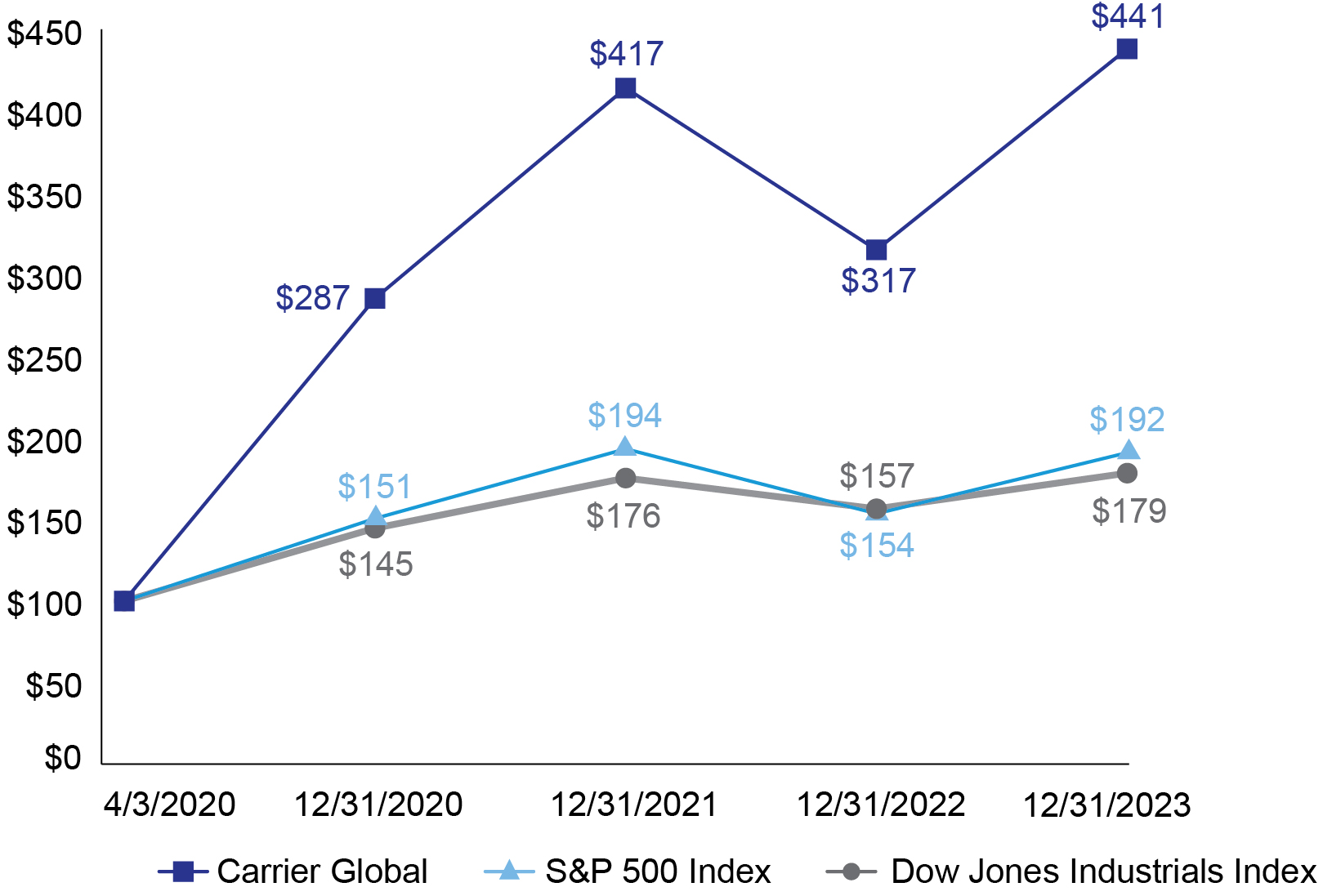
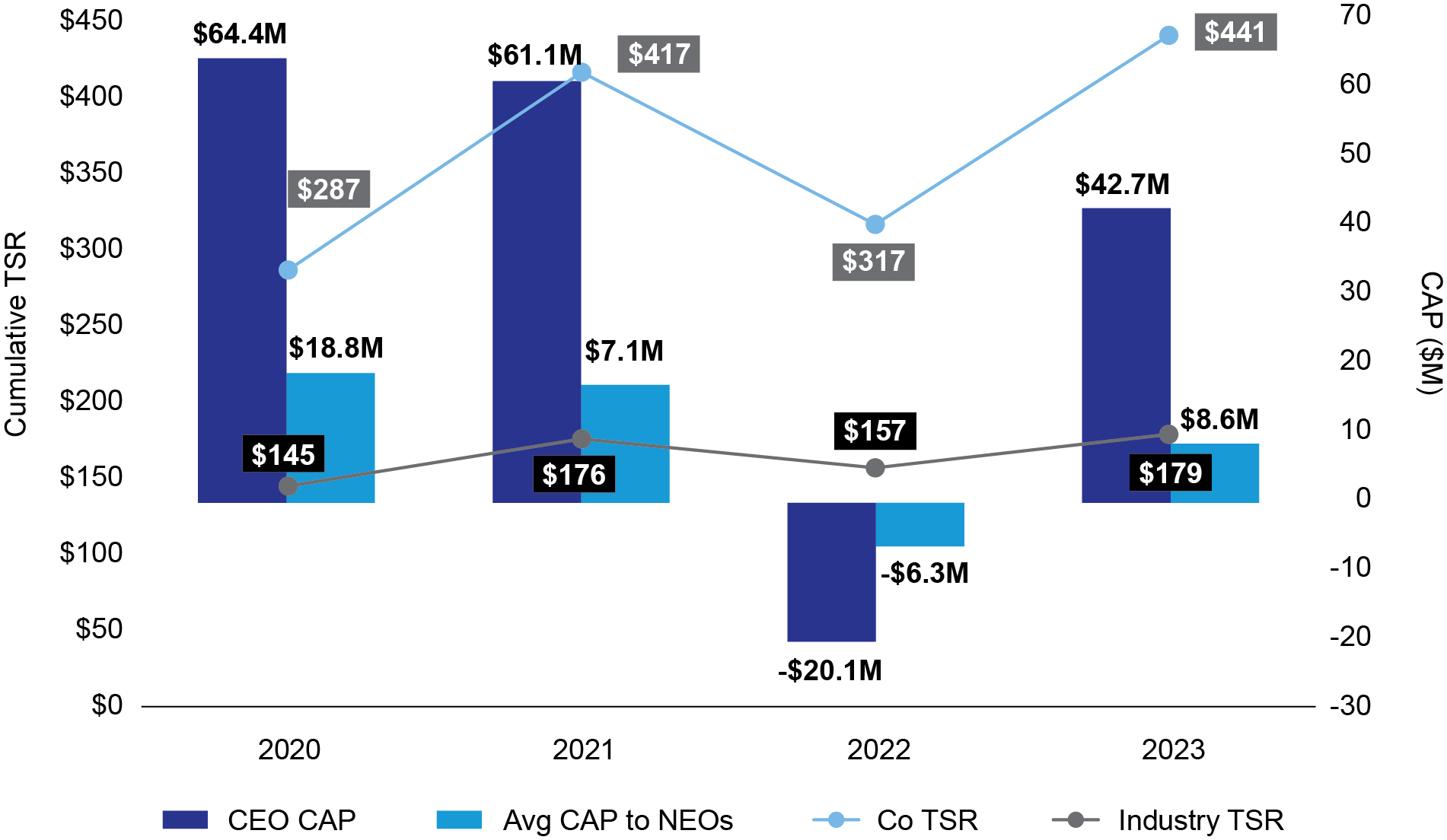
CAP vs. GAAP Net Income 
60 Carrier Global Corporation CAP vs. Adjusted EPS 
2024 Proxy Statement 61 Company’scompany’s compliance with its policies and procedures, internal controls, code of business conduct and ethics for directors, officers and employees (“Our Code of Ethics”)Ethics and applicable laws and regulations; policies and procedures with respect to risk assessment and management; and such other responsibilities as delegated by the Board from time to time. The Audit Committee’s specific responsibilities and duties are set forth in the Audit Committee Charter, which is available on the Company’scompany’s website (see page 20)10).(“PwC”("PwC"), an independent registered public accounting firm and the Company’scompany’s independent auditor, is responsible for expressing an opinion on the conformity of the Company’scompany’s audited financial statements with generally accepted accounting principles in the U.S.United States (“GAAP”).Company’scompany’s audited financial statements for the year ended December 31, 2020.2023, as well as the representations of management and the independent auditor's opinion thereon regarding the company's internal control over financial reporting as required by Section 404 of the Sarbanes-Oxley Act. The Audit Committee discussed with PwC and Carrier’s internal auditors the overall scope and plans for their respective audits. The Audit Committee met with PwC and the internal auditors, with and without management present, to discuss the results of their examinations, the evaluation of Carrier's internal controls, management's representations regarding internal control over financial reporting and the overall quality of Carrier’s financial reporting.Board’sBoard (“PCAOB”) Auditing Standard No. 1301, Communications with Audit Committees. It also has discussed with PwC its independence from Carrier and its management, including the written disclosures and letter from PwC required by the PCAOB’s Rule 3526, Communication withapplicable requirements of the PCAOB. The Audit Committees Concerning Independence, as approved by the SEC. The Committee has concluded that PwC’s provision of non-audit services as described in the table on page 63 is compatible with PwC’s independence.20202023, filed with the SEC. The Audit Committee nominatesrecommended to the Board, and the Board approved, the appointment of the firm of PwC for appointment by the shareowners as Carrier’s independent auditor for 2021.Michael M. McNamara62 Carrier Global Corporation Proposal 3: Appoint an Independent Auditor for 2021Appoint an2021appointratify the appointment of a firm of independent registered public accountants to serve as Carrier’s independent auditor until the next annual meeting. PwC,PricewaterhouseCoopers LLP, an independent registered public accounting firm, served as Carrier’s independent auditor in 2020,2023, and the Audit Committee has nominated,appointed, and the Board has approved, the firm for appointment by the shareowners to serve again as Carrier’s independent auditor for 20212024 until the next Annual Meeting in 2022.2025, subject to shareowner ratification.nomination,appointment, compensation, retention and oversight of the Company’scompany’s independent auditor. To fulfill this responsibility, the Audit Committee engages in a comprehensive annual evaluation of the independent auditor’s qualifications, performance and independence, and will periodically considerconsiders the advisability and potential impact of selecting a different independent registered public accounting firm to serve in that capacity.Company.company. For lead and concurring audit partners, the maximum number of consecutive years of service in that role is five years.five. The selection process for the lead audit partner pursuant to this rotation policy would include a meetingincludes meetings between the Chairchair of the Audit Committee and the candidate, as well as consideration of the candidate by the full Committee and with management.participate inattend the 20212024 Annual Meeting. They will be available to respond to appropriate shareowner questions and will have the opportunity to make a statement if they wantdesire to do so.do notDo Not Ratify the Appointment of PwC?2020?(IN THOUSANDS) AUDIT AUDIT-RELATED TAX ALL OTHER FEES TOTAL 2020 $16,724 $1,834 $2,011 $5 $20,574 Due to the Separation, no fees are reflected for Carrier for the year ended December 31, 2019.(IN THOUSANDS) AUDIT($) AUDIT-RELATED($) TAX($) ALL OTHER($) TOTAL($) 2022 14,950 456 2,750 384 18,540 2023 26,658 380 9,875 268 37,181 20202023 and 2022 include fees for the audit of Carrier’s consolidated annual financial statements, the review of interim financial statements in Carrier’s quarterly reports on Form 10-Q and the performance of audits in accordance with statutory requirements.requirements, fees associated with the issuance of comfort letters and consents, and fees for the audit of the effectiveness of Carrier's internal control over financial reporting. Fees in 2023 also include fees associated with carve-out audit and review procedures associated with Carrier's announced portfolio transformation and the issuance of comfort letters and consents associated with our acquisition of the VCS Business. Audit fees for statutory audits were $6.9 million.20202023 and 2022 include audit-related fees for employee benefit plan audits, advice regarding the application of generally accepted accounting principles for proposed transactions, special reports pursuant to agreed-upon procedures, contractually required audits and compliance assessments, and pre-implementation reviews of processes or systems.20212024 Proxy Statement 63 Proposal 3: Appoint an Independent Auditor for 20212020,2023, tax fees included approximately $466,000$0.1 million for U.S. and non-U.S. tax compliance, related planning and assistance with tax refund claims and expatriate tax services, and approximately $1.545$9.8 million for tax consulting and advisory services.2020,2023 and 2022, all other fees primarily consisted of due diligence services and accounting research software.Company’scompany’s independent auditor. All of the engagements and fees for 20202023 and 2022 were approved by the Audit Committee. The Audit Committee reviews with PwC whether the non-audit services to be provided are compatible with maintaining the firm’s independence. The Board also has adopted the policy that in any year fees paid to the independent auditor for non-audit services shall not exceed the fees paid for audit and audit-related services. Non-audit services consist of those described above, as included in the tax fees and all other fees categories.Companycompany and our shareowners.Company’scompany’s independent auditor for 20212024.64 Carrier Global Corporation Table
ContentsProposal 4: Advisory VoteCarrier request the preparation of a report, updated annually, disclosing:Frequencylegislation or regulation and (c) encourages the recipient of Futurethe communication to take action with respect to the legislation or regulation. "Indirect lobbying" is lobbying engaged in by a trade association or other organization of which Carrier is a member.VotesCouncil.6Approve Named Executive Officer Compensationexpand its lobbying disclosure.Advisory Vote on the Frequency of Future Advisory Votes to Approve Named Executive Officer CompensationWHAT AM I VOTING ON?As required by federal securities law, the Board requests your advisory vote on the intervals at which shareowners should vote to approve the compensation of Carrier’s NEOs – whether every year, every two years or every three years. We are required to seek an advisory vote every six years. Although your vote on this frequency proposal is advisory and, thus, not binding on the Board, the Board will consider the outcome of the shareowner vote in making its decision.The Board believes that an advisory vote on NEO compensation that occurs every year is the most appropriate option. An annual “Say-on-Pay” vote allows shareowners to provide frequent, direct input to the Company regarding its compensation philosophy, policies and practices. Holding the vote at one-year intervals also enhances shareowner communication by providing a clear, simple means for Carrier to ascertain general investor sentiment regarding its executive compensation program.The Board of Directors Recommends an Annual Shareowner Advisory Vote on the Compensation of Carrier’s Named Executive Officers.20212024 Proxy Statement65 66 Carrier Global Corporation TableContents2024 Proxy Statement 67
importantamAm I Being Provided with theseThese Proxy Materials?20212024 Annual Meeting of Shareowners and at any postponed or reconvened meeting.isIs the Annual Meeting?We will hold our Annual Meeting on April 19, 2021, at 8 a.m. Eastern time. In light of the COVID-19 pandemic, thevirtual format to protect the health of our shareowners, directors and employees.The virtual meeting website is www.virtualshareholdermeeting.com/CARR2021. I Attend the Meeting?You will be ableMeeting and Vote?meeting virtually, but not in person. Because2024 Annual Meeting of the ongoing COVID-19 pandemic, we have adopted the virtual format to provide a safe experience for all attendees. If youShareowners and vote if they owned shares of Carrier common stock at the close of business on February 22, 2021,27, 2024, which is referred to as the “record date,” you can participate from any geographic location withdate."connectivity throughand telephone until 11:59 p.m. Eastern time on April 17, 2024, and via mail – please see page 70 for detailed instructions – and may submit questions in advance of the Annual Meeting via internet at www.proxyvote.com until 11:59 p.m. Eastern time on April 17, 2024.CARR2021.CARR2024. Once on that website, youeligible shareowners will need to log in using the control number on yourtheir proxy card, voting instruction form or notice regarding the availability of proxy materials. YouEligible shareowners may log into the meeting’s websitein at www.virtualshareholdermeeting.com/CARR2024 beginning at 7:458:15 a.m. Eastern time on April 19.will allow ourformat allows shareowners of record to participate from any geographic locationcommunicate with internet connectivity, and, in structuring the format of the meeting, our goal has been to enhance rather than constrain shareowner participation. To this end, shareowners will have an opportunity to vote and submit questions online before andCarrier during the Annual Meeting through the www.virtualshareholdermeeting.com/CARR2021 website, whichso they can be accessed by following the instructions above (see Can I Attend the Meeting?). During the meeting, we will answerask questions relevant to meeting matters that comply with the meeting’s procedures, which also will be available on the website. We believe that shareowner participation opportunities will be reasonably comparable to those that would be available at an in-person meeting.of Carrier’s management and Board, as appropriate. If you have an individual concern that is not of general concernwish to all shareowners, or ifsubmit a question posed was not otherwise answered, please contact Carrier Investor Relations at investorrelations@carrier.com or 561-365-2020.Who Can Vote During the Meeting?All shareowners are entitled to vote before or during the Annual Meeting, you may do so by logging into the virtual meeting platform at www.virtualshareholdermeeting.com/CARR2024, clicking the Q&A button on your screen and typing your question into the provided text field.68 Carrier Global Corporation owned shares of Carrier common stock onintend to attend and/or participate in the record date. Please see below (How Do I Vote?) for more information about voting before or during the meeting.thatThat Directors Attend Annual Meetings?Companycompany does not have a written policy requiring that directors attend the Annual Meeting, but directors are encouraged to do so unless there is an unavoidable scheduling conflict. This year, while the Companycompany is not hosting an in-person meeting, directors are similarly encouraged to participate unless they have a such a conflict.Company’scompany’s Bylaws, a quorum is required to transact business at the Annual Meeting. The holdersowners of a majority of the outstanding shares of Carrier common stock as of the record date, present either in person or by proxy and entitled to vote, will constitute a quorum. As of the record date, 869,283,513900,102,917 shares of Carrier common stock were issued and outstanding.66Carrier Global Corporation2024 Proxy Statement 69 Frequently Asked Questions About the Annual Meeting


www.proxyvote.com.

18, 2021.


CARR2021CARR2024 and log in using your voter control number. See page 6668 for more information about the virtual meeting.••Write to the Carrier Corporate Secretary (see page 70 for contact information) providing your name and account information, but allow sufficient time for delivery.•(whichwhich will override your earlier proxy card).card.•2021 Proxy Statement6770 Carrier Global Corporation Frequently Asked Questions About the Annual MeetingbeBe Voted?(Appointment(Ratify Appointment of the Independent Auditor)Auditor for 2024) and is required to withhold a vote on each of the other Proposals, resulting in a so-called “broker non-vote.non-vote.” The impact of abstentions and broker non-votes on the overall voting results is shown in the table below.MATTER Election of Directors Votes FOR a nominee must exceed 50% of the votes cast for that nominee.cast. Not counted as votes cast. No impact on outcome. Not counted as votes cast. No impact on outcome. Advisory Vote to Approve Named Executive Officer Compensation Approval by a majority ofVotes FOR the proposal must exceed votes making up the quorum.AGAINST it. Counted toward quorum.as shares present, or represented by proxy and entitled to vote on the matter. Impact is same as a vote AGAINST.Not counted as votes cast.shares present, or represented by proxy and entitled to vote on the matter. No impact on outcome.Appoint PricewaterhouseCoopers LLP to Serve asRatify Appointment of Independent Auditor for 20212024Approval by a majority ofVotes FOR the proposal must exceed votes making up the quorum.AGAINST it. Counted toward quorum.as shares present, or represented by proxy and entitled to vote on the matter. Impact is the same as a vote AGAINST.Not applicable for reason explained above.applicable. There will not be broker non-votes because brokers are permitted to vote your shares on this item in their discretion.Advisory VoteShareowner proposal regarding transparency in lobbying Votes FOR the proposal must exceed votes AGAINST it. Counted as shares present, or represented by proxy and entitled to vote on the Frequency of Future Shareowner Votes to Approve Named Executive Officer CompensationThe option for which the greatest number of votesmatter. Impact is cast.same as a vote AGAINST. Not counted as votes cast. No impactshares present, or represented by proxy and entitled to vote on outcome.Not counted as votes cast.the matter. No impact on outcome.thanThan “For” His or HerElection? also recommend to the Board whether to fill the vacancy or to reduce the size of the Board. Under Carrier’s Bylaws, a vacancy arising in these circumstances may be filled at the discretion of the Board by a majority vote of the directors or at a special meeting of shareowners called by the Board.2024 Proxy Statement 71 68Carrier Global CorporationFrequently Asked Questions About the Annual Meetinghttp://enroll.icsdelivery.com/carrier. – other than those matters discussed in this Proxy Statement. However, if any other matter requiring a vote of the shareowners properly comes before the Annual Meeting, then the individuals acting under the proxies solicited by the Board will have the discretion to vote on those matters for you.72 Carrier Global Corporation 20222025 Annual Meeting?20222025 Annual Meeting under SEC Rule 14a-8, you must send the proposal to our Corporate Secretary. The Corporate Secretary must receive the proposal in2021 Proxy Statement69Frequently Asked Questions About the Annual Meeting8, 2021.20222025 Annual Meeting20222025 Annual Meeting (other than a shareowner proposal included in the Proxy Statement in accordance with SEC Rule 14a-8), Carrier’s Bylaws require that the shareowner send advance written notice to the Carrier Corporate Secretary at the company's principal executive offices (at the address below) for receipt no earlier than December 20, 2021,19, 2024, and no later than January 19, 2022.18, 2025. This notice must include the information specified by Section 1.9 of the Bylaws, a copy of which is available on our website listed below.atSubmitted for the 20222025 Annual Meeting20222025 Annual Meeting (other than pursuant to the “proxy access” provisions of Section 1.16 of the Bylaws) must send advance written notice to the Carrier Corporate Secretary at the company's principal executive offices for receipt no earlier than December 20, 2021,19, 2024, and no later than January 19, 2022.18, 2025. This notice must include the information, documents and agreements specified by Section 1.9 of the Bylaws, a copy of which is available on our website listed below.20222025 Annual Meeting pursuant to the “proxy access” provisions of Section 1.16 of our Bylaws must send advance written notice to the Carrier Corporate Secretary for receipt no earlier than October 9, 2021,6, 2024, and no later than November 8, 2021.5, 2024. This notice must include the information, documents and agreements specified by Section 1.16 of the Bylaws, a copy of which is available on our website listed below.





WRITE A LETTER SEND AN EMAIL CALL Write a letterSend an emailCallcorpsec@carrier.com 1-561-365-2335 Company’scompany’s website at www.corporate.carrier.com.
(see page 10).70Carrier Global Corporation2024 Proxy Statement 73 From time to time, oral or written forward-looking statements may also be included in other information released to the public. These forward-looking statements are intended to provide management’s current expectations or plans for our future operating and financial performance, based on assumptions currently believed to be valid. Forward-looking statements can be identified by the use of words such as “believe,” “expect,” “expectations,” “plans,” “strategy,” “prospects,” “estimate,” “project,” “target,” “anticipate,” “will,” “should,” “see,” “guidance,” “outlook,” “confident,” “scenario” and other words of similar meaning in connection with a discussion of future operating or financial performance or the Separation.performance. Forward-looking statements may include, among other things, statements relating to future sales, earnings, cash flows,flow, results of operations, uses of cash, share repurchases, tax rates and other measures of financial performance or potential future plans, strategies or transactions of Carrier, the estimated costs associated with the Separation, Carrier’s plans with respect to our indebtedness, statements with respect to current and future implications of corporate responsibility and sustainability topics, research, development and anticipated technology developments, anticipated impacts of our products including with respect to our customers’ goals relating to sustainability targets and otherwise, anticipated impacts of our portfolio transformation, anticipated impacts of our compensation programs, secular and macroeconomic trends, and other statements that are not historical facts. All forward-looking statements involve risks, uncertainties and other factors that may cause actual results to differ materially from those expressed or implied in the forward-looking statements. For those statements, we claim the protection of the safe harbor for forward-looking statements contained in the U.S. Private Securities Litigation Reform Act of 1995. Such risks, uncertainties and other factors include, without limitation:•the effect of economic conditions in the industries and markets in which Carrier and our businesses operate in the U.S. and globally and any changes therein, including financial market conditions, fluctuations in commodity prices, interest rates and foreign currency exchange rates, levels of end market demand in construction, the impact of weather conditions, pandemic health issues (including COVID-19 pandemic and its effects, among other things, on production and on global supply, demand, and distribution as the outbreak continues and results in a prolonged period of travel, commercial and other restrictions and limitations), natural disasters and the financial condition of our customers and suppliers;•challenges in the development, production, delivery, support, performance and realization of the anticipated benefits of advanced technologies and new products and services;•future levels of indebtedness, capital spending and research and development spending;•future availability of credit and factors that may affect such availability, including credit market conditions and Carrier’s capital structure and credit ratings;•the timing and scope of future repurchases of Carrier’s common stock, including market conditions and the level of other investing activities and uses of cash;•delays and disruption in the delivery of materials and services from suppliers;•cost reduction efforts and restructuring costs and savings and other consequences thereof;•new business and investment opportunities;•risks resulting from being a smaller less diversified company than prior to the Separation;•the outcome of legal proceedings, investigations and other contingencies;•the impact of pension plan assumptions on future cash contributions and earnings;•the impact of the negotiation of collective bargaining agreements and labor disputes;•the effect of changes in political conditions in the U.S. (including in connection with the new administration in Washington, D.C.) and other countries in which Carrier and our businesses operate, including the effect of changes in U.S. trade policies or the United Kingdom’s withdrawal from the European Union, on general market conditions, global trade policies and currency exchange rates in the near term and beyond;•the effect of changes (including potentially as a result of the new administration in Washington, D.C.) in tax, environmental, regulatory (including among other things import/export) and other laws and regulations in the U.S. and other countries in which we and our businesses operate;•the ability of Carrier to retain and hire key personnel;•the scope, nature, impact or timing of acquisition and divestiture activity, including among other things integration of acquired businesses into existing businesses and realization of synergies and opportunities for growth and innovation and incurrence of related costs;•the expected benefits of the Separation;•a determination by the U.S. Internal Revenue Service and other tax authorities that the Distribution or certain related transactions should be treated as taxable transactions;•risks associated with indebtedness, including that incurred as a result of financing transactions undertaken in connection with the Separation, as well as our ability to reduce indebtedness and the timing thereof;•the risk that dis-synergy costs, costs of restructuring transactions and other costs incurred in connection with the Separation will exceed Carrier’s estimates; and•the impact of the Separation on Carrier’s business and Carrier’s resources, systems, procedures and controls, diversion of management’s attention and the impact on relationships with customers, suppliers, employees and other business counterparties.2021 Proxy Statement71Other Important Information20202023 Annual Report on Form 10-K includes important information as to risks, uncertainties and other factors that may cause actual results to differ materially from those expressed or implied in the forward-looking statements. See the Notes to the Consolidated Financial Statements in thisour 2023 Annual Report on Form 10-K under the heading “Note 2523 – Commitments and Contingent Liabilities,” the sections entitled “Management’s Discussion and Analysis of Financial Condition and Results of Operations” under the headings “Business Overview,” “Results of Operations,” “Liquidity and Financial Condition,” and “Critical Accounting Estimates,” and the section entitled “Risk Factors.” ThisOur 2023 Annual Report on Form 10-K also includes important information as to these factors in the “Business” section under the headings “General,” “Other Matters Relating to Our Business as a Whole,” and in the “Legal Proceedings” section. TheAny forward-looking statements speakstatement speaks only as of the date of this report or, in the case of any document incorporated by reference, the date of that document. We undertakeon which it is made, and Carrier assumes no obligation to publicly update or revise any forward-looking statements,such statement, whether as a result of new information, future events or otherwise, except as required by applicable law. Additional information as to factors that may cause actual results to differ materially from those expressed or implied in the forward-looking statements is disclosed from time to time in our other filings with the SEC.Committee and Ourcommittee, our Code of Ethics and excerpts from our Corporate Policy Manual are available on Carrier’s website provided on page 20.10. Printed copies will be provided, without charge, to any shareowner upon a request addressed to the Corporate Secretary through the contact information provided on page 70.20)10); (ii) letter addressed to the Carrier Corporate Secretary (see page 7073 for contact information); or (iii) using Carrier’s Anonymous Reporting program (see(contact information is available on Carrier's website provided on page 20 for contact information)10). Communications relating to Carrier’s accounting, internal controls, auditing matters or business practices will be reviewed by the chief compliance officerChief Compliance Officer and reported to the Audit Committee pursuant to Carrier’s Corporate Governance Principles. All other communications will be reviewed by the Corporate Secretary and reported to the Board, as appropriate, pursuant to theour Corporate Governance Principles.withWith Related Persons20)10), for the review of transactions with related persons. The Related Person Transactions Policy requires review, approval or ratification of transactions exceeding $120,000 in which Carrier is a participant and in which a Carrier director, executive officer, or a beneficial owner of more than 5% or more of Carrier’s outstanding shares, – or an immediate family member of any of the foregoing persons – has a direct or indirect material interest.proposedsuch transaction must be reported for review by the Corporate Secretary who will, in consultation with the Company’s chief compliance officer,company’s Chief Compliance Officer, assess whether the transaction is a transaction with a related person, as that term is defined under Carrier’s policy. Following this review, the Board’s Governance Committee will then determine whether the transaction can be approved or not, based on whether the transaction is determined to be in, or not inconsistent with, the best interests of Carrier and its shareowners. In making this determination, the Governance Committee takes into consideration, among other factors it deems appropriate, whether the transaction is on terms no less favorable than terms generally available in transactions with unaffiliated third parties under the same or similar circumstances and the extent of the related person’s interest in the transaction.74 Carrier Global Corporation Company.company. This ensures that all material relationships and related person transactions are identified, reviewed and disclosed in accordance with applicable policies, procedures and regulations.chief compliance officer.From timeChief Compliance Officer.time, Carrier purchases servicesViessmann Group in connection with the ordinary course of business from financial institutions that beneficially own 5% or moreagreements described below have amounted to approximately $11.3 billion, excluding 58,608,959 shares of our common stock.stock paid as partial consideration for the acquisition. In 2020,connection with the acquisition, Carrier paidhas entered into the following agreements with Viessmann Group:such institutionswhich we acquired the VCS Business, which was entered into on April 25, 2023, and which contained certain closing conditions and termination rights, as well as customary representations, warranties and covenants and which provides that, for services relatedspecified time periods following the closing of the acquisition and subject to certain employee benefit plans: (1) BlackRock, Inc. (approximately $491,000); (2) State Street Corporation (approximately $268,000); and (3) The Vanguard Group (approximately $2,800).72Carrier Global CorporationOther Important InformationDelinquent Section 16(a) ReportsSection 16(a)exceptions, certain aspects of the Securities Exchange ActVCS Business will be operated as they were at the time of 1934, as amended, requiresthe execution of the Share Purchase Agreement;directorsBoard for a period of ten years following the closing of the acquisition, has agreed to certain voting restrictions, and executive officers, among others,has customary standstill, lockup and transfer restrictions, and customary resale, demand and piggyback registration rights;file reportsuse the “Viessmann” trademarks in connection with the SEC indicating their holdingsViessmann Group in exchange for an annual royalty of €12 million for the first five years of the term of the License Agreement and transactions in,royalties thereafter determined based on net sales of licensed products sold by us for the remainder of the term;equity securities. Based upon a review of these reports, and upon written representations from our directors and executive officers, we believe that in 2020 all reports, except one, were timely filed with the SEC. An inadvertently late Form 4 was filed on behalf of Kevin J. O’Connor that relatedViessmann Group will provide to the sale in 2020 of less than ten shares ofother on an interim, transitional basis, various services for agreed-upon charges; andcommon stock that was held in the UTC savings plan. Carrier is not aware of any beneficial owners of more than 10% of UTC Common Stockand Viessmann Group intend to enter into, including framework agreements, lease agreements and a paying agent agreement providing for purposes of Section 16(a).14-14 – Stock-Based Compensation to the Consolidated Financial Statements in Carrier’s 20202023 Annual Report on Form 10-K filed with the SEC on February 9, 2021;6, 2024; these are the only portions of such filings that are incorporated by reference in this Proxy Statement.Company”company” or “Carrier,” unless the context otherwise requires, mean Carrier Global Corporation and its subsidiaries.20212024 Proxy Statement 7375 Reconciliation of Reported GAAP to Adjusted & Operating Profit Margin(UNAUDITED) (DOLLARS IN MILLIONS - INCOME (EXPENSE)) FOR THE THREE
MONTHS ENDED
MARCH 31, 2020 FOR THE PERIOD
APRIL 1, 2020 TO
DECEMBER 31, 2020 FOR THE
YEAR ENDED
DECEMBER 31, 2020 HVAC Net sales $1,959 $7,519 $9,478 Operating profit $167 $2,295 $2,462 Restructuring (2 ) (5 ) (7 ) Impairment charge on equity method investment (71 ) – (71 ) Gain on sale of investment – 1,123 1,123 Charge resulting from litigation matter – (11 ) (11 ) Separation costs (2 ) – (2 ) Adjusted operating profit $242 $1,188 $1,430 Adjusted operating margin 12.4 % 15.8 % 15.1 % Refrigeration Net sales $808 $2,525 $3,333 Operating profit $99 $258 $357 Restructuring – (12 ) (12 ) Net gain on expropriated plant – – – Separation costs – (6 ) (6 ) Adjusted operating profit $99 $276 $375 Adjusted operating margin 12.3 % 10.9 % 11.3 % Fire & Security Net sales $1,206 $3,779 $4,985 Operating profit $120 $464 $584 Restructuring (3 ) (25 ) (28 ) Separation costs (3 ) (13 ) (16 ) Pension plan amendment – – – Adjusted operating profit $126 $502 $628 Adjusted operating margin 10.4 % 13.3 % 12.6 % General Corporate Expenses and Eliminations and Other Net sales $(85 ) $(255 ) $(340 ) Operating profit $(71 ) $(249 ) $(320 ) Restructuring (2 ) (2 ) Consultant contract termination – – – Separation costs (40 ) (77 ) (117 ) Adjusted operating profit $(31 ) $(170 ) $(201 ) (UNAUDITED) FOR THE YEAR ENDED DECEMBER 31, 2023 FOR THE YEAR ENDED DECEMBER 31, 2022 (IN MILLIONS, EXCEPT PER SHARE AMOUNTS) REPORTED ADJUSTMENTS ADJUSTED REPORTED ADJUSTMENTS ADJUSTED Net sales $22,098 $— $22,098 $20,421 $— $20,421 Operating profit 2,296 911 a 3,207 4,515 (1,621) a 2,894 Operating margin 10.4 % 14.5 % 22.1 % 14.2 % Income from operations before income taxes 2,084 960 a,b 3,044 4,292 (1,649) a,b 2,643 Income tax expense (644) 20 c (624) (708) 135 c (573) Income tax rate 30.9 % 20.5 % 16.5 % 21.7 % Net income attributable to common shareowners $1,349 $980 $2,329 $3,534 ($1,514) $2,020 Summary of Adjustments: Restructuring costs $97 a $31 a Amortization of acquired intangibles 149 a 50 a 41 a 51 a Acquisition-related costs 220 a 31 a Viessmann-related hedges 96 a — Chubb gain — (1,105) a 8 a (705) a KFI deconsolidation 297 a — Russia/Ukraine asset impairment — 4 a Charge resulting from legal matter — 22 a — (28) b 52 a, b — Total adjustments $960 ($1,649) Tax effect on adjustments above ($114) $172 Tax specific adjustments 134 (37) Total tax adjustments $20 c $135 c Shares outstanding - Diluted 853.0 853.0 861.2 861.2 Earnings per share – Diluted $1.58 $2.73 $4.10 $2.34 7476 Carrier Global Corporation Appendix A: Reconciliation of GAAP Measures to Corresponding Non-GAAP Measures(UNAUDITED) (DOLLARS IN MILLIONS - INCOME (EXPENSE)) FOR THE THREE
MONTHS ENDED
MARCH 31, 2020 FOR THE PERIOD
APRIL 1, 2020 TO
DECEMBER 31, 2020 FOR THE
YEAR ENDED
DECEMBER 31, 2020 Carrier Net sales $3,888 $13,568 $17,456 Operating profit $315 $2,768 $3,083 Total restructuring costs (5 ) (44 ) (49 ) Total non-recurring and non-operational items (116 ) 1,016 900 Adjusted operating profit $436 $1,796 $2,232 Constant currency Adjustment 1 5 6 ADJUSTED OPERATING PROFIT AT CONSTANT CURRENCY 435 1,791 2,226 Adjusted operating margin 11.2 % 13.0 % 12.8 % Reconciliation of GAAP to Adjusted Net Income, Earnings Per Share and Effective Tax Rate(UNAUDITED)FOR THE YEAR ENDEDDECEMBER 31, 2020(DOLLARS IN MILLIONS - INCOME (EXPENSE))Net income attributable to common shareowners$1,982Total restructuring costs(49)Total non-recurring and non-operational items included in operating profit900Non-recurring and non-operational items included in Interest expense, net:Interest income associated with participation in amnesty settlement–Interest income associated with IRS settlement–Debt issuance costs relating to Carrier’s separation from UTC(5)Non-recurring and non-operational items included in Interest expense, net(5)Tax effect of restructuring and non-recurring and non-operational items(217)Significant non-recurring and non-operational items included in Income tax expense:Favorable income tax adjustments related to tax amnesty–Adjustments related to tax settlements–Adjustment related to a valuation allowance recorded against a United Kingdom tax loss and credit carryforward as a result of separation related activities(51)Adjustment resulting from Carrier’s decision to no longer permanently reinvest certain pre-2018 unremitted non-U.S. earnings(46)Deferred tax adjustment resulting from the UTC Separation–Deferred tax adjustment resulting from United Kingdom legislative change(12)Significant non-recurring and non-operational items included in Income tax expense(109)Total significant non-recurring and non-operational items520Adjusted net income attributable to common shareowners$1,462Diluted earnings per share$2.25Impact on diluted earnings per share0.59Adjusted diluted earnings per share$1.66Effective tax rate29.7%Impact on effective tax rate(3.7)%Adjusted effective tax rate26.0%2021 Proxy Statement75Appendix A: Reconciliation of GAAP Measures to Corresponding Non-GAAP Measures FOR THE THREE
MONTHS ENDED
MARCH 31, 2020 FOR THE PERIOD
APRIL 1, 2020 TO
DECEMBER 31, 2020 FOR THE YEAR ENDED
DECEMBER 31, 2020 (DOLLARS IN MILLIONS) Net income attributable to common shareowners $96 $1,886 $1,982 Net cash flows provided by operating activities 47 1,645 1,692 Less: Capital expenditures 48 264 312 Free cash flow ($1 ) $1,381 $1,380 (UNAUDITED) FOR THE
YEAR ENDED
DECEMBER 31, 2023FOR THE
YEAR ENDED
DECEMBER 31, 2022(IN MILLIONS) Net cash flows provided by operating activities $2,607 $1,743 Less: Capital expenditures 469 353 Free cash flow $2,138 $1,390 (UNAUDITED) FOR THE YEAR ENDED DECEMBER 31, 2023 (IN MILLIONS) NET SALES OPERATING PROFIT FREE CASH FLOW Adjusted financial results $22,098 $3,207 $2,138 Performance adjustments: Constant currency (23) (12) (8) Gain on Divestiture — (25) — Performance adjusted results $22,075 $3,170 $2,130 Debt to EBITDA (UNAUDITED)
FOR THE YEAR ENDED
DECEMBER 31, 2020 FOR THE THREE
MONTHS ENDED
MARCH 31, 2020(1) (DOLLARS IN MILLIONS) Long-term debt $10,036 $11,029 Current portion of long-term debt 191 218 Less: Cash and cash equivalents 3,115 768 Net debt $7,112 $10,479 Net income attributable to common shareowners $1,982 Plus: Interest expense 298 Income tax expense 849 Depreciation and amortization 336 EBITDA 3,465 Less: Total non-recurring and non-operational adjustments, excluding interest and tax adjustments 851 Non-service pension benefit 60 Non-controlling interest in subsidiaries’ earnings from operations 24 Adjusted EBITDA $2,578 Net debt to adjusted EBITDA 2.8 (1)On April 3, 2020, Carrier received cash contributions totaling $590 million from UTC related to the Separation, resulting in net debt of approximately $9.9 billion as of April 3, 2020.
Sales76Carrier Global Corporation(UNAUDITED) FOR THE YEAR ENDED DECEMBER 31, 2023 vs. 2022 HVAC REFRIGERATION FIRE & SECURITY GENERAL
CORPORATE
EXPENSES AND
ELIMINATIONS
AND OTHERCONSOLIDATED Organic 5 % (2 %) 6 % — % 3 % FX Translation (1 %) 1 % (1 %) — % — % Acquisitions / Divestitures, net 9 % (1 %) (3 %) — % 5 % Other — % — % — % — % — % Total 13 % (2 %) 2 % — % 8 % 2024 Proxy Statement 77 Appendix A: Reconciliation of GAAP Measures to Corresponding Non-GAAP Measuresthosesuch other companies. We encourage investors to review our financial statements and publicly filed reports in their entirety and not to rely on any single financial measure. earnings before interest, taxes and depreciation and amortization (“EBITDA”), adjusted EBITDA, adjusted net income, adjusted earnings per share (“EPS”), the and adjusted effective tax rate and net debt are non-GAAP financial measures.twelve12 months and other significant items of a non-recurring and/or nonoperational nature (hereinafter referred to as “other significant items”).EBITDA represents net income attributable to common shareowners (a GAAP measure), adjusted for interest expense, income tax expense, and depreciation and amortization. Adjusted EBITDA represents EBITDA, as calculated above, excluding non-service pension benefit, non-controlling interest in subsidiaries’ earnings from operations, restructuring costs and other significant items. Adjusted net income represents net income attributable to common shareowners (a GAAP measure), excluding restructuring costs, amortization of acquired intangibles and other significant items. Adjusted EPS represents diluted earnings per share (a GAAP measure), excluding restructuring costs, amortization of acquired intangibles and other significant items. The adjusted effective tax rate represents the effective tax rate (a GAAP measure), excluding restructuring costs, amortization of acquired intangibles and other significant items. For the business segments, when applicable, adjustments of operating profit and operating margins represent operating profit, excluding restructuring, amortization of acquired intangibles and other significant items. We use the non-GAAP measure “at constant currency” or “CFX” to show changes in our financial results without giving effect to period-to-period currency fluctuations. Under GAAP, income statement results are translated in U.S. dollars at the average exchange rate for the period presented.Management believes that the non-GAAP measures described above are useful in providing period-to-period comparisons of the results of the Company’s ongoing operational performance.Net debt (a non-GAAP measure) represents long-term debt (a GAAP measure) less cash and cash equivalents. Cash and equivalents are subtracted from the GAAP measure because they could be used to reduce the Company’s debt obligations. A limitation associated with using net debt is that it may imply that there is less Company debt than the most comparable GAAP measure indicates. Nevertheless, management believes that investors may find it a useful measure to monitor leverage and evaluate the balance sheet.2021 Proxy Statement7778 Carrier Global Corporation 


VOTE BY INTERNET CARRIER GLOBAL CORPORATION Use the Internet to transmit your voting instructions and for electronic delivery of information up until 11:59 p.m. Eastern Time on Wednesday, April 17, 2024. Have your proxy card in hand when you access the website and follow the instructions to obtain your records and to create an electronic voting instruction form. You may attend the meeting via the Internet and vote during the meeting. Have the information that is printed in the box marked by the arrow available and follow the instructions. VOTE BY PHONE - 1-800-690-6903 Use any touch-tone telephone to transmit your voting instructions up until 11:59 p.m. Eastern Time on Wednesday, April 17, 2024. Have your proxy card in hand when you call and then follow the instructions. VOTE BY MAIL Mark, sign and date your proxy card and return it in the postage-paid envelope we have provided or return it in your own envelope by mailing it to Vote Processing, c/o Broadridge, 51 Mercedes Way, Edgewood, NY 11717. ELECTRONIC DELIVERY OF FUTURE PROXY MATERIALS If you would like to reduce the cost incurred by our Company in mailing proxy materials, you can consent to receiving all future proxy statements, proxy cards and annual reports electronically via e-mail or the Internet. To sign up for electronic delivery, please follow the instructions above to vote using the Internet and, when prompted, indicate that you agree to receive or access proxy materials electronically in future years. 
13995 Pasteur BoulevardPalm Beach Gardens, FL 33418www.corporate.carrier.com 
TO VOTE, MARK BLOCKS BELOW IN BLUE OR BLACK INK AS FOLLOWS: D95493-P82835 KEEP THIS PORTION FOR YOUR RECORDS
CARRIER GLOBAL CORPORATION13995 PASTEUR BOULEVARDPALM BEACH GARDENS, FL 33418VOTE BY INTERNETBefore The Meeting - Go to www.proxyvote.comUse the Internet to transmit your voting instructions and for electronic delivery of information up until 11:59 p.m. Eastern Time on Sunday, April 18, 2021. Have your proxy card in hand when you access the website and follow the instructions to obtain your records and to create an electronic voting instruction form.During The Meeting - Go to www.virtualshareholdermeeting.com/CARR2021You may attend the meeting via the Internet and vote during the meeting. Have the information that is printed in the box marked by the arrow available and follow the instructions.VOTE BY PHONE - 1-800-690-6903Use any touch-tone telephone to transmit your voting instructions up until 11:59 p.m. Eastern Time on Sunday, April 18, 2021. Have your proxy card in hand when you call and then follow the instructions.VOTE BY MAILMark, sign and date your proxy card and return it in the postage-paid envelope we have provided or return it in your own envelope by mailing it to Vote Processing, c/o Broadridge, 51 Mercedes Way, Edgewood, NY 11717.ELECTRONIC DELIVERY OF FUTURE PROXY MATERIALSIf you would like to reduce the costs incurred by our Company in mailing proxy materials, you can consent to receiving all future proxy statements, proxy cards and annual reports electronically via e-mail or the Internet. To sign up for electronic delivery, please follow the instructions above to vote using the Internet and, when prompted, indicate that you agree to receive or access proxy materials electronically in future years.TO VOTE, MARK BLOCKS BELOW IN BLUE OR BLACK INK AS FOLLOWS:D29625-P47755 KEEP THIS PORTION FOR YOUR RECORDSCARRIER GLOBAL CORPORATION DETACH AND RETURN THIS PORTION ONLYTHIS PROXY CARD IS VALID ONLY WHEN SIGNED AND DATED.CARRIER GLOBAL CORPORATION1. Election of DirectorsForAgainstAbstain1a. John V. Faraci☐☐☐1b.Jean-Pierre Garnier☐☐☐1c.David Gitlin☐☐☐1d.John J. Greisch☐☐☐1e.Charles M. Holley, Jr.☐☐☐1f.Michael M. McNamara☐☐☐1g.Michael A. Todman☐☐☐1h.Virginia M. Wilson☐☐☐Address changes can be directed to Computershare bycalling 1-866-507-8028The Board of Directors recommends a vote FOR the following proposals: proposals 2 and 3:ForAgainstAbstainFor Against Abstain For Against Abstain 1a. Jean-Pierre Garnier ☐ ☐ ☐ 2. Advisory Vote to Approve Named Executive Officer Compensation.Compensation☐ ☐ ☐ ☐3.1b. David Gitlin Appoint☐ ☐ ☐ 3. Ratify Appointment of PricewaterhouseCoopers LLP to Serve as Independent Auditor for 2021.2024☐ ☐ ☐ ☐1c. John J. Greisch ☐ ☐ ☐ 1d. Charles M. Holley, Jr. ☐ ☐ ☐ FOR 1 YEAR on the following proposal:AGAINST proposal 4:1 Year2 Years3 YearsAbstain4.1e. Michael M. McNamara Advisory Vote on the Frequency of Future Shareowner Votes to Approve Named Executive Officer Compensation.☐ ☐ ☐ For ☐Against Abstain ☐1f. Susan N. Story ☐ ☐ ☐ 4. Shareowner Proposal regarding transparency in lobbying ☐ ☐ ☐ 1g. Michael A. Todman ☐ ☐ ☐ 1h. Maximilian (Max) Viessmann ☐ ☐ ☐ 1i. Virginia M. Wilson ☐ ☐ ☐ 1j. Beth A. Wozniak ☐ ☐ ☐ Address changes can be directed to Computershare by calling 1-866-507-8028 Please sign exactly as your name(s) appear(s) hereon. When signing as attorney, executor, administrator or other fiduciary, please give full title as such. Joint owners should each sign personally. All holders must sign. If a corporation or partnership, please sign in full corporate or partnership name by authorized officer. Signature [PLEASE SIGN WITHIN BOX] Date Signature (Joint Owners) Date Monday,19, 2021,18, 2024, 8:0030 a.m. Eastern TimeCARR20211.Election of the Eight Director Nominees Named in the Proxy Statement2.Advisory Vote to Approve Named Executive Officer Compensation3.Appoint PricewaterhouseCoopers LLP to Serve as Independent Auditor for 20214.Advisory Vote on the Frequency of Future Shareowner Votes to Approve Named Executive Officer Compensation5.Other business, if properly presented20212024 Annual Meeting of Shareowners and Proxy Statement and the 20202023 Annual Report are available at: www.proxyvote.com.D29626-P47755
PROXYThis Proxy is Solicited on Behalf of the Board of Directors of Carrier Global Corporation.The undersigned hereby appoints Jean-Pierre Garnier, John J. Greisch and Charles M. Holley, Jr., and each of them, each with power of substitution and revocation, as proxies for the undersigned to act and vote at the Annual Meeting of Shareowners of Carrier Global Corporation to be held on April 19, 2021, and at any postponed or reconvened meeting, as directed on this Proxy Card, upon the matters set forth on the reverse side hereof, all as described in the Proxy Statement and, in their discretion, upon any other business that may properly come before said meeting, including an adjournment. If this Proxy Card is properly signed and returned, but does not provide voting instructions, then the votes represented by this Proxy Card will be voted FOR the election of the director nominees, FOR Proposals 2 and 3, and FOR 1 YEAR for Proposal 4.The undersigned hereby revokes all proxies previously given by the undersigned to vote at the Annual Meeting of Shareowners or any adjournment or postponement thereof.You are encouraged to specify your choices by marking the appropriate boxes (SEE REVERSE SIDE), but you need not mark any boxes if you wish to vote in accordance with the Board of Directors’ recommendations. The proxies designated above cannot vote these shares unless you sign and return this Proxy Card.
PROXY This Proxy is Solicited on Behalf of the Board of Directors of Carrier Global Corporation. The undersigned hereby revokes all proxies previously given by the undersigned to vote at the Annual Meeting of Shareowners or any adjournment or postponement thereof. You are encouraged to specify your choices by marking the appropriate boxes (SEE REVERSE SIDE), but you need not mark any boxes if you wish to vote in accordance with the Board of Directors' recommendations. The proxies designated above cannot vote these shares unless you sign and return this Proxy Card.